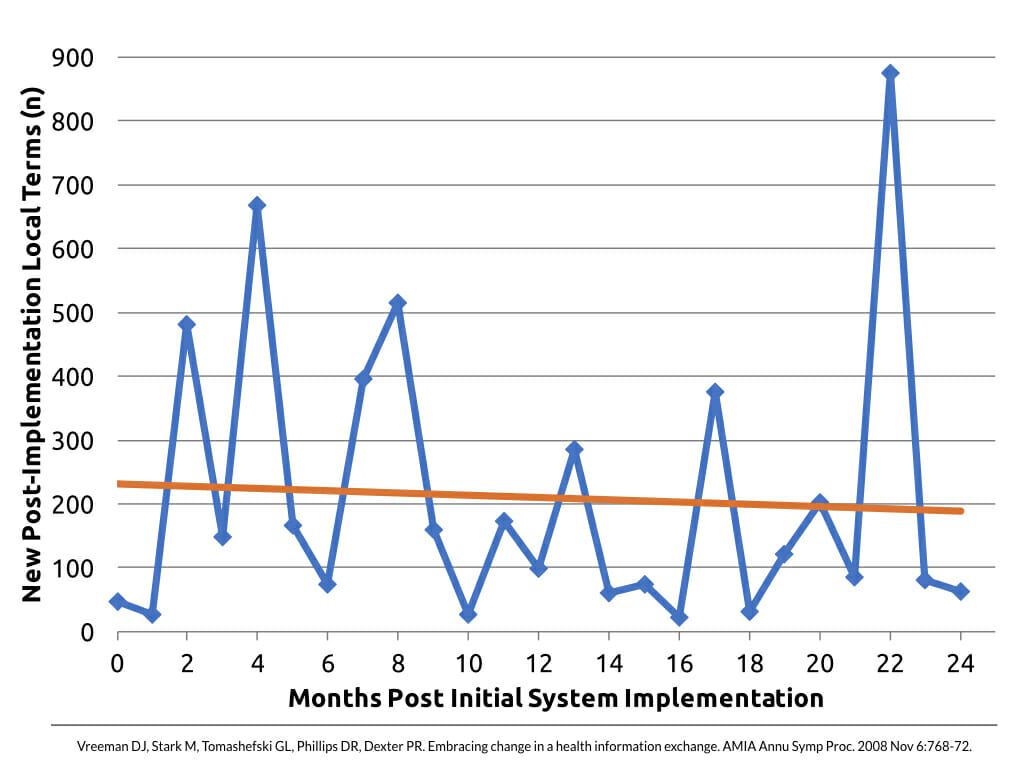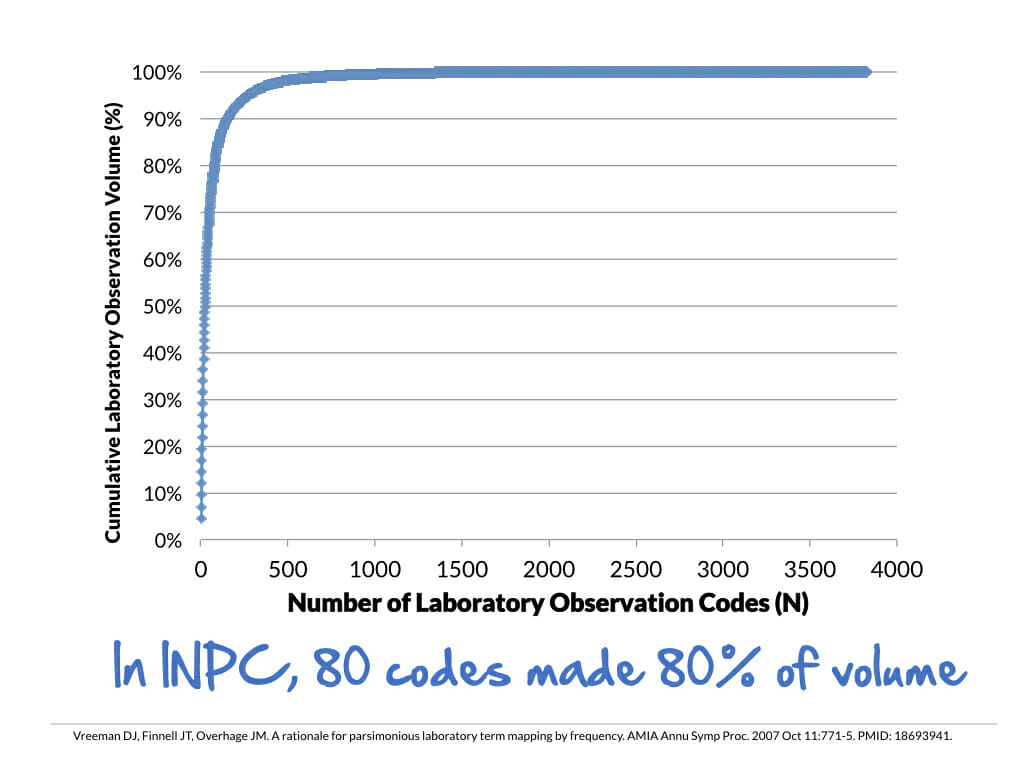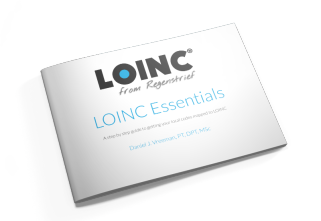Health Information Exchange (HIE) enables health care professionals, patients, and caregivers to electronically access medical information when and where they need it. Within the U.S., there are many factors creating demand for efficient data sharing, including the
Meaningful use requirements, new payment approaches centered around care coordination, and federal financial incentives. Operating a health information exchange has many challenges, but one of the most under-appreciated is the difficulty of managing ever-changing source system vocabularies and their mappings to standards. In my role at Regenstrief with the
Indiana Network for Patient Care (INPC), the longest tenured and most comprehensive health information exchange (HIE) in the U.S, we learned from these challenges through trial and error.
Here I’ll share our best practices for managing terminologies in a health information exchange.
Two big problems
Getting aggregate data from multiple vendor systems across independent healthcare organizations is a holy grail, but there are two big problems related to healthcare data variables that stand in the way.
Variation abounds
No matter what kind of healthcare data you’re interested in, if you look across different systems you’ll see different ways of saying the same thing. It’s like the Tower of Babel. Take radiology procedures for example. The local system codes (e.g. XRSC3V, 123456) and names (e.g. XR SC Joints 3V, Sternoclavicular Joints 3 Views) are different for the same exam across sites. Further, sites vary in what kinds of specificity they distinguish in their codes. Some have different codes based on laterality while others don’t. Some name specific views (e.g. PA, lateral) while others only count views (2 views, 3 views, etc). Some specify the contrast agents precisely while others don’t. Further, many systems invent multiple codes for the same test to distinguish among facilities within their network (despite the fact that there are other ways you can know where an exam was performed).
Of course, the way to overcome this variation and achieve the holy grail of integrated data is to map the local codes codes to standard vocabularies like LOINC, RxNorm, and SNOMED CT. But, all of these differences in source system approaches add up to lots and lots of variation. And the variation becomes more and more of a headache as the number of sites you’re trying to integrate goes up.
You’re never done
It sounds a bit depressing, but it’s true. You have to plan for managing terminology as a journey, not a destination. We studied the rate of change in source system terms within the INPC to help quantify the churn. You see, in the INPC, we would map all of a source system’s local terms before they would go live in the information exchange. But the work didn’t stop there.

Across many INPC institutions, in 2 years after go live we saw half as many new local terms appear as what we started with.
Specifically for radiology procedure terms, it was a bit worse. For radiology terms, in 2 years after go live we saw 71% as many new local terms appear as what we started with.
So, why all the change? Lot’s of factors combine to create this churn. For one, the diagnostic testing performed by the source systems may change over time, necessitating new codes. More commonly though, the source system codes may have changed. Even if the testing services stay the same, the codes can change when institutions by new equipment, change their lab or radiology information systems, merge or acquire other facilities, etc. Further, the standard terminologies themselves evolve over time, and best practice is to keep up with those changes.
Alright, so given these challenges, here are my Top 6 Tips for managing terminology in an HIE.
1. Not all juice is worth the squeeze
In using standard terminologies, the Pareto Principle (a.k.a. the 80/20 rule) applies more often than the idea of the long tail. This rule applies in a couple of ways.
First, a few tests account for most of the result volume. In the INPC, we found that about 80 tests accounted for 80% of the result volume. Second, you’ll likely find that 70% of the tests take 30% of your mapping time (and vice versa).

You’ll also want to remember that not every variable will have a standard code. Within the master files of source systems you’ll often find codes for things that don’t make sense for exchanging with the outside world. They may be billing codes, internal quality control variables, etc. Many of these can be ignored from a mapping perspective.
2. Keep the end in mind
What are your goals? It’s possible that your goals for HIE services could be accomplished with a prioritized set of mappings. (Lab first? Radiology first? Only the top 80%?). But, remember that there are tradeoffs, especially as it relates to secondary uses of the data (research, quality improvement, reporting to public health, etc).
Regardless, you want to be clear on your priorities and goals with HIE so that your terminology approach matches your ambitions.
3. Work smarter, not harder
Because mapping local codes to standards is such a resource-intensive process, we continue to explore and investigate was aspects of it can be automated. While the nirvana of fully automating the mapping process remains not yet possible, there are some low hanging fruit.
For example, within the INPC, we found that 46% of new radiology terms were exact dupes of existing names! These institutions had different codes for the same exam performed at different sites. So, we built a process to bootstrap mappings for similar names from the same institution.
4. Don’t make assumptions
You can run into all kinds of trouble if you make assumptions when mapping. The names of source system terms are so often ambiguous. It’s tempting to make assumptions or “good bets” about what was really meant, but every time we’ve done that we’ve found exceptions that burned us later. Here are some of the ambiguities you might find:
- No indication of whether quantitative or qualitative
- Lab tests with no specimen identified
- Everybody knows this is always done on serum! (Guess what…we had one institution say that when then lab across the street said “everybody knows this is always done on plasma!”)
- Totally generic test names (e.g. Send out test)
- Miscellaneous serology, PCR, culture
The main point here is that you must know the specifics of what the test or variable you are trying to map actually measures. If you guess, at some point you’ll be wrong. Some ways to get the clarity you need is to ask local experts (i.e. the ones who perform the test) or review the package inserts for those tests. In addition, you’ll definitely want to get the reported units of measure for all quantitative tests. Getting your hands on sample results (for both quantitative and qualitative tests) can also be hugely informative and guide the mapping process. All of these things can be difficult to address if you are a downstream recipient of the data, but without them you’ll be shooting in the dark.
One last tip: don’t “throw away” information in local test names by mapping to more general terms from a standard vocabulary like LOINC. It’s tempting because it seems to make the mapping easier, but it’s a one way, lossy data transformation. Once you map to a more general term, you throw away that level of detail. Chances are, you’ll want it at some point. That’s why best practice is to map to the level of granularity you have specified in the local term name. You can always use the attributes of the standard to aggregate more specific codes later.
5. Stay up to date
Because no one standard vocabulary covers all types of health data well, in an HIE you’re typically going to be dealing with multiple standards. The typical “big three” are LOINC, RxNorm, and SNOMED CT. In addition, you may also need to use ICD and CPT.
LOINC is published in new releases twice per year (June and December).
Regenstrief and the LOINC Committee have asserted that best practice is to update to the current version within 90 days of its publication.
I’ve written previously about how to stay up to date with LOINC.
SNOMED CT is also published twice yearly as new releases of the International Version / U.S. Edition. The license from SNOMED International (formerly known as IHTSDO) requires prompt updating:
Within one-hundred and eighty (180) days after the Licensor has notified the Licensee of the release of a new version of the International Release, the Licensee must upgrade the version of the International Release in its own systems and in the Licensee Products to that new version.
RxNorm is published as a new full data set each month. The NLM also publishes weekly updates with newly approved drug information. The weekly updates are meant to be used in conjunction with the most recent full monthly release and any previous weekly updates for that same month. I haven’t found any licensing or best practice guidance about update frequency for RxNorm, but the pharmaceutical space moves fast and frequent updates are needed to stay on top of it.
Last, both CPT and ICD-10-CM are updated yearly, so if your exchanged content includes those codes, you’ll also need to keep up with their release schedules.
6. Try to evolve gracefully
One of the challenges in managing 100s (or thousands) of interfaces is gracefully handling “unmapped” test results that come across. Within the INPC, for example, source systems retain the control and maintenance over their codes. As a result, the HIE frequently sees brand new codes (or even changes to existing codes) appearing in the message streams without advanced warning. Because the codes are novel, there is no established mapping to a vocabulary standard.
To handle this evolving reality, we devised several strategies to deal with incoming unmapped tests in live message streams. First, we let these unmapped tests results flow into the repository so that they were immediately available clinical care. Within the unified virtual patient record, we simply displayed these unmapped tests under “misc test results” in the HIE viewer (called CareWeb in the INPC). Having unmapped tests in the shared repository is not ideal, so you will have to work out a mechanism for updating the mappings after the fact. This could be accomplished through applications or queries that interact with the data through terminology services, rather than, for example, making mapping updates at the raw instance level data in the database.
While we’re on the subject of updating mappings, I strongly recommend building a robust logging and history mechanism to track changes to your HIE terminologies and mappings. This is sort of common sense, but one of the best additions you can make is a field for recording the narrative “why” a change in mapping from one code to the other was made. You might not need it now, but trust me, you’ll thank me in 5-10 years.
At the HIE level, if you care about data quality (who doesn’t?) you’ll also want to be vigilant for changes in the source system coding. Some things to monitor (i.e. build automated tools to detect) are changes to the test name (description), changes to the reported units of measure, and new codes that have the same test name. All of these things can be hints that the source system isn’t following good terminology management practices. Over time, these practices can really muck up your data.
References
{1095885:93PUICIQ};{1095885:VDJ4V4NC};{1095885:G8IF22M9}
nature
default
asc
0
2546
%7B%22status%22%3A%22success%22%2C%22updateneeded%22%3Afalse%2C%22instance%22%3Afalse%2C%22meta%22%3A%7B%22request_last%22%3A850%2C%22request_next%22%3A50%2C%22used_cache%22%3Atrue%7D%2C%22data%22%3A%5B%7B%22key%22%3A%22VVQENPCZ%22%2C%22library%22%3A%7B%22id%22%3A4928801%7D%2C%22meta%22%3A%7B%22creatorSummary%22%3A%22D%5Cu00f6renberg%22%2C%22parsedDate%22%3A%222025-12-08%22%2C%22numChildren%22%3A1%7D%2C%22bib%22%3A%22%26lt%3Bdiv%20class%3D%26quot%3Bcsl-bib-body%26quot%3B%20style%3D%26quot%3Bline-height%3A%202%3B%20%26quot%3B%26gt%3B%5Cn%20%20%26lt%3Bdiv%20class%3D%26quot%3Bcsl-entry%26quot%3B%20style%3D%26quot%3Bclear%3A%20left%3B%20%26quot%3B%26gt%3B%5Cn%20%20%20%20%26lt%3Bdiv%20class%3D%26quot%3Bcsl-left-margin%26quot%3B%20style%3D%26quot%3Bfloat%3A%20left%3B%20padding-right%3A%200.5em%3B%20text-align%3A%20right%3B%20width%3A%201em%3B%26quot%3B%26gt%3B1.%26lt%3B%5C%2Fdiv%26gt%3B%26lt%3Bdiv%20class%3D%26quot%3Bcsl-right-inline%26quot%3B%20style%3D%26quot%3Bmargin%3A%200%20.4em%200%201.5em%3B%26quot%3B%26gt%3BD%26%23xF6%3Brenberg%2C%20J.%20Synoptic%20reporting%26%23x202F%3B%3A%20Chances%20and%20challenges%20for%20secondary%20use%20of%20pathology%20data%20in%20biobanking.%20%26lt%3Bi%26gt%3BPathologie%20%28Heidelb%29%26lt%3B%5C%2Fi%26gt%3B%20%26lt%3Ba%20class%3D%26%23039%3Bzp-DOIURL%26%23039%3B%20href%3D%26%23039%3Bhttps%3A%5C%2F%5C%2Fdoi.org%5C%2F10.1007%5C%2Fs00292-025-01505-y%26%23039%3B%26gt%3Bhttps%3A%5C%2F%5C%2Fdoi.org%5C%2F10.1007%5C%2Fs00292-025-01505-y%26lt%3B%5C%2Fa%26gt%3B%20%282025%29%20doi%3A10.1007%5C%2Fs00292-025-01505-y.%26lt%3B%5C%2Fdiv%26gt%3B%5Cn%20%20%26lt%3B%5C%2Fdiv%26gt%3B%5Cn%26lt%3B%5C%2Fdiv%26gt%3B%22%2C%22data%22%3A%7B%22itemType%22%3A%22journalArticle%22%2C%22title%22%3A%22Synoptic%20reporting%20%3A%20Chances%20and%20challenges%20for%20secondary%20use%20of%20pathology%20data%20in%20biobanking%22%2C%22creators%22%3A%5B%7B%22creatorType%22%3A%22author%22%2C%22firstName%22%3A%22Julian%22%2C%22lastName%22%3A%22D%5Cu00f6renberg%22%7D%5D%2C%22abstractNote%22%3A%22BACKGROUND%3A%20A%5Cu00a0high%20quality%20of%20biosample-associated%20data%20%28DQ%29%20is%20critical%20for%20biomedical%20research.%20Synoptic%20reporting%20%28SR%29%20provides%20the%20chance%20to%20increase%20DQ%20for%20the%20secondary%20use%20of%20data%20from%20surgical%20pathology%20%28SP%29%20in%20Germany.%20Hence%2C%20it%20is%20of%20high%20interest%20for%20biobanks%20that%20data-providing%20SP%20departments%20force%20the%20implementation%20of%20SR.%5CnMATERIALS%20AND%20METHODS%3A%20Synoptic%20reporting%20is%20already%20implemented%20in%20some%20use%20cases%20%5B1%5D.%20Recommendations%20for%20how%20to%20proceed%20are%20available%20%5B2-4%5D.%20Central%20efforts-such%20as%20the%20DGP%27s%20AG%20Semantik-are%20carried%20out%20to%20support%20standardisation%20in%20SR.%5CnRESULTS%3A%20Successful%20use%20of%20SR%20requires%20efforts%20from%20SP%20departments%20as%20well%20as%20from%20biobanks.%20Firstly%2C%20it%20requires%20revision%20of%20processes%20in%20SP%20departments.%20This%20also%20applies%20to%20the%20similar%20tissue%20assessment%20processes%20in%20biobanks.%20Secondly%2C%20biobanks%20need%20to%20prepare%20by%20implementing%20the%20required%20standards%20such%20as%20FHIR%20and%20SNOMED%20CT.%5CnCONCLUSION%3A%20Common%20efforts%20in%20SP%20departments%20and%20biobanks%20are%20required%20to%20facilitate%20the%20utmost%20benefits%20of%20SR%20for%20DQ%20in%20patient%20care%20and%20research.%20Biobanks%20can%20serve%20as%20a%5Cu00a0platform%20for%20SP%20departments%20to%20attempt%20new%20processes%20that%20implement%20SR%20and%20can%20provide%20independent%20feedback%20on%20DQ%20in%20SP%20departments.%22%2C%22date%22%3A%222025-12-08%22%2C%22language%22%3A%22eng%22%2C%22DOI%22%3A%2210.1007%5C%2Fs00292-025-01505-y%22%2C%22ISSN%22%3A%222731-7196%22%2C%22url%22%3A%22%22%2C%22collections%22%3A%5B%227MQ854T6%22%5D%2C%22dateModified%22%3A%222025-12-14T12%3A03%3A49Z%22%7D%7D%2C%7B%22key%22%3A%22J34WP9LQ%22%2C%22library%22%3A%7B%22id%22%3A4928801%7D%2C%22meta%22%3A%7B%22creatorSummary%22%3A%22Hornback%20et%20al.%22%2C%22parsedDate%22%3A%222025-12-10%22%2C%22numChildren%22%3A1%7D%2C%22bib%22%3A%22%26lt%3Bdiv%20class%3D%26quot%3Bcsl-bib-body%26quot%3B%20style%3D%26quot%3Bline-height%3A%202%3B%20%26quot%3B%26gt%3B%5Cn%20%20%26lt%3Bdiv%20class%3D%26quot%3Bcsl-entry%26quot%3B%20style%3D%26quot%3Bclear%3A%20left%3B%20%26quot%3B%26gt%3B%5Cn%20%20%20%20%26lt%3Bdiv%20class%3D%26quot%3Bcsl-left-margin%26quot%3B%20style%3D%26quot%3Bfloat%3A%20left%3B%20padding-right%3A%200.5em%3B%20text-align%3A%20right%3B%20width%3A%201em%3B%26quot%3B%26gt%3B1.%26lt%3B%5C%2Fdiv%26gt%3B%26lt%3Bdiv%20class%3D%26quot%3Bcsl-right-inline%26quot%3B%20style%3D%26quot%3Bmargin%3A%200%20.4em%200%201.5em%3B%26quot%3B%26gt%3BHornback%2C%20A.%20%26lt%3Bi%26gt%3Bet%20al.%26lt%3B%5C%2Fi%26gt%3B%20FHIR%20in%20Focus%3A%20Enabling%20Biomedical%20Data%20Harmonization%20for%20Intelligent%20Healthcare%20Systems.%20%26lt%3Bi%26gt%3BIEEE%20Rev%20Biomed%20Eng%26lt%3B%5C%2Fi%26gt%3B%20%26lt%3Bb%26gt%3BPP%26lt%3B%5C%2Fb%26gt%3B%2C%20%282025%29.%26lt%3B%5C%2Fdiv%26gt%3B%5Cn%20%20%26lt%3B%5C%2Fdiv%26gt%3B%5Cn%26lt%3B%5C%2Fdiv%26gt%3B%22%2C%22data%22%3A%7B%22itemType%22%3A%22journalArticle%22%2C%22title%22%3A%22FHIR%20in%20Focus%3A%20Enabling%20Biomedical%20Data%20Harmonization%20for%20Intelligent%20Healthcare%20Systems%22%2C%22creators%22%3A%5B%7B%22creatorType%22%3A%22author%22%2C%22firstName%22%3A%22Andrew%22%2C%22lastName%22%3A%22Hornback%22%7D%2C%7B%22creatorType%22%3A%22author%22%2C%22firstName%22%3A%22Benoit%22%2C%22lastName%22%3A%22Marteau%22%7D%2C%7B%22creatorType%22%3A%22author%22%2C%22firstName%22%3A%22Shaun%20Q.%20Y.%22%2C%22lastName%22%3A%22Tan%22%7D%2C%7B%22creatorType%22%3A%22author%22%2C%22firstName%22%3A%22Kyungbeom%22%2C%22lastName%22%3A%22Kim%22%7D%2C%7B%22creatorType%22%3A%22author%22%2C%22firstName%22%3A%22Oankar%22%2C%22lastName%22%3A%22Patil%22%7D%2C%7B%22creatorType%22%3A%22author%22%2C%22firstName%22%3A%22Joshua%22%2C%22lastName%22%3A%22Traynelis%22%7D%2C%7B%22creatorType%22%3A%22author%22%2C%22firstName%22%3A%22Yuanda%22%2C%22lastName%22%3A%22Zhu%22%7D%2C%7B%22creatorType%22%3A%22author%22%2C%22firstName%22%3A%22Felipe%22%2C%22lastName%22%3A%22Giuste%22%7D%2C%7B%22creatorType%22%3A%22author%22%2C%22firstName%22%3A%22May%20D.%22%2C%22lastName%22%3A%22Wang%22%7D%5D%2C%22abstractNote%22%3A%22Fast%20Healthcare%20Interoperability%20Resources%20%28FHIR%29%2C%20developed%20by%20Health%20Level%20Seven%20International%20%28HL7%29%2C%20has%20emerged%20as%20the%20leading%20healthcare%20data%20standard%20to%20address%20persistent%20barriers%20in%20interoperability%2C%20fragmented%20exchange%2C%20and%20inconsistent%20data%20harmonization.%20As%20health%20systems%20worldwide%20undergo%20digital%20transformation%2C%20FHIR%20offers%20a%20flexible%20framework%20for%20integrating%20electronic%20health%20records%2C%20analytics%20platforms%2C%20and%20decision-support%20tools.%20Its%20growth%20has%20been%20accelerated%20by%20policy%20mandates%20such%20as%20the%2021st%20Century%20Cures%20Act%2C%20as%20well%20as%20the%20availability%20of%20application%20programming%20interfaces%20%28APIs%29%2C%20software%20development%20kits%20%28SDKs%29%2C%20and%20web%20standards.%20Globally%2C%20FHIR%20has%20been%20adopted%20or%20piloted%20by%20national%20health%20systems%20in%20the%20United%20States%2C%20United%20Kingdom%2C%20Canada%2C%20and%20Australia%2C%20and%20incorporated%20into%20World%20Health%20Organization%20data%20initiatives%2C%20underscoring%20its%20role%20in%20global%20digital%20health%20strategy.%20Documented%20outcomes%20of%20this%20review%20include%20comprehensive%20mapping%20of%20FHIR%20applications%20across%20clinical%2C%20research%2C%20and%20public%20health%20domains%3B%20identification%20of%20adoption%20barriers%20and%20enablers%3B%20insights%20into%20integration%20with%20generative%20AI%20and%20large%20language%20models%20for%20predictive%20modeling%2C%20automated%20documentation%2C%20and%20decision%20support%3B%20and%20guidance%20for%20future%20innovations%20such%20as%20blockchain-enabled%20infrastructure%20and%20cloud-native%20scalability.%20Nonetheless%2C%20challenges%20remain%2C%20including%20uneven%20implementation%2C%20workforce%20training%20gaps%2C%20scalability%20limitations%2C%20and%20unresolved%20concerns%20around%20privacy%2C%20security%2C%20and%20regulatory%20compliance.%20This%20synthesis%20provides%20actionable%20insights%20for%20providers%2C%20researchers%2C%20policymakers%2C%20and%20developers%20to%20advance%20global%20health%20interoperability.%22%2C%22date%22%3A%222025-12-10%22%2C%22language%22%3A%22eng%22%2C%22DOI%22%3A%2210.1109%5C%2FRBME.2025.3632213%22%2C%22ISSN%22%3A%221941-1189%22%2C%22url%22%3A%22%22%2C%22collections%22%3A%5B%227MQ854T6%22%5D%2C%22dateModified%22%3A%222025-12-14T12%3A03%3A38Z%22%7D%7D%2C%7B%22key%22%3A%22YHLGBI5E%22%2C%22library%22%3A%7B%22id%22%3A4928801%7D%2C%22meta%22%3A%7B%22creatorSummary%22%3A%22Marques%20et%20al.%22%2C%22parsedDate%22%3A%222025-11-21%22%2C%22numChildren%22%3A1%7D%2C%22bib%22%3A%22%26lt%3Bdiv%20class%3D%26quot%3Bcsl-bib-body%26quot%3B%20style%3D%26quot%3Bline-height%3A%202%3B%20%26quot%3B%26gt%3B%5Cn%20%20%26lt%3Bdiv%20class%3D%26quot%3Bcsl-entry%26quot%3B%20style%3D%26quot%3Bclear%3A%20left%3B%20%26quot%3B%26gt%3B%5Cn%20%20%20%20%26lt%3Bdiv%20class%3D%26quot%3Bcsl-left-margin%26quot%3B%20style%3D%26quot%3Bfloat%3A%20left%3B%20padding-right%3A%200.5em%3B%20text-align%3A%20right%3B%20width%3A%201em%3B%26quot%3B%26gt%3B1.%26lt%3B%5C%2Fdiv%26gt%3B%26lt%3Bdiv%20class%3D%26quot%3Bcsl-right-inline%26quot%3B%20style%3D%26quot%3Bmargin%3A%200%20.4em%200%201.5em%3B%26quot%3B%26gt%3BMarques%2C%20M.%20%26lt%3Bi%26gt%3Bet%20al.%26lt%3B%5C%2Fi%26gt%3B%20The%20B-Health%20Box%3A%20A%20Standards-Based%20Fog%20IoT%20Gateway%20for%20Interoperable%20Health%20and%20Wellbeing%20Data%20Collection.%20%26lt%3Bi%26gt%3BSensors%20%28Basel%29%26lt%3B%5C%2Fi%26gt%3B%20%26lt%3Bb%26gt%3B25%26lt%3B%5C%2Fb%26gt%3B%2C%207116%20%282025%29.%26lt%3B%5C%2Fdiv%26gt%3B%5Cn%20%20%26lt%3B%5C%2Fdiv%26gt%3B%5Cn%26lt%3B%5C%2Fdiv%26gt%3B%22%2C%22data%22%3A%7B%22itemType%22%3A%22journalArticle%22%2C%22title%22%3A%22The%20B-Health%20Box%3A%20A%20Standards-Based%20Fog%20IoT%20Gateway%20for%20Interoperable%20Health%20and%20Wellbeing%20Data%20Collection%22%2C%22creators%22%3A%5B%7B%22creatorType%22%3A%22author%22%2C%22firstName%22%3A%22Maria%22%2C%22lastName%22%3A%22Marques%22%7D%2C%7B%22creatorType%22%3A%22author%22%2C%22firstName%22%3A%22Vasco%22%2C%22lastName%22%3A%22Delgado-Gomes%22%7D%2C%7B%22creatorType%22%3A%22author%22%2C%22firstName%22%3A%22F%5Cu00e1bio%22%2C%22lastName%22%3A%22Janu%5Cu00e1rio%22%7D%2C%7B%22creatorType%22%3A%22author%22%2C%22firstName%22%3A%22Carlos%22%2C%22lastName%22%3A%22Lopes%22%7D%2C%7B%22creatorType%22%3A%22author%22%2C%22firstName%22%3A%22Ricardo%22%2C%22lastName%22%3A%22Jardim-Goncalves%22%7D%2C%7B%22creatorType%22%3A%22author%22%2C%22firstName%22%3A%22Carlos%22%2C%22lastName%22%3A%22Agostinho%22%7D%5D%2C%22abstractNote%22%3A%22In%20recent%20years%2C%20healthcare%20is%20evolving%20to%20meet%20the%20needs%20of%20a%20growing%20and%20ageing%20population.%20To%20support%20better%20and%20more%20reliable%20care%2C%20a%20comprehensive%20and%20up-to-date%20Personal%20Health%20Record%20%28PHR%29%20is%20essential.%20Ideally%2C%20the%20PHR%20should%20contain%20all%20health-related%20information%20about%20an%20individual%20and%20be%20available%20for%20sharing%20with%20healthcare%20institutions.%20However%2C%20due%20to%20interoperability%20issues%20of%20the%20medical%20and%20fitness%20devices%2C%20most%20of%20the%20times%2C%20the%20PHR%20only%20contains%20the%20same%20information%20as%20the%20patient%20Electronic%20Health%20Record%20%28EHR%29.%20This%20results%20in%20lack%20of%20health-related%20information%20%28e.g.%2C%20physical%20activity%2C%20working%20patterns%29%20essential%20to%20address%20medical%20conditions%2C%20support%20prescriptions%2C%20and%20treatment%20follow-up.%20This%20paper%20introduces%20the%20B-Health%20IoT%20Box%2C%20a%20fog%20IoT%20computing%20framework%20for%20eHealth%20interoperability%20and%20data%20collection%20that%20enables%20seamless%2C%20secure%20integration%20of%20health%20and%20contextual%20data%20into%20interoperable%20health%20records.%20The%20system%20was%20deployed%20in%20real-world%20settings%20involving%20over%204500%20users%2C%20successfully%20collecting%20and%20transmitting%20more%20than%201.5%20million%20datasets.%20The%20validation%20shown%20that%20data%20was%20collected%2C%20harmonized%2C%20and%20properly%20stored%20in%20different%20eHealth%20platforms%2C%20enriching%20data%20from%20personal%20EHR%20with%20mobile%20and%20wearable%20sensors%20data.%20The%20solution%20supports%20real-time%20and%20near%20real-time%20data%20collection%2C%20fast%20prototyping%2C%20and%20secure%20cloud%20integration%2C%20offering%20a%20modular%2C%20standards-compliant%20gateway%20for%20digital%20health%20ecosystems.%20The%20health%20and%20health-related%20data%20is%20available%20in%20FHIR%20format%20enabling%20interoperable%20eHealth%20ecosystems%2C%20and%20better%20equality%20of%20access%20to%20health%20and%20care%20services.%22%2C%22date%22%3A%222025-11-21%22%2C%22language%22%3A%22eng%22%2C%22DOI%22%3A%2210.3390%5C%2Fs25237116%22%2C%22ISSN%22%3A%221424-8220%22%2C%22url%22%3A%22%22%2C%22collections%22%3A%5B%227MQ854T6%22%5D%2C%22dateModified%22%3A%222025-12-14T12%3A03%3A31Z%22%7D%7D%2C%7B%22key%22%3A%228JQRUDM4%22%2C%22library%22%3A%7B%22id%22%3A4928801%7D%2C%22meta%22%3A%7B%22creatorSummary%22%3A%22Hsieh%20et%20al.%22%2C%22parsedDate%22%3A%222025%22%2C%22numChildren%22%3A1%7D%2C%22bib%22%3A%22%26lt%3Bdiv%20class%3D%26quot%3Bcsl-bib-body%26quot%3B%20style%3D%26quot%3Bline-height%3A%202%3B%20%26quot%3B%26gt%3B%5Cn%20%20%26lt%3Bdiv%20class%3D%26quot%3Bcsl-entry%26quot%3B%20style%3D%26quot%3Bclear%3A%20left%3B%20%26quot%3B%26gt%3B%5Cn%20%20%20%20%26lt%3Bdiv%20class%3D%26quot%3Bcsl-left-margin%26quot%3B%20style%3D%26quot%3Bfloat%3A%20left%3B%20padding-right%3A%200.5em%3B%20text-align%3A%20right%3B%20width%3A%201em%3B%26quot%3B%26gt%3B1.%26lt%3B%5C%2Fdiv%26gt%3B%26lt%3Bdiv%20class%3D%26quot%3Bcsl-right-inline%26quot%3B%20style%3D%26quot%3Bmargin%3A%200%20.4em%200%201.5em%3B%26quot%3B%26gt%3BHsieh%2C%20C.-Y.%20%26lt%3Bi%26gt%3Bet%20al.%26lt%3B%5C%2Fi%26gt%3B%20Taiwan%26%23x2019%3Bs%20National%20Health%20Insurance%20Research%20Database%20%28NHIRD%29%3A%20in%20the%20Era%20of%20Artificial%20Intelligence%2C%20Causal%20Inference%2C%20and%20Data%20Security.%20%26lt%3Bi%26gt%3BClin%20Epidemiol%26lt%3B%5C%2Fi%26gt%3B%20%26lt%3Bb%26gt%3B17%26lt%3B%5C%2Fb%26gt%3B%2C%20967%26%23x2013%3B981%20%282025%29.%26lt%3B%5C%2Fdiv%26gt%3B%5Cn%20%20%26lt%3B%5C%2Fdiv%26gt%3B%5Cn%26lt%3B%5C%2Fdiv%26gt%3B%22%2C%22data%22%3A%7B%22itemType%22%3A%22journalArticle%22%2C%22title%22%3A%22Taiwan%27s%20National%20Health%20Insurance%20Research%20Database%20%28NHIRD%29%3A%20in%20the%20Era%20of%20Artificial%20Intelligence%2C%20Causal%20Inference%2C%20and%20Data%20Security%22%2C%22creators%22%3A%5B%7B%22creatorType%22%3A%22author%22%2C%22firstName%22%3A%22Cheng-Yang%22%2C%22lastName%22%3A%22Hsieh%22%7D%2C%7B%22creatorType%22%3A%22author%22%2C%22firstName%22%3A%22Shih-Chieh%22%2C%22lastName%22%3A%22Shao%22%7D%2C%7B%22creatorType%22%3A%22author%22%2C%22firstName%22%3A%22Sheng-Feng%22%2C%22lastName%22%3A%22Sung%22%7D%2C%7B%22creatorType%22%3A%22author%22%2C%22firstName%22%3A%22Miyuki%20Hsing-Chun%22%2C%22lastName%22%3A%22Hsieh%22%7D%2C%7B%22creatorType%22%3A%22author%22%2C%22firstName%22%3A%22Daniel%20Hsiang-Te%22%2C%22lastName%22%3A%22Tsai%22%7D%2C%7B%22creatorType%22%3A%22author%22%2C%22firstName%22%3A%22Swu-Jane%22%2C%22lastName%22%3A%22Lin%22%7D%2C%7B%22creatorType%22%3A%22author%22%2C%22firstName%22%3A%22Edward%20Chia-Cheng%22%2C%22lastName%22%3A%22Lai%22%7D%5D%2C%22abstractNote%22%3A%22BACKGROUND%3A%20Taiwan%26%23039%3Bs%20National%20Health%20Insurance%20Research%20Database%20%28NHIRD%29%20has%20evolved%20into%20a%20cornerstone%20of%20real-world%20evidence%20generation.%20As%20Taiwan%26%23039%3Bs%20National%20Health%20Insurance%20program%20reaches%20its%2030th%20anniversary%2C%20a%20comprehensive%20reassessment%20of%20the%20NHIRD%26%23039%3Bs%20development%2C%20challenges%20and%20future%20directions%20is%20warranted.%5CnOBJECTIVE%3A%20To%20provide%20an%20updated%20review%20of%20the%20NHIRD.%5CnMETHODS%3A%20We%20conducted%20a%20narrative%20review%20of%20Taiwan%26%23039%3Bs%20NHIRD%2C%20synthesizing%20published%20studies%2C%20government%20reports%2C%20and%20policy%20documents%20from%202019%20through%202024.%20We%20summarized%20developments%20related%20to%20database%20infrastructure%2C%20data%20collection%2C%20validation%20studies%2C%20linkage%20strategies%2C%20governance%20reforms%20and%20interoperability%20initiatives%2C%20with%20a%20particular%20focus%20on%20their%20implications%20for%20real-world%20evidence%20generation%20and%20AI-driven%20research.%5CnRESULTS%3A%20The%20NHIRD%20has%20additionally%20incorporated%20structured%20laboratory%20results%20and%20medical%20imaging%20data%2C%20significantly%20broadening%20its%20research%20capabilities.%20Validation%20studies%20have%20demonstrated%20the%20reliability%20of%20International%20Classification%20of%20Diseases%2C%2010th%20Revision%2C%20Clinical%20Modification%20codes%20across%20various%20conditions%2C%20reinforcing%20the%20database%26%23039%3Bs%20applicability%20for%20epidemiological%20research.%20Integration%20efforts%20with%20national%20registries%2C%20surveys%20and%20electronic%20medical%20records%20have%20further%20enhanced%20the%20depth%20and%20accuracy%20of%20clinical%20outcome%20measurements.%20Nonetheless%2C%20critical%20challenges%20persist%2C%20including%20data%20standardization%20inconsistencies%2C%20cybersecurity%20vulnerabilities%2C%20and%20heightened%20scrutiny%20following%20constitutional%20court%20rulings%20on%20data%20governance%20and%20privacy%20rights.%20In%20response%2C%20Taiwan%26%23039%3Bs%20Ministry%20of%20Health%20and%20Welfare%20has%20launched%20initiatives%20to%20address%20these%20concerns%2C%20notably%20through%20the%20development%20of%20a%20Fast%20Healthcare%20Interoperability%20Resources%20%28FHIR%29-based%20data%20infrastructure%20aimed%20at%20improving%20interoperability%2C%20data%20security%2C%20and%20artificial%20intelligence%20%28AI%29-readiness%20to%20balance%20ethical%20governance%20with%20scientific%20innovation.%5CnCONCLUSION%3A%20The%20NHIRD%26%23039%3Bs%20transformation%20over%20three%20decades%20underscores%20the%20importance%20of%20continuous%20investment%20in%20data%20quality%2C%20privacy%20protection%2C%20and%20interoperability.%20With%20sustained%20reforms%2C%20the%20NHIRD%20will%20be%20poised%20to%20remain%20a%20leading%20resource%20for%20real-world%20evidence%20generation%20and%20to%20contribute%20meaningfully%20to%20global%20health%20and%20digital%20medicine.%22%2C%22date%22%3A%222025%22%2C%22language%22%3A%22eng%22%2C%22DOI%22%3A%2210.2147%5C%2FCLEP.S553894%22%2C%22ISSN%22%3A%221179-1349%22%2C%22url%22%3A%22%22%2C%22collections%22%3A%5B%227MQ854T6%22%5D%2C%22dateModified%22%3A%222025-12-07T12%3A03%3A23Z%22%7D%7D%2C%7B%22key%22%3A%22EP78JSXJ%22%2C%22library%22%3A%7B%22id%22%3A4928801%7D%2C%22meta%22%3A%7B%22creatorSummary%22%3A%22Mantri%20et%20al.%22%2C%22parsedDate%22%3A%222025-12-02%22%2C%22numChildren%22%3A1%7D%2C%22bib%22%3A%22%26lt%3Bdiv%20class%3D%26quot%3Bcsl-bib-body%26quot%3B%20style%3D%26quot%3Bline-height%3A%202%3B%20%26quot%3B%26gt%3B%5Cn%20%20%26lt%3Bdiv%20class%3D%26quot%3Bcsl-entry%26quot%3B%20style%3D%26quot%3Bclear%3A%20left%3B%20%26quot%3B%26gt%3B%5Cn%20%20%20%20%26lt%3Bdiv%20class%3D%26quot%3Bcsl-left-margin%26quot%3B%20style%3D%26quot%3Bfloat%3A%20left%3B%20padding-right%3A%200.5em%3B%20text-align%3A%20right%3B%20width%3A%201em%3B%26quot%3B%26gt%3B1.%26lt%3B%5C%2Fdiv%26gt%3B%26lt%3Bdiv%20class%3D%26quot%3Bcsl-right-inline%26quot%3B%20style%3D%26quot%3Bmargin%3A%200%20.4em%200%201.5em%3B%26quot%3B%26gt%3BMantri%2C%20M.%2C%20Satokar%2C%20S.%2C%20Tambe%2C%20P.%20%26amp%3B%20Bhutad%2C%20C.%20FHIR%20Standard-Based%20Oncology%20Data%20Model%20for%20Cancer%20Screening%3A%20Design%20and%20Implementation%20Study.%20%26lt%3Bi%26gt%3BJMIR%20Cancer%26lt%3B%5C%2Fi%26gt%3B%20%26lt%3Bb%26gt%3B11%26lt%3B%5C%2Fb%26gt%3B%2C%20e79011%20%282025%29.%26lt%3B%5C%2Fdiv%26gt%3B%5Cn%20%20%26lt%3B%5C%2Fdiv%26gt%3B%5Cn%26lt%3B%5C%2Fdiv%26gt%3B%22%2C%22data%22%3A%7B%22itemType%22%3A%22journalArticle%22%2C%22title%22%3A%22FHIR%20Standard-Based%20Oncology%20Data%20Model%20for%20Cancer%20Screening%3A%20Design%20and%20Implementation%20Study%22%2C%22creators%22%3A%5B%7B%22creatorType%22%3A%22author%22%2C%22firstName%22%3A%22Manisha%22%2C%22lastName%22%3A%22Mantri%22%7D%2C%7B%22creatorType%22%3A%22author%22%2C%22firstName%22%3A%22Sayali%22%2C%22lastName%22%3A%22Satokar%22%7D%2C%7B%22creatorType%22%3A%22author%22%2C%22firstName%22%3A%22Pritam%22%2C%22lastName%22%3A%22Tambe%22%7D%2C%7B%22creatorType%22%3A%22author%22%2C%22firstName%22%3A%22Cheenmaya%22%2C%22lastName%22%3A%22Bhutad%22%7D%5D%2C%22abstractNote%22%3A%22BACKGROUND%3A%20Cancer%20is%20a%20leading%20cause%20of%20death%20worldwide.%20Early%20detection%20through%20screening%2C%20diagnosis%2C%20and%20effective%20management%20can%20reduce%20cancer%20mortality.%20Risk%20assessment%20is%20crucial%20for%20improving%20outcomes%20by%20identifying%20high-risk%20individuals%20based%20on%20family%20history%2C%20genetics%2C%20lifestyle%2C%20and%20environment.%20Such%20targeted%20screening%20enhances%20accuracy%20and%20resource%20efficiency.%20However%2C%20the%20complex%20nature%20of%20oncology%20data-which%20includes%20clinical%20observations%2C%20lab%20results%2C%20radiology%20images%2C%20treatment%20regimens%2C%20and%20genetic%20information-presents%20significant%20challenges%20for%20data%20interoperability%20and%20exchange.%5CnOBJECTIVE%3A%20This%20study%20proposes%20an%20oncology%20data%20model%20%28ODM%29%20based%20on%20the%20Fast%20Healthcare%20Interoperability%20Resources%20%28FHIR%29%20standard%20to%20facilitate%20the%20capturing%2C%20sharing%2C%20and%20processing%20of%20oncology%20data%20across%20various%20cancer%20care%20stages.%20We%20particularly%20focused%20on%20screening%20and%20risk%20assessment%20for%205%20cancers%3A%20breast%2C%20cervical%2C%20esophageal%2C%20lung%2C%20and%20oral%2C%20within%20the%20Meghalaya%20Fourth%20Industrial%20Revolution%20for%20Sustainable%20Transformation%20Cancer%20Care%20pilot%20project%20in%20India.%5CnMETHODS%3A%20The%20ODM%20incorporates%20data%20elements%20from%20a%20cancer%20patient%26%23039%3Bs%20journey%20across%205%20phases%3A%20encounter%2C%20risk%20assessment%2C%20clinical%20investigation%2C%20treatment%2C%20and%20outcome.%20Essential%20oncology%20data%20elements%20were%20modeled%20using%20the%20Health%20Level%207%20FHIR%20Revision%204%20standard.%20Custom%20FHIR%20profiles%20were%20developed%20for%20cancer-specific%20use%20cases%2C%20with%20terminology%20mapped%20to%20Systematized%20Nomenclature%20of%20Medicine-Clinical%20Terms%2C%20Logical%20Observation%20Identifiers%20Names%20and%20Codes%2C%20and%20the%20International%20Classification%20of%20Diseases%2C%2010th%20Revision.%20The%20implementation%20guide%20%28IG%29%20was%20created%20using%20FHIR%20Shorthand%2C%20SUSHI%20Unshortens%20Short%20Hand%20Inputs%2C%20and%20the%20Health%20Level%207%20IG%20Publisher.%20Technical%20and%20clinical%20validation%20and%20a%20stakeholder%20usability%20assessment%20were%20conducted%20using%20a%20demonstration%20tool%20designed%20for%20implementer%20training%20and%20adoption.%5CnRESULTS%3A%20The%20data%20model%20enhances%20interoperability%20across%20the%20cancer%20care%20continuum%2C%20from%20screening%20to%20treatment.%20The%20resulting%20IG%20includes%2025%20oncology-specific%20resource%20profiles%20and%2050%20standardized%20terminology%20value%20sets%20that%20support%20both%20semantic%20and%20syntactic%20interoperability.%20Central%20to%20the%20model%20are%20the%20FHIR%20Questionnaire%20and%20QuestionnaireResponse%20resources%2C%20customized%20for%20structured%20data%20collection%20in%20clinical%20and%20community%20settings%2C%20supporting%20cancer%20screening%20workflows.%20Technical%20validation%20yielded%20FHIR%20conformance%20and%20terminology%20binding%2C%20while%20clinical%20validation%20by%20oncologists%20and%20public%20health%20experts%20confirmed%20the%20usability%20and%20relevance%20of%205%20screening%20questionnaires.%20The%20demonstration%20tool%20promoted%20stakeholder%20engagement%20and%20practical%20evaluation%20of%20the%20FHIR%20profiles.%5CnCONCLUSIONS%3A%20The%20FHIR-based%20ODM%20offers%20a%20unified%20framework%20for%20structured%2C%20interoperable%20cancer%20data%20exchange%20from%20screening%20to%20after%20treatment.%20This%20study%20marks%20the%20first%20comprehensive%20Indian%20initiative%20to%20apply%20FHIR%20standards%20for%20oncology%20screening%20and%20risk%20assessment.%20Integrating%20with%20national%20digital%20health%20systems%2C%20like%20the%20Ayushman%20Bharat%20Digital%20Mission%2C%20can%20ensure%20consistent%20data%20sharing%20across%20screening%20programs%2C%20hospitals%2C%20and%20registries.%20Future%20work%20will%20focus%20on%20real-world%20model%20deployment%2C%20evaluation%20in%20multiple%20districts%2C%20expanding%20to%20treatment%20and%20survivorship%20data%2C%20and%20promoting%20national%20adoption%20to%20inform%20cancer%20policy%2C%20research%2C%20and%20precision%20oncology%20efforts.%22%2C%22date%22%3A%222025-12-02%22%2C%22language%22%3A%22eng%22%2C%22DOI%22%3A%2210.2196%5C%2F79011%22%2C%22ISSN%22%3A%222369-1999%22%2C%22url%22%3A%22%22%2C%22collections%22%3A%5B%227MQ854T6%22%5D%2C%22dateModified%22%3A%222025-12-07T12%3A03%3A15Z%22%7D%7D%2C%7B%22key%22%3A%22F6V9FP33%22%2C%22library%22%3A%7B%22id%22%3A4928801%7D%2C%22meta%22%3A%7B%22creatorSummary%22%3A%22Casanova%20et%20al.%22%2C%22parsedDate%22%3A%222025%22%2C%22numChildren%22%3A1%7D%2C%22bib%22%3A%22%26lt%3Bdiv%20class%3D%26quot%3Bcsl-bib-body%26quot%3B%20style%3D%26quot%3Bline-height%3A%202%3B%20%26quot%3B%26gt%3B%5Cn%20%20%26lt%3Bdiv%20class%3D%26quot%3Bcsl-entry%26quot%3B%20style%3D%26quot%3Bclear%3A%20left%3B%20%26quot%3B%26gt%3B%5Cn%20%20%20%20%26lt%3Bdiv%20class%3D%26quot%3Bcsl-left-margin%26quot%3B%20style%3D%26quot%3Bfloat%3A%20left%3B%20padding-right%3A%200.5em%3B%20text-align%3A%20right%3B%20width%3A%201em%3B%26quot%3B%26gt%3B1.%26lt%3B%5C%2Fdiv%26gt%3B%26lt%3Bdiv%20class%3D%26quot%3Bcsl-right-inline%26quot%3B%20style%3D%26quot%3Bmargin%3A%200%20.4em%200%201.5em%3B%26quot%3B%26gt%3BCasanova%2C%20R.%2C%20Villa-Garzon%2C%20F.%20A.%20%26amp%3B%20Branch-Bedoya%2C%20J.%20W.%20Architectural%20patterns%20for%20health%20information%20systems%3A%20a%20systematic%20review.%20%26lt%3Bi%26gt%3BFront%20Digit%20Health%26lt%3B%5C%2Fi%26gt%3B%20%26lt%3Bb%26gt%3B7%26lt%3B%5C%2Fb%26gt%3B%2C%201694839%20%282025%29.%26lt%3B%5C%2Fdiv%26gt%3B%5Cn%20%20%26lt%3B%5C%2Fdiv%26gt%3B%5Cn%26lt%3B%5C%2Fdiv%26gt%3B%22%2C%22data%22%3A%7B%22itemType%22%3A%22journalArticle%22%2C%22title%22%3A%22Architectural%20patterns%20for%20health%20information%20systems%3A%20a%20systematic%20review%22%2C%22creators%22%3A%5B%7B%22creatorType%22%3A%22author%22%2C%22firstName%22%3A%22Rene%22%2C%22lastName%22%3A%22Casanova%22%7D%2C%7B%22creatorType%22%3A%22author%22%2C%22firstName%22%3A%22Fernan%20A.%22%2C%22lastName%22%3A%22Villa-Garzon%22%7D%2C%7B%22creatorType%22%3A%22author%22%2C%22firstName%22%3A%22John%20W.%22%2C%22lastName%22%3A%22Branch-Bedoya%22%7D%5D%2C%22abstractNote%22%3A%22BACKGROUND%3A%20Health%20information%20systems%20%28HIS%29%20are%20critical%20for%20digital%20health%20transformation%2C%20yet%20fragmentation%20and%20poor%20interoperability%20adoption%20remains%20a%20major%20challenge.%5CnOBJECTIVES%3A%20This%20study%20systematically%20reviews%20architectural%20patterns%20used%20in%20HIS%20and%20evaluates%20their%20alignment%20with%20ecosystem-level%20requirements.%5CnMETHODS%3A%20Following%20PRISMA%202020%20guidelines%2C%20a%20systematic%20literature%20review%20was%20conducted%20across%20Scopus%2C%20IEEE%20Xplore%2C%20PubMed%2C%20and%20Web%20of%20Science%20%282020-2025%29.%20Eligible%20studies%20described%2C%20evaluated%2C%20or%20proposed%20HIS%20solutions.%5CnRESULTS%3A%20From%20an%20initial%20set%20of%20304%20records%2C%2089%20met%20the%20inclusion%20criteria.%20Service-based%20and%20decentralized%5C%2Fdistributed%20ledger%20architectures%20were%20predominant%2C%20with%20emerging%20models%20integrating%20edge%20computing%20and%20modular%20design.%20FHIR-based%20contracts%20are%20found%20as%20stabilizers%20of%20interfaces%2C%20enabling%20validation%20and%20reducing%20integration%20costs.%20However%2C%20gaps%20persist%20in%20cross-border%20care%2C%20sustainability%2C%20and%20artificial%20intelligence%20integration.%5CnCONCLUSION%3A%20While%20microservices%20dominate%20current%20HIS%20architectures%2C%20achieving%20resilient%2C%20interoperable%20ecosystems%20requires%20greater%20architectural%20diversity%20and%20intersectoral%20collaboration.%22%2C%22date%22%3A%222025%22%2C%22language%22%3A%22eng%22%2C%22DOI%22%3A%2210.3389%5C%2Ffdgth.2025.1694839%22%2C%22ISSN%22%3A%222673-253X%22%2C%22url%22%3A%22%22%2C%22collections%22%3A%5B%227MQ854T6%22%5D%2C%22dateModified%22%3A%222025-12-07T12%3A02%3A57Z%22%7D%7D%2C%7B%22key%22%3A%22LFTLWE2Z%22%2C%22library%22%3A%7B%22id%22%3A4928801%7D%2C%22meta%22%3A%7B%22creatorSummary%22%3A%22Hier%20et%20al.%22%2C%22parsedDate%22%3A%222025-07%22%2C%22numChildren%22%3A1%7D%2C%22bib%22%3A%22%26lt%3Bdiv%20class%3D%26quot%3Bcsl-bib-body%26quot%3B%20style%3D%26quot%3Bline-height%3A%202%3B%20%26quot%3B%26gt%3B%5Cn%20%20%26lt%3Bdiv%20class%3D%26quot%3Bcsl-entry%26quot%3B%20style%3D%26quot%3Bclear%3A%20left%3B%20%26quot%3B%26gt%3B%5Cn%20%20%20%20%26lt%3Bdiv%20class%3D%26quot%3Bcsl-left-margin%26quot%3B%20style%3D%26quot%3Bfloat%3A%20left%3B%20padding-right%3A%200.5em%3B%20text-align%3A%20right%3B%20width%3A%201em%3B%26quot%3B%26gt%3B1.%26lt%3B%5C%2Fdiv%26gt%3B%26lt%3Bdiv%20class%3D%26quot%3Bcsl-right-inline%26quot%3B%20style%3D%26quot%3Bmargin%3A%200%20.4em%200%201.5em%3B%26quot%3B%26gt%3BHier%2C%20D.%20B.%2C%20Carrithers%2C%20M.%20D.%2C%20Do%2C%20T.%20S.%20%26amp%3B%20Obafemi-Ajayi%2C%20T.%20REMOTE%3A%20A%20Framework%20to%20Create%20Fast%20Healthcare%20Interoperability%20Resources%20%28FHIR%29%20from%20Unstructured%20Clinical%20Data.%20%26lt%3Bi%26gt%3BAnnu%20Int%20Conf%20IEEE%20Eng%20Med%20Biol%20Soc%26lt%3B%5C%2Fi%26gt%3B%20%26lt%3Bb%26gt%3B2025%26lt%3B%5C%2Fb%26gt%3B%2C%201%26%23x2013%3B6%20%282025%29.%26lt%3B%5C%2Fdiv%26gt%3B%5Cn%20%20%26lt%3B%5C%2Fdiv%26gt%3B%5Cn%26lt%3B%5C%2Fdiv%26gt%3B%22%2C%22data%22%3A%7B%22itemType%22%3A%22journalArticle%22%2C%22title%22%3A%22REMOTE%3A%20A%20Framework%20to%20Create%20Fast%20Healthcare%20Interoperability%20Resources%20%28FHIR%29%20from%20Unstructured%20Clinical%20Data%22%2C%22creators%22%3A%5B%7B%22creatorType%22%3A%22author%22%2C%22firstName%22%3A%22Daniel%20B.%22%2C%22lastName%22%3A%22Hier%22%7D%2C%7B%22creatorType%22%3A%22author%22%2C%22firstName%22%3A%22Michael%20D.%22%2C%22lastName%22%3A%22Carrithers%22%7D%2C%7B%22creatorType%22%3A%22author%22%2C%22firstName%22%3A%22Thanh%20Son%22%2C%22lastName%22%3A%22Do%22%7D%2C%7B%22creatorType%22%3A%22author%22%2C%22firstName%22%3A%22Tayo%22%2C%22lastName%22%3A%22Obafemi-Ajayi%22%7D%5D%2C%22abstractNote%22%3A%22Free%20text%20in%20clinical%20notes%20represents%20a%20rich%20but%20underutilized%20source%20of%20patient%20information%20within%20electronic%20health%20records%20%28EHRs%29.%20However%2C%20its%20unstructured%20nature%20poses%20major%20challenges%20for%20use%20in%20population%20health%2C%20genomic%20research%2C%20precision%20medicine%2C%20quality%20improvement%2C%20and%20clinical%20decision%20support.This%20study%20introduces%20REMOTE%2C%20a%20systematic%20framework%20for%20generating%20Fast%20Healthcare%20Interoperability%20Resources%20%28FHIR%29%20from%20unstructured%20clinical%20notes.%20REMOTE%20is%20a%20stepwise%20pipeline%20that%20Reformats%20clinical%20notes%2C%20Extracts%20key%20medical%20concepts%2C%20Maps%20those%20concepts%20to%20standardized%20Ontologies%2C%20Transforms%20them%20into%20FHIR%20resources%2C%20and%20enables%20Exchange%20across%20health%20data%20repositories.%20We%20demonstrate%20the%20feasibility%20of%20this%20framework%20by%20processing%201%2C618%20unstructured%20clinical%20notes%2C%20extracting%20chief%20complaints%2C%20signs%20and%20symptoms%2C%20diagnoses%2C%20and%20medications%2C%20mapping%20them%20to%20SNOMED%20CT%20codes%2C%20converting%20them%20into%20FHIR%20Observation%2C%20Condition%2C%20and%20MedicationRequest%20resources%2C%20and%20uploading%20them%20into%20FHIR%20repositories%20for%20data%20exchange.Clinical%20Relevance-Information%20embedded%20in%20free-text%20clinical%20notes%20can%20be%20made%20interoperable%2C%20exchangeable%2C%20and%20actionable%20through%20transformation%20into%20discrete%20FHIR%20resources.%22%2C%22date%22%3A%222025-07%22%2C%22language%22%3A%22eng%22%2C%22DOI%22%3A%2210.1109%5C%2FEMBC58623.2025.11253981%22%2C%22ISSN%22%3A%222694-0604%22%2C%22url%22%3A%22%22%2C%22collections%22%3A%5B%227MQ854T6%22%5D%2C%22dateModified%22%3A%222025-12-07T12%3A02%3A44Z%22%7D%7D%2C%7B%22key%22%3A%225BE86MR3%22%2C%22library%22%3A%7B%22id%22%3A4928801%7D%2C%22meta%22%3A%7B%22creatorSummary%22%3A%22Ghatage%20et%20al.%22%2C%22parsedDate%22%3A%222025-07%22%2C%22numChildren%22%3A1%7D%2C%22bib%22%3A%22%26lt%3Bdiv%20class%3D%26quot%3Bcsl-bib-body%26quot%3B%20style%3D%26quot%3Bline-height%3A%202%3B%20%26quot%3B%26gt%3B%5Cn%20%20%26lt%3Bdiv%20class%3D%26quot%3Bcsl-entry%26quot%3B%20style%3D%26quot%3Bclear%3A%20left%3B%20%26quot%3B%26gt%3B%5Cn%20%20%20%20%26lt%3Bdiv%20class%3D%26quot%3Bcsl-left-margin%26quot%3B%20style%3D%26quot%3Bfloat%3A%20left%3B%20padding-right%3A%200.5em%3B%20text-align%3A%20right%3B%20width%3A%201em%3B%26quot%3B%26gt%3B1.%26lt%3B%5C%2Fdiv%26gt%3B%26lt%3Bdiv%20class%3D%26quot%3Bcsl-right-inline%26quot%3B%20style%3D%26quot%3Bmargin%3A%200%20.4em%200%201.5em%3B%26quot%3B%26gt%3BGhatage%2C%20R.%20%26lt%3Bi%26gt%3Bet%20al.%26lt%3B%5C%2Fi%26gt%3B%20TRAI%3A%20An%20AI-Driven%20Mobile%20Application%20to%20Reduce%20the%20Gap%20Between%20Triage%20and%20Care.%20%26lt%3Bi%26gt%3BAnnu%20Int%20Conf%20IEEE%20Eng%20Med%20Biol%20Soc%26lt%3B%5C%2Fi%26gt%3B%20%26lt%3Bb%26gt%3B2025%26lt%3B%5C%2Fb%26gt%3B%2C%201%26%23x2013%3B5%20%282025%29.%26lt%3B%5C%2Fdiv%26gt%3B%5Cn%20%20%26lt%3B%5C%2Fdiv%26gt%3B%5Cn%26lt%3B%5C%2Fdiv%26gt%3B%22%2C%22data%22%3A%7B%22itemType%22%3A%22journalArticle%22%2C%22title%22%3A%22TRAI%3A%20An%20AI-Driven%20Mobile%20Application%20to%20Reduce%20the%20Gap%20Between%20Triage%20and%20Care%22%2C%22creators%22%3A%5B%7B%22creatorType%22%3A%22author%22%2C%22firstName%22%3A%22Ruturaj%22%2C%22lastName%22%3A%22Ghatage%22%7D%2C%7B%22creatorType%22%3A%22author%22%2C%22firstName%22%3A%22Joseph%20C.%22%2C%22lastName%22%3A%22Ahn%22%7D%2C%7B%22creatorType%22%3A%22author%22%2C%22firstName%22%3A%22Hayden%22%2C%22lastName%22%3A%22Pour%22%7D%2C%7B%22creatorType%22%3A%22author%22%2C%22firstName%22%3A%22Aaron%22%2C%22lastName%22%3A%22Boussina%22%7D%2C%7B%22creatorType%22%3A%22author%22%2C%22firstName%22%3A%22Vishal%22%2C%22lastName%22%3A%22Nagarajan%22%7D%2C%7B%22creatorType%22%3A%22author%22%2C%22firstName%22%3A%22Raghav%22%2C%22lastName%22%3A%22Kachroo%22%7D%2C%7B%22creatorType%22%3A%22author%22%2C%22firstName%22%3A%22Alexander%20H.%22%2C%22lastName%22%3A%22Yang%22%7D%2C%7B%22creatorType%22%3A%22author%22%2C%22firstName%22%3A%22Mattheus%22%2C%22lastName%22%3A%22Ramsis%22%7D%2C%7B%22creatorType%22%3A%22author%22%2C%22firstName%22%3A%22Rohit%22%2C%22lastName%22%3A%22Loomba%22%7D%2C%7B%22creatorType%22%3A%22author%22%2C%22firstName%22%3A%22Shamim%22%2C%22lastName%22%3A%22Nemati%22%7D%5D%2C%22abstractNote%22%3A%22The%20integration%20of%20artificial%20intelligence%20%28AI%29%20into%20healthcare%20workflows%20offers%20transformative%20potential%20to%20streamline%20processes%20and%20enhance%20patient%20experience%20and%20outcomes.%20This%20paper%20presents%20a%20novel%20AI-powered%20chatbot%20that%20leverages%20a%20large%20language%20model%20%28LLM%29%20to%20conduct%20context-aware%20and%20adaptive%20conversations%20for%20patient%20triage%20and%20information%20gathering.%20The%20system%20integrates%20physician-guided%20prompts%2C%20triage%20notes%2C%20and%20patient%20history%2C%20including%20electronic%20health%20record%20%28EHR%29%20data%2C%20to%20dynamically%20refine%20clinical%20insights%20through%20iterative%20questioning.%20The%20chatbot%20ensures%20compliance%20with%20healthcare%20data%20standards%20while%20generating%20structured%20clinical%20summaries%20for%20physicians.%20Evaluations%20across%20ten%20gastroenterology%5C%2Fhepatology%20scenarios%2C%20reviewed%20by%20independent%20hepatologists%2C%20demonstrated%20high%20performance%20%28scores%204.0-5.0%5C%2F5.0%29%20in%20documentation%20quality%2C%20assessment%20accuracy%2C%20patient%20education%2C%20and%20management%20planning.%20User%20ratings%20closely%20aligned%20with%20physician%20assessments%2C%20underscoring%20clinical%20relevance%20and%20user%20satisfaction.%20Through%20patient-facing%20Fast%20Healthcare%20Interoperability%20Resources%20%28FHIR%29%20integration%20with%20EHR%20data%2C%20the%20system%20reduces%20redundant%20history-taking%20and%20bridges%20critical%20gaps%20between%20triage%20and%20care.%20Such%20systems%20can%20streamline%20previsit%20workflows%2C%20enhance%20patient-provider%20communication%2C%20and%20improve%20clinical%20efficiency.%20This%20work%20highlights%20the%20viability%20of%20LLM-driven%20patient-facing%20chatbots%20to%20improve%20clinic%20efficiency%2C%20patient%20engagement%2C%20and%20diagnostic%20accuracy%20in%20healthcare%20workflows.%22%2C%22date%22%3A%222025-07%22%2C%22language%22%3A%22eng%22%2C%22DOI%22%3A%2210.1109%5C%2FEMBC58623.2025.11252667%22%2C%22ISSN%22%3A%222694-0604%22%2C%22url%22%3A%22%22%2C%22collections%22%3A%5B%227MQ854T6%22%5D%2C%22dateModified%22%3A%222025-12-07T12%3A02%3A36Z%22%7D%7D%2C%7B%22key%22%3A%22GUPIJB9N%22%2C%22library%22%3A%7B%22id%22%3A4928801%7D%2C%22meta%22%3A%7B%22creatorSummary%22%3A%22Soumma%20et%20al.%22%2C%22parsedDate%22%3A%222025-07%22%2C%22numChildren%22%3A1%7D%2C%22bib%22%3A%22%26lt%3Bdiv%20class%3D%26quot%3Bcsl-bib-body%26quot%3B%20style%3D%26quot%3Bline-height%3A%202%3B%20%26quot%3B%26gt%3B%5Cn%20%20%26lt%3Bdiv%20class%3D%26quot%3Bcsl-entry%26quot%3B%20style%3D%26quot%3Bclear%3A%20left%3B%20%26quot%3B%26gt%3B%5Cn%20%20%20%20%26lt%3Bdiv%20class%3D%26quot%3Bcsl-left-margin%26quot%3B%20style%3D%26quot%3Bfloat%3A%20left%3B%20padding-right%3A%200.5em%3B%20text-align%3A%20right%3B%20width%3A%201em%3B%26quot%3B%26gt%3B1.%26lt%3B%5C%2Fdiv%26gt%3B%26lt%3Bdiv%20class%3D%26quot%3Bcsl-right-inline%26quot%3B%20style%3D%26quot%3Bmargin%3A%200%20.4em%200%201.5em%3B%26quot%3B%26gt%3BSoumma%2C%20S.%20B.%20%26lt%3Bi%26gt%3Bet%20al.%26lt%3B%5C%2Fi%26gt%3B%20Design%20and%20Implementation%20of%20a%20Scalable%20Clinical%20Data%20Warehouse%20for%20Resource-Constrained%20Healthcare%20Systems.%20%26lt%3Bi%26gt%3BAnnu%20Int%20Conf%20IEEE%20Eng%20Med%20Biol%20Soc%26lt%3B%5C%2Fi%26gt%3B%20%26lt%3Bb%26gt%3B2025%26lt%3B%5C%2Fb%26gt%3B%2C%201%26%23x2013%3B7%20%282025%29.%26lt%3B%5C%2Fdiv%26gt%3B%5Cn%20%20%26lt%3B%5C%2Fdiv%26gt%3B%5Cn%26lt%3B%5C%2Fdiv%26gt%3B%22%2C%22data%22%3A%7B%22itemType%22%3A%22journalArticle%22%2C%22title%22%3A%22Design%20and%20Implementation%20of%20a%20Scalable%20Clinical%20Data%20Warehouse%20for%20Resource-Constrained%20Healthcare%20Systems%22%2C%22creators%22%3A%5B%7B%22creatorType%22%3A%22author%22%2C%22firstName%22%3A%22Shovito%20Barua%22%2C%22lastName%22%3A%22Soumma%22%7D%2C%7B%22creatorType%22%3A%22author%22%2C%22firstName%22%3A%22Fahim%22%2C%22lastName%22%3A%22Shahriar%22%7D%2C%7B%22creatorType%22%3A%22author%22%2C%22firstName%22%3A%22Umme%20Niraj%22%2C%22lastName%22%3A%22Mahi%22%7D%2C%7B%22creatorType%22%3A%22author%22%2C%22firstName%22%3A%22Md%22%2C%22lastName%22%3A%22Hasin%20Abrar%22%7D%2C%7B%22creatorType%22%3A%22author%22%2C%22firstName%22%3A%22Md%20Abdur%22%2C%22lastName%22%3A%22Rahman%20Fahad%22%7D%2C%7B%22creatorType%22%3A%22author%22%2C%22firstName%22%3A%22Asm%22%2C%22lastName%22%3A%22Latiful%20Hoque%22%7D%5D%2C%22abstractNote%22%3A%22Centralized%20electronic%20health%20record%20%28EHR%29%20repositories%20are%20critical%20for%20advancing%20disease%20surveillance%2C%20public%20health%20research%2C%20and%20evidence-based%20policymaking.%20However%2C%20developing%20countries%20face%20persistent%20challenges%20in%20achieving%20this%20due%20to%20fragmented%20healthcare%20data%20sources%2C%20inconsistent%20recordkeeping%20practices%2C%20and%20the%20absence%20of%20standardized%20patient%20identifiers.%20These%20issues%20hinder%20reliable%20record%20linkage%2C%20compromise%20data%20interoperability%2C%20and%20limit%20scalability-obstacles%20exacerbated%20by%20infrastructural%20constraints%20and%20privacy%20concerns.%20To%20address%20these%20barriers%2C%20this%20study%20proposes%20a%20scalable%2C%20privacy-preserving%20clinical%20data%20warehouse%2C%20NCDW%2C%20designed%20for%20heterogeneous%20EHR%20integration%20in%20resource-limited%20settings%20deployed%20on%20institutional%20servers%20and%20tested%20with%201.16%20million%20clinical%20records.%20The%20framework%20incorporates%20a%20wrapper-based%20data%20acquisition%20layer%20for%20secure%2C%20automated%20ingestion%20of%20multisource%20health%20data%20and%20introduces%20a%20space-efficient%20Soundex%20algorithm%20to%20resolve%20patient%20identity%20mismatches%20in%20the%20absence%20of%20unique%20IDs.%20A%20modular%20data%20mart%20is%20designed%20for%20disease-specific%20analytics%2C%20demonstrated%20through%20a%20dengue%20fever%20case%20study%20in%20Bangladesh%2C%20integrating%20clinical%2C%20demographic%2C%20and%20environmental%20data%20for%20outbreak%20prediction%20and%20resource%20planning.%20Quantitative%20assessment%20of%20the%20data%20mart%20underscores%20its%20utility%20in%20strengthening%20national%20decision-support%20systems%2C%20highlighting%20the%20model%26%23039%3Bs%20adaptability%20for%20infectious%20disease%20management.%20Comparative%20evaluation%20of%20database%20technologies%20reveals%20NoSQL%20outperforms%20relational%20SQL%20by%2040-69%25%20in%20complex%20query%20processing%2C%20while%20system%20load%20estimates%20validate%20the%20architecture%26%23039%3Bs%20capacity%20to%20manage%2019%20million%20daily%20records%20%2834TB%20over%205%20years%29.%20The%20framework%20can%20be%20adapted%20to%20various%20healthcare%20settings%20across%20developing%20nations%20by%20modifying%20the%20ingestion%20layer%20to%20accommodate%20standards%20like%20ICD-11%20and%20HL7%20FHIR%2C%20facilitating%20interoperability%20for%20managing%20diverse%20infectious%20diseases%20%28i.e.%2C%20COVID%2C%20tuberculosis%2C%20malaria%29.%20Code%20is%20available%3A%20https%3A%5C%2F%5C%2Fgithub.com%5C%2Fshovito66%5C%2Fncdw.%22%2C%22date%22%3A%222025-07%22%2C%22language%22%3A%22eng%22%2C%22DOI%22%3A%2210.1109%5C%2FEMBC58623.2025.11254202%22%2C%22ISSN%22%3A%222694-0604%22%2C%22url%22%3A%22%22%2C%22collections%22%3A%5B%227MQ854T6%22%5D%2C%22dateModified%22%3A%222025-12-07T12%3A02%3A29Z%22%7D%7D%2C%7B%22key%22%3A%22KMQZEE6S%22%2C%22library%22%3A%7B%22id%22%3A4928801%7D%2C%22meta%22%3A%7B%22creatorSummary%22%3A%22C%20et%20al.%22%2C%22parsedDate%22%3A%222025-12-03%22%2C%22numChildren%22%3A1%7D%2C%22bib%22%3A%22%26lt%3Bdiv%20class%3D%26quot%3Bcsl-bib-body%26quot%3B%20style%3D%26quot%3Bline-height%3A%202%3B%20%26quot%3B%26gt%3B%5Cn%20%20%26lt%3Bdiv%20class%3D%26quot%3Bcsl-entry%26quot%3B%20style%3D%26quot%3Bclear%3A%20left%3B%20%26quot%3B%26gt%3B%5Cn%20%20%20%20%26lt%3Bdiv%20class%3D%26quot%3Bcsl-left-margin%26quot%3B%20style%3D%26quot%3Bfloat%3A%20left%3B%20padding-right%3A%200.5em%3B%20text-align%3A%20right%3B%20width%3A%201em%3B%26quot%3B%26gt%3B1.%26lt%3B%5C%2Fdiv%26gt%3B%26lt%3Bdiv%20class%3D%26quot%3Bcsl-right-inline%26quot%3B%20style%3D%26quot%3Bmargin%3A%200%20.4em%200%201.5em%3B%26quot%3B%26gt%3BC%2C%20R.%20S.%20%26lt%3Bi%26gt%3Bet%20al.%26lt%3B%5C%2Fi%26gt%3B%20A%20DAG-enabled%20cryptographic%20framework%20for%20secure%20drug%20traceability%20with%20identity-bound%20authentication%20and%20anomaly%20detection.%20%26lt%3Bi%26gt%3BSci%20Rep%26lt%3B%5C%2Fi%26gt%3B%20%26lt%3Ba%20class%3D%26%23039%3Bzp-DOIURL%26%23039%3B%20href%3D%26%23039%3Bhttps%3A%5C%2F%5C%2Fdoi.org%5C%2F10.1038%5C%2Fs41598-025-30413-7%26%23039%3B%26gt%3Bhttps%3A%5C%2F%5C%2Fdoi.org%5C%2F10.1038%5C%2Fs41598-025-30413-7%26lt%3B%5C%2Fa%26gt%3B%20%282025%29%20doi%3A10.1038%5C%2Fs41598-025-30413-7.%26lt%3B%5C%2Fdiv%26gt%3B%5Cn%20%20%26lt%3B%5C%2Fdiv%26gt%3B%5Cn%26lt%3B%5C%2Fdiv%26gt%3B%22%2C%22data%22%3A%7B%22itemType%22%3A%22journalArticle%22%2C%22title%22%3A%22A%20DAG-enabled%20cryptographic%20framework%20for%20secure%20drug%20traceability%20with%20identity-bound%20authentication%20and%20anomaly%20detection%22%2C%22creators%22%3A%5B%7B%22creatorType%22%3A%22author%22%2C%22firstName%22%3A%22Rajkumar%20S.%22%2C%22lastName%22%3A%22C%22%7D%2C%7B%22creatorType%22%3A%22author%22%2C%22firstName%22%3A%22Yuvasini%22%2C%22lastName%22%3A%22D%22%7D%2C%7B%22creatorType%22%3A%22author%22%2C%22firstName%22%3A%22Musiri%20Kailasanathan%22%2C%22lastName%22%3A%22Nallakaruppan%22%7D%2C%7B%22creatorType%22%3A%22author%22%2C%22firstName%22%3A%22Deepa%22%2C%22lastName%22%3A%22Natesan%22%7D%2C%7B%22creatorType%22%3A%22author%22%2C%22firstName%22%3A%22Md%20Shohel%22%2C%22lastName%22%3A%22Sayeed%22%7D%2C%7B%22creatorType%22%3A%22author%22%2C%22firstName%22%3A%22Parag%20Ravikant%22%2C%22lastName%22%3A%22Kaveri%22%7D%2C%7B%22creatorType%22%3A%22author%22%2C%22firstName%22%3A%22Malathy%22%2C%22lastName%22%3A%22Sathyamoorthy%22%7D%5D%2C%22abstractNote%22%3A%22Counterfeit%20pharmaceuticals%20remain%20a%20major%20public%20health%20challenge%2C%20particularly%20in%20regions%20with%20limited%20regulatory%20enforcement%20and%20digital%20traceability%20systems.%20This%20study%20addresses%20that%20challenge%20by%20proposing%20a%20cryptographically%20anchored%20drug%20traceability%20framework%20built%20on%20a%20Directed%20Acyclic%20Graph%20%28DAG%29%20ledger%20for%20secure%2C%20decentralized%2C%20and%20verifiable%20supply-chain%20tracking.%20Unlike%20conventional%20blockchain%20architectures%2C%20the%20DAG%20structure%20supports%20parallel%20transaction%20validation%2C%20zero%20transaction%20fees%2C%20and%20low-latency%20edge%20operations%2C%20making%20it%20suitable%20for%20real-time%20pharmaceutical%20monitoring%20in%20constrained%20environments.%20Each%20drug%20transaction%20is%20represented%20as%20a%20DAG%20node%20containing%20a%20hashed%20content%20identifier%20%28CID%29%2C%20digitally%20signed%20metadata%2C%20and%20parent%20linkages%20that%20preserve%20structural%20integrity%20and%20tamper%20resistance.%20Encrypted%20Near%20Field%20Communication%20%28NFC%29%20tags%20affixed%20to%20pharmaceutical%20packages%20interact%20with%20Aadhaar-linked%20identities%20to%20enable%20traceable%2C%20identity-bound%20authentication.%20In%20this%20work%2C%20NTAG424%20DNA%20tags%20are%20employed%20for%20secure%20data%20exchange%2C%20with%20on-chip%20encryption%20and%20mutual%20authentication%20to%20minimize%20exposure%20of%20key%20material%20and%20mitigate%20man-in-the-middle%20attacks.%20To%20support%20offline%20or%20rural%20deployments%2C%20the%20framework%20integrates%20an%20edge-ledger%20buffering%20mechanism%20that%20ensures%20eventual%20DAG%20synchronization%20via%20Merkle-root%20anchoring.%20Anomaly%20risks-such%20as%20tag%20tampering%2C%20scan%20failure%2C%20and%20connectivity%20interruptions-are%20predicted%20using%20a%20hybrid%20deep%20learning%20model%20that%20combines%20Long%20Short-Term%20Memory%20%28LSTM%29%20and%20Convolutional%20Neural%20Network%20%28CNN%29%20layers%20trained%20on%20synthetic%2C%20simulation-generated%20datasets%20enriched%20with%20environmental%20and%20behavioral%20covariates.%20In%20a%20simulated%20evaluation%20encompassing%201%2C000%20pharmaceutical%20units%20across%20five%20regions%2C%20the%20system%20achieved%2094.5%25%20anomaly%20detection%20precision%2C%200.92%20traceability%20accuracy%2C%20and%2085%5Cu00a0ms%20median%20latency.%20All%20evaluations%20were%20performed%20in%20a%20controlled%20simulation%20environment%20using%20Docker%20Swarm-based%20distributed%20containers%20on%20Raspberry%20Pi%204B%20edge%20devices%20with%20IOTA%20Chrysalis%20nodes%20and%20Grafana%20analytics%20dashboards.%20All%20reported%20metrics%20are%20consistent%20with%20the%20performance%20summaries%20in%20Table%5Cu00a014%20and%20Fig.%5Cu00a010.%20Overall%2C%20this%20research%20demonstrates%20the%20simulation-based%20feasibility%20of%20a%20DAG-NFC%20framework%20for%20secure%20and%20interoperable%20pharmaceutical%20traceability.%20The%20results%20suggest%20potential%20scalability%20and%20privacy%20preservation%20under%20controlled%20conditions%2C%20though%20full%20operational%20validation%20through%20real-world%20pilots%20and%20regulatory%20assessment%20remains%20an%20essential%20next%20step.%22%2C%22date%22%3A%222025-12-03%22%2C%22language%22%3A%22eng%22%2C%22DOI%22%3A%2210.1038%5C%2Fs41598-025-30413-7%22%2C%22ISSN%22%3A%222045-2322%22%2C%22url%22%3A%22%22%2C%22collections%22%3A%5B%227MQ854T6%22%5D%2C%22dateModified%22%3A%222025-12-07T12%3A02%3A22Z%22%7D%7D%2C%7B%22key%22%3A%22SRTUGGHA%22%2C%22library%22%3A%7B%22id%22%3A4928801%7D%2C%22meta%22%3A%7B%22creatorSummary%22%3A%22Mantri%20et%20al.%22%2C%22parsedDate%22%3A%222025-12-02%22%2C%22numChildren%22%3A1%7D%2C%22bib%22%3A%22%26lt%3Bdiv%20class%3D%26quot%3Bcsl-bib-body%26quot%3B%20style%3D%26quot%3Bline-height%3A%202%3B%20%26quot%3B%26gt%3B%5Cn%20%20%26lt%3Bdiv%20class%3D%26quot%3Bcsl-entry%26quot%3B%20style%3D%26quot%3Bclear%3A%20left%3B%20%26quot%3B%26gt%3B%5Cn%20%20%20%20%26lt%3Bdiv%20class%3D%26quot%3Bcsl-left-margin%26quot%3B%20style%3D%26quot%3Bfloat%3A%20left%3B%20padding-right%3A%200.5em%3B%20text-align%3A%20right%3B%20width%3A%201em%3B%26quot%3B%26gt%3B1.%26lt%3B%5C%2Fdiv%26gt%3B%26lt%3Bdiv%20class%3D%26quot%3Bcsl-right-inline%26quot%3B%20style%3D%26quot%3Bmargin%3A%200%20.4em%200%201.5em%3B%26quot%3B%26gt%3BMantri%2C%20M.%2C%20Satokar%2C%20S.%2C%20Tambe%2C%20P.%20%26amp%3B%20Bhutad%2C%20C.%20FHIR%20Standard-Based%20Oncology%20Data%20Model%20for%20Cancer%20Screening%3A%20Design%20and%20Implementation%20Study.%20%26lt%3Bi%26gt%3BJMIR%20Cancer%26lt%3B%5C%2Fi%26gt%3B%20%26lt%3Bb%26gt%3B11%26lt%3B%5C%2Fb%26gt%3B%2C%20e79011%20%282025%29.%26lt%3B%5C%2Fdiv%26gt%3B%5Cn%20%20%26lt%3B%5C%2Fdiv%26gt%3B%5Cn%26lt%3B%5C%2Fdiv%26gt%3B%22%2C%22data%22%3A%7B%22itemType%22%3A%22journalArticle%22%2C%22title%22%3A%22FHIR%20Standard-Based%20Oncology%20Data%20Model%20for%20Cancer%20Screening%3A%20Design%20and%20Implementation%20Study%22%2C%22creators%22%3A%5B%7B%22creatorType%22%3A%22author%22%2C%22firstName%22%3A%22Manisha%22%2C%22lastName%22%3A%22Mantri%22%7D%2C%7B%22creatorType%22%3A%22author%22%2C%22firstName%22%3A%22Sayali%22%2C%22lastName%22%3A%22Satokar%22%7D%2C%7B%22creatorType%22%3A%22author%22%2C%22firstName%22%3A%22Pritam%22%2C%22lastName%22%3A%22Tambe%22%7D%2C%7B%22creatorType%22%3A%22author%22%2C%22firstName%22%3A%22Cheenmaya%22%2C%22lastName%22%3A%22Bhutad%22%7D%5D%2C%22abstractNote%22%3A%22BACKGROUND%3A%20Cancer%20is%20a%20leading%20cause%20of%20death%20worldwide.%20Early%20detection%20through%20screening%2C%20diagnosis%2C%20and%20effective%20management%20can%20reduce%20cancer%20mortality.%20Risk%20assessment%20is%20crucial%20for%20improving%20outcomes%20by%20identifying%20high-risk%20individuals%20based%20on%20family%20history%2C%20genetics%2C%20lifestyle%2C%20and%20environment.%20Such%20targeted%20screening%20enhances%20accuracy%20and%20resource%20efficiency.%20However%2C%20the%20complex%20nature%20of%20oncology%20data-which%20includes%20clinical%20observations%2C%20lab%20results%2C%20radiology%20images%2C%20treatment%20regimens%2C%20and%20genetic%20information-presents%20significant%20challenges%20for%20data%20interoperability%20and%20exchange.%5CnOBJECTIVE%3A%20This%20study%20proposes%20an%20oncology%20data%20model%20%28ODM%29%20based%20on%20the%20Fast%20Healthcare%20Interoperability%20Resources%20%28FHIR%29%20standard%20to%20facilitate%20the%20capturing%2C%20sharing%2C%20and%20processing%20of%20oncology%20data%20across%20various%20cancer%20care%20stages.%20We%20particularly%20focused%20on%20screening%20and%20risk%20assessment%20for%205%20cancers%3A%20breast%2C%20cervical%2C%20esophageal%2C%20lung%2C%20and%20oral%2C%20within%20the%20Meghalaya%20Fourth%20Industrial%20Revolution%20for%20Sustainable%20Transformation%20Cancer%20Care%20pilot%20project%20in%20India.%5CnMETHODS%3A%20The%20ODM%20incorporates%20data%20elements%20from%20a%20cancer%20patient%26%23039%3Bs%20journey%20across%205%20phases%3A%20encounter%2C%20risk%20assessment%2C%20clinical%20investigation%2C%20treatment%2C%20and%20outcome.%20Essential%20oncology%20data%20elements%20were%20modeled%20using%20the%20Health%20Level%207%20FHIR%20Revision%204%20standard.%20Custom%20FHIR%20profiles%20were%20developed%20for%20cancer-specific%20use%20cases%2C%20with%20terminology%20mapped%20to%20Systematized%20Nomenclature%20of%20Medicine-Clinical%20Terms%2C%20Logical%20Observation%20Identifiers%20Names%20and%20Codes%2C%20and%20the%20International%20Classification%20of%20Diseases%2C%2010th%20Revision.%20The%20implementation%20guide%20%28IG%29%20was%20created%20using%20FHIR%20Shorthand%2C%20SUSHI%20Unshortens%20Short%20Hand%20Inputs%2C%20and%20the%20Health%20Level%207%20IG%20Publisher.%20Technical%20and%20clinical%20validation%20and%20a%20stakeholder%20usability%20assessment%20were%20conducted%20using%20a%20demonstration%20tool%20designed%20for%20implementer%20training%20and%20adoption.%5CnRESULTS%3A%20The%20data%20model%20enhances%20interoperability%20across%20the%20cancer%20care%20continuum%2C%20from%20screening%20to%20treatment.%20The%20resulting%20IG%20includes%2025%20oncology-specific%20resource%20profiles%20and%2050%20standardized%20terminology%20value%20sets%20that%20support%20both%20semantic%20and%20syntactic%20interoperability.%20Central%20to%20the%20model%20are%20the%20FHIR%20Questionnaire%20and%20QuestionnaireResponse%20resources%2C%20customized%20for%20structured%20data%20collection%20in%20clinical%20and%20community%20settings%2C%20supporting%20cancer%20screening%20workflows.%20Technical%20validation%20yielded%20FHIR%20conformance%20and%20terminology%20binding%2C%20while%20clinical%20validation%20by%20oncologists%20and%20public%20health%20experts%20confirmed%20the%20usability%20and%20relevance%20of%205%20screening%20questionnaires.%20The%20demonstration%20tool%20promoted%20stakeholder%20engagement%20and%20practical%20evaluation%20of%20the%20FHIR%20profiles.%5CnCONCLUSIONS%3A%20The%20FHIR-based%20ODM%20offers%20a%20unified%20framework%20for%20structured%2C%20interoperable%20cancer%20data%20exchange%20from%20screening%20to%20after%20treatment.%20This%20study%20marks%20the%20first%20comprehensive%20Indian%20initiative%20to%20apply%20FHIR%20standards%20for%20oncology%20screening%20and%20risk%20assessment.%20Integrating%20with%20national%20digital%20health%20systems%2C%20like%20the%20Ayushman%20Bharat%20Digital%20Mission%2C%20can%20ensure%20consistent%20data%20sharing%20across%20screening%20programs%2C%20hospitals%2C%20and%20registries.%20Future%20work%20will%20focus%20on%20real-world%20model%20deployment%2C%20evaluation%20in%20multiple%20districts%2C%20expanding%20to%20treatment%20and%20survivorship%20data%2C%20and%20promoting%20national%20adoption%20to%20inform%20cancer%20policy%2C%20research%2C%20and%20precision%20oncology%20efforts.%22%2C%22date%22%3A%222025-12-02%22%2C%22language%22%3A%22eng%22%2C%22DOI%22%3A%2210.2196%5C%2F79011%22%2C%22ISSN%22%3A%222369-1999%22%2C%22url%22%3A%22%22%2C%22collections%22%3A%5B%227MQ854T6%22%5D%2C%22dateModified%22%3A%222025-12-03T11%3A40%3A22Z%22%7D%7D%2C%7B%22key%22%3A%22WIF6WWF5%22%2C%22library%22%3A%7B%22id%22%3A4928801%7D%2C%22meta%22%3A%7B%22creatorSummary%22%3A%22Thayer%20et%20al.%22%2C%22parsedDate%22%3A%222025-11-05%22%2C%22numChildren%22%3A1%7D%2C%22bib%22%3A%22%26lt%3Bdiv%20class%3D%26quot%3Bcsl-bib-body%26quot%3B%20style%3D%26quot%3Bline-height%3A%202%3B%20%26quot%3B%26gt%3B%5Cn%20%20%26lt%3Bdiv%20class%3D%26quot%3Bcsl-entry%26quot%3B%20style%3D%26quot%3Bclear%3A%20left%3B%20%26quot%3B%26gt%3B%5Cn%20%20%20%20%26lt%3Bdiv%20class%3D%26quot%3Bcsl-left-margin%26quot%3B%20style%3D%26quot%3Bfloat%3A%20left%3B%20padding-right%3A%200.5em%3B%20text-align%3A%20right%3B%20width%3A%201em%3B%26quot%3B%26gt%3B1.%26lt%3B%5C%2Fdiv%26gt%3B%26lt%3Bdiv%20class%3D%26quot%3Bcsl-right-inline%26quot%3B%20style%3D%26quot%3Bmargin%3A%200%20.4em%200%201.5em%3B%26quot%3B%26gt%3BThayer%2C%20J.%20G.%20%26lt%3Bi%26gt%3Bet%20al.%26lt%3B%5C%2Fi%26gt%3B%20Combining%20International%20Standards%20to%20Develop%20Clinical%20Decision%20Support%20for%20Parent%20Smoking%20Cessation%20in%20Pediatrics.%20%26lt%3Bi%26gt%3BJ%20Med%20Internet%20Res%26lt%3B%5C%2Fi%26gt%3B%20%26lt%3Bb%26gt%3B27%26lt%3B%5C%2Fb%26gt%3B%2C%20e75198%20%282025%29.%26lt%3B%5C%2Fdiv%26gt%3B%5Cn%20%20%26lt%3B%5C%2Fdiv%26gt%3B%5Cn%26lt%3B%5C%2Fdiv%26gt%3B%22%2C%22data%22%3A%7B%22itemType%22%3A%22journalArticle%22%2C%22title%22%3A%22Combining%20International%20Standards%20to%20Develop%20Clinical%20Decision%20Support%20for%20Parent%20Smoking%20Cessation%20in%20Pediatrics%22%2C%22creators%22%3A%5B%7B%22creatorType%22%3A%22author%22%2C%22firstName%22%3A%22Jeritt%20G.%22%2C%22lastName%22%3A%22Thayer%22%7D%2C%7B%22creatorType%22%3A%22author%22%2C%22firstName%22%3A%22Brian%20P.%22%2C%22lastName%22%3A%22Jenssen%22%7D%2C%7B%22creatorType%22%3A%22author%22%2C%22firstName%22%3A%22Alexander%20G.%22%2C%22lastName%22%3A%22Fiks%22%7D%2C%7B%22creatorType%22%3A%22author%22%2C%22firstName%22%3A%22Dean%22%2C%22lastName%22%3A%22Karavite%22%7D%2C%7B%22creatorType%22%3A%22author%22%2C%22firstName%22%3A%22Janani%22%2C%22lastName%22%3A%22Ramachandran%22%7D%2C%7B%22creatorType%22%3A%22author%22%2C%22firstName%22%3A%22Shannon%22%2C%22lastName%22%3A%22Kelleher%22%7D%2C%7B%22creatorType%22%3A%22author%22%2C%22firstName%22%3A%22Ekaterina%22%2C%22lastName%22%3A%22Nekrasova%22%7D%2C%7B%22creatorType%22%3A%22author%22%2C%22firstName%22%3A%22Jeremy%20E.%22%2C%22lastName%22%3A%22Drehmer%22%7D%2C%7B%22creatorType%22%3A%22author%22%2C%22firstName%22%3A%22Emara%22%2C%22lastName%22%3A%22Nabi-Burza%22%7D%2C%7B%22creatorType%22%3A%22author%22%2C%22firstName%22%3A%22Jonathan%20P.%22%2C%22lastName%22%3A%22Winickoff%22%7D%2C%7B%22creatorType%22%3A%22author%22%2C%22firstName%22%3A%22Robert%20W.%22%2C%22lastName%22%3A%22Grundmeier%22%7D%5D%2C%22abstractNote%22%3A%22Smoking%20is%20associated%20with%20severe%20health%20consequences.%20Secondhand%20smoke%20exposure%20among%20children%20increases%20the%20risk%20of%20sudden%20infant%20death%20syndrome%2C%20chronic%20respiratory%20diseases%20such%20as%20asthma%2C%20and%20lung%20cancer%20in%20adulthood.%20For%20many%20parents%2C%20pediatricians%20are%20the%20primary%20source%20of%20interaction%20with%20the%20health%20care%20system.%20Nevertheless%2C%20in%20pediatric%20settings%2C%20appropriate%20tobacco%20treatments%20are%20rarely%2C%20if%20ever%2C%20provided%20to%20parents%20who%20smoke.%20To%20best%20address%20tobacco%20use%20among%20parents%2C%20it%20is%20ideal%20to%20develop%20scalable%20solutions%20that%20are%20coordinated%20across%20health%20systems%2C%20community%20partners%2C%20and%20national%20services%20within%20pediatric%20settings.%20We%20describe%20our%20experience%20in%20developing%20and%20implementing%20a%20parent%20tobacco%20treatment%20platform%20within%20a%20pediatric%20institution%20that%20leverages%20multiple%20international%20standards%20to%20support%20interoperability%2C%20with%20the%20overarching%20goal%20of%20providing%20a%20model%20for%20how%20such%20work%20can%20be%20approached.%20The%20clinical%20decision%20support%20%28CDS%29%20system%20includes%20clinician-%20and%20patient-facing%20components%2C%20connects%20parents%20to%203%20different%20treatment%20options%20%28nicotine%20replacement%20therapy%2C%20text-based%20counseling%2C%20and%20telephonic%20counseling%29%2C%20and%20incorporates%203%20international%20standards%20%28Fast%20Healthcare%20Interoperability%20Resources%20%5BFHIR%5D%2C%20SMART%20on%20FHIR%2C%20and%20CDS%20Hooks%29.%20FHIR%20is%20used%20across%20all%20components.%20SMART%20on%20FHIR%20is%20limited%20to%20the%20clinician-facing%20tool%2C%20and%20CDS%20Hooks%20is%20used%20in%20the%20patient-facing%20portion.%20While%20health%20care%20interoperability%20standards%20supported%20a%20significant%20portion%20of%20the%20overall%20system%2C%20nonstandard%20technologies%20and%20enhancements%20of%20existing%20standards%20were%20also%20required.%20Furthermore%2C%20no%20connections%20with%20community%20partners%20could%20use%20existing%20interoperability%20standards.%20Over%20one%20year%2C%20the%20CDS%20was%20used%20in%20194%2C946%20visits%2C%20identified%207847%20parents%20who%20smoked%2C%20and%20connected%202954%20parents%20to%206320%20distinct%20treatment%20services%2C%20a%20significant%20improvement%20compared%20to%20prior%20efforts.%20Our%20project%20demonstrates%20that%20building%20CDS%20systems%20using%20international%20standards%2C%20such%20as%20SMART%20on%20FHIR%2C%20FHIR%2C%20and%20CDS%20Hooks%2C%20is%20possible%2C%20but%20challenges%20remain.%20Limits%20in%20the%20CDS%20Hooks%20standard%20to%20support%20common%20workflows%20and%20a%20lack%20of%20communication%20standards%20used%20by%20third%20parties%20outside%20the%20health%20care%20system%20represent%20areas%20for%20future%20work.%20To%20support%20these%20requirements%2C%20additional%20electronic%20health%20record-specific%20records%20and%20communication%20mechanisms%20are%20required.%22%2C%22date%22%3A%222025-11-05%22%2C%22language%22%3A%22eng%22%2C%22DOI%22%3A%2210.2196%5C%2F75198%22%2C%22ISSN%22%3A%221438-8871%22%2C%22url%22%3A%22%22%2C%22collections%22%3A%5B%227MQ854T6%22%5D%2C%22dateModified%22%3A%222025-12-02T18%3A22%3A36Z%22%7D%7D%2C%7B%22key%22%3A%2236SV5SY8%22%2C%22library%22%3A%7B%22id%22%3A4928801%7D%2C%22meta%22%3A%7B%22creatorSummary%22%3A%22King%20et%20al.%22%2C%22parsedDate%22%3A%222025-10%22%2C%22numChildren%22%3A1%7D%2C%22bib%22%3A%22%26lt%3Bdiv%20class%3D%26quot%3Bcsl-bib-body%26quot%3B%20style%3D%26quot%3Bline-height%3A%202%3B%20%26quot%3B%26gt%3B%5Cn%20%20%26lt%3Bdiv%20class%3D%26quot%3Bcsl-entry%26quot%3B%20style%3D%26quot%3Bclear%3A%20left%3B%20%26quot%3B%26gt%3B%5Cn%20%20%20%20%26lt%3Bdiv%20class%3D%26quot%3Bcsl-left-margin%26quot%3B%20style%3D%26quot%3Bfloat%3A%20left%3B%20padding-right%3A%200.5em%3B%20text-align%3A%20right%3B%20width%3A%201em%3B%26quot%3B%26gt%3B1.%26lt%3B%5C%2Fdiv%26gt%3B%26lt%3Bdiv%20class%3D%26quot%3Bcsl-right-inline%26quot%3B%20style%3D%26quot%3Bmargin%3A%200%20.4em%200%201.5em%3B%26quot%3B%26gt%3BKing%2C%20A.%20J.%20%26lt%3Bi%26gt%3Bet%20al.%26lt%3B%5C%2Fi%26gt%3B%20A%20FHIR-Powered%20Python%20Implementation%20of%20the%20SENECA%20Algorithm%20for%20Sepsis%20Subtyping.%20%26lt%3Bi%26gt%3BAppl%20Clin%20Inform%26lt%3B%5C%2Fi%26gt%3B%20%26lt%3Bb%26gt%3B16%26lt%3B%5C%2Fb%26gt%3B%2C%201588%26%23x2013%3B1594%20%282025%29.%26lt%3B%5C%2Fdiv%26gt%3B%5Cn%20%20%26lt%3B%5C%2Fdiv%26gt%3B%5Cn%26lt%3B%5C%2Fdiv%26gt%3B%22%2C%22data%22%3A%7B%22itemType%22%3A%22journalArticle%22%2C%22title%22%3A%22A%20FHIR-Powered%20Python%20Implementation%20of%20the%20SENECA%20Algorithm%20for%20Sepsis%20Subtyping%22%2C%22creators%22%3A%5B%7B%22creatorType%22%3A%22author%22%2C%22firstName%22%3A%22Andrew%20J.%22%2C%22lastName%22%3A%22King%22%7D%2C%7B%22creatorType%22%3A%22author%22%2C%22firstName%22%3A%22Christopher%20M.%22%2C%22lastName%22%3A%22Horvat%22%7D%2C%7B%22creatorType%22%3A%22author%22%2C%22firstName%22%3A%22David%22%2C%22lastName%22%3A%22Schlessinger%22%7D%2C%7B%22creatorType%22%3A%22author%22%2C%22firstName%22%3A%22Harry%22%2C%22lastName%22%3A%22Hochheiser%22%7D%2C%7B%22creatorType%22%3A%22author%22%2C%22firstName%22%3A%22Kevin%20V.%22%2C%22lastName%22%3A%22Bui%22%7D%2C%7B%22creatorType%22%3A%22author%22%2C%22firstName%22%3A%22Jason%20N.%22%2C%22lastName%22%3A%22Kennedy%22%7D%2C%7B%22creatorType%22%3A%22author%22%2C%22firstName%22%3A%22Emily%20B.%22%2C%22lastName%22%3A%22Brant%22%7D%2C%7B%22creatorType%22%3A%22author%22%2C%22firstName%22%3A%22James%22%2C%22lastName%22%3A%22Shalaby%22%7D%2C%7B%22creatorType%22%3A%22author%22%2C%22firstName%22%3A%22Derek%20C.%22%2C%22lastName%22%3A%22Angus%22%7D%2C%7B%22creatorType%22%3A%22author%22%2C%22firstName%22%3A%22Vincent%20X.%22%2C%22lastName%22%3A%22Liu%22%7D%2C%7B%22creatorType%22%3A%22author%22%2C%22firstName%22%3A%22Christopher%20W.%22%2C%22lastName%22%3A%22Seymour%22%7D%5D%2C%22abstractNote%22%3A%22Sepsis%20is%20a%20heterogeneous%20syndrome%20with%20high%20morbidity%20and%20mortality.%20Despite%20extensive%20clinical%20trials%2C%20therapeutic%20progress%20remains%20limited%2C%20in%20part%20due%20to%20the%20absence%20of%20actionable%20sepsis%20subtypes.This%20study%20aimed%20to%20evaluate%20the%20feasibility%20of%20using%20HL7%20Fast%20Healthcare%20Interoperability%20Resources%20%28FHIR%29%20for%20prerandomization%20sepsis%20subtyping%20to%20support%20clinical%20trial%20enrichment%20across%20multiple%20health%20systems.Data%20from%20765%20encounters%20at%20two%20academic%20medical%20centers%20were%20analyzed.%20FHIR-based%20resources%20were%20extracted%20from%20both%20research%20data%20warehouses%20%28RDWs%29%20and%20electronic%20health%20records%20%28EHRs%29.%20A%20Python%20implementation%20of%20the%20Sepsis%20Endotyping%20in%20Emergency%20Care%20%28SENECA%29%20sepsis%20subtyping%20algorithm%20was%20developed%20to%20query%20and%20assemble%20FHIR%20resources%20for%20subtype%20classification.Open-source%20Python%20code%20for%20the%20SENECA%20algorithm%20is%20provided%20on%20GitHub.%20Experiments%20demonstrated%3A%20%281%29%20successful%20sepsis%20subtyping%20across%20both%20health%20systems%3B%20%282%29%20concordance%20between%20the%20original%20R%20implementation%20and%20the%20new%20Python%20implementation%3B%20and%20%283%29%20discrepancies%20when%20comparing%20RDW-derived%20versus%20EHR-integrated%20FHIR%20APIs%2C%20primarily%20due%20to%20query%20and%20filtering%20limitations.%20Missing%20data%20were%20common%20and%20influenced%20by%20both%20clinical%20practice%20and%20FHIR%20API%20constraints.%20We%20provide%20five%20recommendations%20to%20address%20these%20challenges.FHIR%20can%20support%20multi-institutional%20sepsis%20subtyping%20and%20trial%20enrichment%2C%20though%20technical%20and%20governance%20challenges%20remain.%22%2C%22date%22%3A%222025-10%22%2C%22language%22%3A%22eng%22%2C%22DOI%22%3A%2210.1055%5C%2Fa-2720-5448%22%2C%22ISSN%22%3A%221869-0327%22%2C%22url%22%3A%22%22%2C%22collections%22%3A%5B%227MQ854T6%22%5D%2C%22dateModified%22%3A%222025-12-02T18%3A22%3A26Z%22%7D%7D%2C%7B%22key%22%3A%22QL4E3DG2%22%2C%22library%22%3A%7B%22id%22%3A4928801%7D%2C%22meta%22%3A%7B%22creatorSummary%22%3A%22Nothacker%20et%20al.%22%2C%22parsedDate%22%3A%222025-11-04%22%2C%22numChildren%22%3A1%7D%2C%22bib%22%3A%22%26lt%3Bdiv%20class%3D%26quot%3Bcsl-bib-body%26quot%3B%20style%3D%26quot%3Bline-height%3A%202%3B%20%26quot%3B%26gt%3B%5Cn%20%20%26lt%3Bdiv%20class%3D%26quot%3Bcsl-entry%26quot%3B%20style%3D%26quot%3Bclear%3A%20left%3B%20%26quot%3B%26gt%3B%5Cn%20%20%20%20%26lt%3Bdiv%20class%3D%26quot%3Bcsl-left-margin%26quot%3B%20style%3D%26quot%3Bfloat%3A%20left%3B%20padding-right%3A%200.5em%3B%20text-align%3A%20right%3B%20width%3A%201em%3B%26quot%3B%26gt%3B1.%26lt%3B%5C%2Fdiv%26gt%3B%26lt%3Bdiv%20class%3D%26quot%3Bcsl-right-inline%26quot%3B%20style%3D%26quot%3Bmargin%3A%200%20.4em%200%201.5em%3B%26quot%3B%26gt%3BNothacker%2C%20M.%20%26lt%3Bi%26gt%3Bet%20al.%26lt%3B%5C%2Fi%26gt%3B%20Digitalisation%20of%20the%20guideline%20registry%20of%20the%20Association%20of%20Scientific%20Medical%20Societies%20in%20Germany%20for%20an%20open%2C%20guideline-based%2C%20trustworthy%20evidence%20ecosystem%20%28Dissolve-E%29%3A%20a%20protocol%20of%20a%20before-after%20study%20with%20different%20user%20groups.%20%26lt%3Bi%26gt%3BBMJ%20Open%26lt%3B%5C%2Fi%26gt%3B%20%26lt%3Bb%26gt%3B15%26lt%3B%5C%2Fb%26gt%3B%2C%20e095294%20%282025%29.%26lt%3B%5C%2Fdiv%26gt%3B%5Cn%20%20%26lt%3B%5C%2Fdiv%26gt%3B%5Cn%26lt%3B%5C%2Fdiv%26gt%3B%22%2C%22data%22%3A%7B%22itemType%22%3A%22journalArticle%22%2C%22title%22%3A%22Digitalisation%20of%20the%20guideline%20registry%20of%20the%20Association%20of%20Scientific%20Medical%20Societies%20in%20Germany%20for%20an%20open%2C%20guideline-based%2C%20trustworthy%20evidence%20ecosystem%20%28Dissolve-E%29%3A%20a%20protocol%20of%20a%20before-after%20study%20with%20different%20user%20groups%22%2C%22creators%22%3A%5B%7B%22creatorType%22%3A%22author%22%2C%22firstName%22%3A%22Monika%22%2C%22lastName%22%3A%22Nothacker%22%7D%2C%7B%22creatorType%22%3A%22author%22%2C%22firstName%22%3A%22Constance%22%2C%22lastName%22%3A%22Stegbauer%22%7D%2C%7B%22creatorType%22%3A%22author%22%2C%22firstName%22%3A%22Marion%22%2C%22lastName%22%3A%22Burckhardt%22%7D%2C%7B%22creatorType%22%3A%22author%22%2C%22firstName%22%3A%22Brigitte%22%2C%22lastName%22%3A%22Nink-Grebe%22%7D%2C%7B%22creatorType%22%3A%22author%22%2C%22firstName%22%3A%22Angelika%22%2C%22lastName%22%3A%22Eisele-Metzger%22%7D%2C%7B%22creatorType%22%3A%22author%22%2C%22firstName%22%3A%22Joerg%22%2C%22lastName%22%3A%22Meerpohl%22%7D%2C%7B%22creatorType%22%3A%22author%22%2C%22firstName%22%3A%22Ina%22%2C%22lastName%22%3A%22Mueller%22%7D%2C%7B%22creatorType%22%3A%22author%22%2C%22firstName%22%3A%22Ina%22%2C%22lastName%22%3A%22Kopp%22%7D%2C%7B%22creatorType%22%3A%22author%22%2C%22name%22%3A%22Dissolve-E%20study%20group%22%7D%5D%2C%22abstractNote%22%3A%22INTRODUCTION%3A%20Internationally%2C%20the%20vision%20of%20a%20%26%23039%3BDigital%20Trustworthy%20Evidence%20Ecosystem%26%23039%3B%20is%20being%20pursued%20with%20clinical%20practice%20guidelines%20%28CPGs%29%20as%20one%20element%20of%20such%20a%20system.%20Consequently%2C%20CPGs%20and%20CPG%20repositories%20need%20to%20be%20digitalised.%5CnMETHODS%20AND%20ANALYSIS%3A%20The%20objective%20of%20this%20prospective%2C%20before-after%20study%20is%20to%20evaluate%20the%20impact%20of%20digitalising%20a%20quality-assured%20CPG%20registry%20using%20the%20international%20data%20format%20standard%20%26%23039%3BFast%20Healthcare%20Interoperability%20Resources%26%23039%3B%20%28FHIR%29.%20This%20includes%20the%20architecture%20of%20the%20registry%2C%20the%20format%20of%20individual%20guidelines%20and%20application%20programming%20interfaces%20to%20import%20and%20export%20CPG%20content.%20The%20study%20is%20guided%20by%20a%20scoping%20review.The%20primary%20outcome%20is%20the%20usability%20of%20the%20digitalised%20CPG%20registry%20and%20CPG%20content%20for%20different%20user%20groups%20comprising%20CPG%20developers%2C%20CPG%20administrators%2C%20health%20care%20professionals%20and%20patients-including%20at%20the%20point%20of%20care%20in%20in-%20and%20outpatient%20settings-and%20technical%20professionals%20as%20users%20of%20CPG%20content%20in%20digital%20applications.For%20the%20before-after%20comparison%2C%20semi-quantitative%20%28surveys%29%20and%20qualitative%20%28focus%20groups%29%20methods%20are%20applied.%20All%20user%20groups%20will%20be%20involved%20in%20a%20baseline%20analysis%20to%20assess%20user%20expectations%20and%20technical%20requirements.%20According%20to%20the%20results%2C%20the%20digitalised%20guideline%20registry%20will%20be%20implemented.%20The%20intervention%20comprises%20the%20testing%20of%20the%20digitalised%20registry%20with%20guideline%20content%20by%20all%20user%20groups.%20Analysis%20of%20outcomes%20will%20include%20formative%20and%20summative%20evaluation.%20Final%20results%20and%20further%20research%20needs%20will%20be%20discussed%20in%20a%20World%20Caf%5Cu00e9%20with%20all%20stakeholders.%5CnETHICS%20AND%20DISSEMINATION%3A%20The%20Ethics%20Committee%20of%20the%20Berlin%20chamber%20of%20physicians%2C%20in%20accordance%20with%20its%20code%20of%20conduct%20%5Cu00a715%20section%201%20%28Eth-KB-24-11%29%20confirmed%20that%20no%20ethical%20approval%20is%20needed%20for%20this%20study.%20The%20study%20is%20registered%20in%20the%20German%20Clinical%20Trials%20Registry%20%28No%3A%20DRKS00034111%29.%20Results%20will%20be%20presented%20at%20national%20and%20international%20conferences%2C%20published%20in%20peer-reviewed%20journals%20and%20on%20the%20website%20of%20the%20funding%20institution.%5CnTRIAL%20REGISTRATION%20NUMBER%3A%20German%20Clinical%20Trials%20Registry%20%28No%3A%20DRKS00034111%29.%22%2C%22date%22%3A%222025-11-04%22%2C%22language%22%3A%22eng%22%2C%22DOI%22%3A%2210.1136%5C%2Fbmjopen-2024-095294%22%2C%22ISSN%22%3A%222044-6055%22%2C%22url%22%3A%22%22%2C%22collections%22%3A%5B%227MQ854T6%22%5D%2C%22dateModified%22%3A%222025-12-02T18%3A21%3A11Z%22%7D%7D%2C%7B%22key%22%3A%22639KHYQF%22%2C%22library%22%3A%7B%22id%22%3A4928801%7D%2C%22meta%22%3A%7B%22creatorSummary%22%3A%22Graefe%20et%20al.%22%2C%22parsedDate%22%3A%222025-11-18%22%2C%22numChildren%22%3A1%7D%2C%22bib%22%3A%22%26lt%3Bdiv%20class%3D%26quot%3Bcsl-bib-body%26quot%3B%20style%3D%26quot%3Bline-height%3A%202%3B%20%26quot%3B%26gt%3B%5Cn%20%20%26lt%3Bdiv%20class%3D%26quot%3Bcsl-entry%26quot%3B%20style%3D%26quot%3Bclear%3A%20left%3B%20%26quot%3B%26gt%3B%5Cn%20%20%20%20%26lt%3Bdiv%20class%3D%26quot%3Bcsl-left-margin%26quot%3B%20style%3D%26quot%3Bfloat%3A%20left%3B%20padding-right%3A%200.5em%3B%20text-align%3A%20right%3B%20width%3A%201em%3B%26quot%3B%26gt%3B1.%26lt%3B%5C%2Fdiv%26gt%3B%26lt%3Bdiv%20class%3D%26quot%3Bcsl-right-inline%26quot%3B%20style%3D%26quot%3Bmargin%3A%200%20.4em%200%201.5em%3B%26quot%3B%26gt%3BGraefe%2C%20A.%20S.%20L.%20%26lt%3Bi%26gt%3Bet%20al.%26lt%3B%5C%2Fi%26gt%3B%20RareLink%3A%20scalable%20REDCap-based%20framework%20for%20rare%20disease%20interoperability%20linking%20international%20registries%20to%20FHIR%20and%20Phenopackets.%20%26lt%3Bi%26gt%3BNPJ%20Genom%20Med%26lt%3B%5C%2Fi%26gt%3B%20%26lt%3Bb%26gt%3B10%26lt%3B%5C%2Fb%26gt%3B%2C%2072%20%282025%29.%26lt%3B%5C%2Fdiv%26gt%3B%5Cn%20%20%26lt%3B%5C%2Fdiv%26gt%3B%5Cn%26lt%3B%5C%2Fdiv%26gt%3B%22%2C%22data%22%3A%7B%22itemType%22%3A%22journalArticle%22%2C%22title%22%3A%22RareLink%3A%20scalable%20REDCap-based%20framework%20for%20rare%20disease%20interoperability%20linking%20international%20registries%20to%20FHIR%20and%20Phenopackets%22%2C%22creators%22%3A%5B%7B%22creatorType%22%3A%22author%22%2C%22firstName%22%3A%22Adam%20S.%20L.%22%2C%22lastName%22%3A%22Graefe%22%7D%2C%7B%22creatorType%22%3A%22author%22%2C%22firstName%22%3A%22Filip%22%2C%22lastName%22%3A%22Rehburg%22%7D%2C%7B%22creatorType%22%3A%22author%22%2C%22firstName%22%3A%22Samer%22%2C%22lastName%22%3A%22Alkarkoukly%22%7D%2C%7B%22creatorType%22%3A%22author%22%2C%22firstName%22%3A%22Daniel%22%2C%22lastName%22%3A%22Danis%22%7D%2C%7B%22creatorType%22%3A%22author%22%2C%22firstName%22%3A%22Ana%22%2C%22lastName%22%3A%22Gr%5Cu00f6nke%22%7D%2C%7B%22creatorType%22%3A%22author%22%2C%22firstName%22%3A%22Miriam%20R.%22%2C%22lastName%22%3A%22H%5Cu00fcbner%22%7D%2C%7B%22creatorType%22%3A%22author%22%2C%22firstName%22%3A%22Alexander%22%2C%22lastName%22%3A%22Bartschke%22%7D%2C%7B%22creatorType%22%3A%22author%22%2C%22firstName%22%3A%22Thomas%22%2C%22lastName%22%3A%22Debertsh%5Cu00e4user%22%7D%2C%7B%22creatorType%22%3A%22author%22%2C%22firstName%22%3A%22Sophie%20A.%20I.%22%2C%22lastName%22%3A%22Klopfenstein%22%7D%2C%7B%22creatorType%22%3A%22author%22%2C%22firstName%22%3A%22Julian%22%2C%22lastName%22%3A%22Sa%5Cu00df%22%7D%2C%7B%22creatorType%22%3A%22author%22%2C%22firstName%22%3A%22Julia%22%2C%22lastName%22%3A%22Fleck%22%7D%2C%7B%22creatorType%22%3A%22author%22%2C%22firstName%22%3A%22Mirko%22%2C%22lastName%22%3A%22Rehberg%22%7D%2C%7B%22creatorType%22%3A%22author%22%2C%22firstName%22%3A%22Jana%22%2C%22lastName%22%3A%22Zsch%5Cu00fcntzsch%22%7D%2C%7B%22creatorType%22%3A%22author%22%2C%22firstName%22%3A%22Elisabeth%20F.%22%2C%22lastName%22%3A%22Nyoungui%22%7D%2C%7B%22creatorType%22%3A%22author%22%2C%22firstName%22%3A%22Tatiana%22%2C%22lastName%22%3A%22Kalashnikova%22%7D%2C%7B%22creatorType%22%3A%22author%22%2C%22firstName%22%3A%22Luis%22%2C%22lastName%22%3A%22Murgu%5Cu00eda-Favela%22%7D%2C%7B%22creatorType%22%3A%22author%22%2C%22firstName%22%3A%22Beata%22%2C%22lastName%22%3A%22Derfalvi%22%7D%2C%7B%22creatorType%22%3A%22author%22%2C%22firstName%22%3A%22Nicola%20A.%20M.%22%2C%22lastName%22%3A%22Wright%22%7D%2C%7B%22creatorType%22%3A%22author%22%2C%22firstName%22%3A%22Shahida%22%2C%22lastName%22%3A%22Moosa%22%7D%2C%7B%22creatorType%22%3A%22author%22%2C%22firstName%22%3A%22Soichi%22%2C%22lastName%22%3A%22Ogishima%22%7D%2C%7B%22creatorType%22%3A%22author%22%2C%22firstName%22%3A%22Oliver%22%2C%22lastName%22%3A%22Semler%22%7D%2C%7B%22creatorType%22%3A%22author%22%2C%22firstName%22%3A%22Susanna%22%2C%22lastName%22%3A%22Wiegand%22%7D%2C%7B%22creatorType%22%3A%22author%22%2C%22firstName%22%3A%22Peter%22%2C%22lastName%22%3A%22K%5Cu00fchnen%22%7D%2C%7B%22creatorType%22%3A%22author%22%2C%22firstName%22%3A%22Christopher%20J.%22%2C%22lastName%22%3A%22Mungall%22%7D%2C%7B%22creatorType%22%3A%22author%22%2C%22firstName%22%3A%22Melissa%20A.%22%2C%22lastName%22%3A%22Haendel%22%7D%2C%7B%22creatorType%22%3A%22author%22%2C%22firstName%22%3A%22Peter%20N.%22%2C%22lastName%22%3A%22Robinson%22%7D%2C%7B%22creatorType%22%3A%22author%22%2C%22firstName%22%3A%22Sylvia%22%2C%22lastName%22%3A%22Thun%22%7D%2C%7B%22creatorType%22%3A%22author%22%2C%22firstName%22%3A%22Oya%22%2C%22lastName%22%3A%22Beyan%22%7D%5D%2C%22abstractNote%22%3A%22While%20Research%20Electronic%20Data%20Capture%20%28REDCap%29%20is%20widely%20adopted%20in%20rare%20disease%20research%2C%20its%20unconstrained%20data%20format%20often%20lacks%20native%20interoperability%20with%20global%20health%20standards%2C%20limiting%20secondary%20use.%20We%20developed%20RareLink%2C%20an%20open-source%20framework%20implementing%20our%20published%20ontology-based%20rare%20disease%20common%20data%20model.%20It%20enables%20standardised%20data%20exchange%20between%20REDCap%2C%20international%20registries%2C%20and%20downstream%20analysis%20tools%20by%20linking%20Global%20Alliance%20for%20Genomics%20and%20Health%20Phenopackets%20and%20Health%20Level%207%20Fast%20Healthcare%20Interoperability%20Resources%20%28FHIR%29%20instances%20conforming%20to%20International%20Patient%20Summary%20and%20Genomics%20Reporting%20profiles.%20RareLink%20was%20developed%20in%20three%20phases%20across%20Germany%2C%20Canada%2C%20South%20Africa%2C%20and%20Japan%20for%20registry%20and%20data%20analysis%20purposes.%20We%20defined%20a%20simulated%20Kabuki%20syndrome%20cohort%20and%20demonstrated%20data%20export%20to%20Phenopackets%20and%20FHIR.%20RareLink%20can%20enhance%20the%20clinical%20utility%20of%20REDCap%20through%20its%20global%20applicability%2C%20supporting%20equitable%20rare%20disease%20research.%20Broader%20adoption%20and%20coordination%20with%20international%20entities%20are%20thus%20essential%20to%20realise%20its%20full%20potential.%22%2C%22date%22%3A%222025-11-18%22%2C%22language%22%3A%22eng%22%2C%22DOI%22%3A%2210.1038%5C%2Fs41525-025-00534-z%22%2C%22ISSN%22%3A%222056-7944%22%2C%22url%22%3A%22%22%2C%22collections%22%3A%5B%227MQ854T6%22%5D%2C%22dateModified%22%3A%222025-12-02T18%3A21%3A02Z%22%7D%7D%2C%7B%22key%22%3A%2296VTAPT6%22%2C%22library%22%3A%7B%22id%22%3A4928801%7D%2C%22meta%22%3A%7B%22creatorSummary%22%3A%22Wiedekopf%20et%20al.%22%2C%22parsedDate%22%3A%222025-11-29%22%2C%22numChildren%22%3A1%7D%2C%22bib%22%3A%22%26lt%3Bdiv%20class%3D%26quot%3Bcsl-bib-body%26quot%3B%20style%3D%26quot%3Bline-height%3A%202%3B%20%26quot%3B%26gt%3B%5Cn%20%20%26lt%3Bdiv%20class%3D%26quot%3Bcsl-entry%26quot%3B%20style%3D%26quot%3Bclear%3A%20left%3B%20%26quot%3B%26gt%3B%5Cn%20%20%20%20%26lt%3Bdiv%20class%3D%26quot%3Bcsl-left-margin%26quot%3B%20style%3D%26quot%3Bfloat%3A%20left%3B%20padding-right%3A%200.5em%3B%20text-align%3A%20right%3B%20width%3A%201em%3B%26quot%3B%26gt%3B1.%26lt%3B%5C%2Fdiv%26gt%3B%26lt%3Bdiv%20class%3D%26quot%3Bcsl-right-inline%26quot%3B%20style%3D%26quot%3Bmargin%3A%200%20.4em%200%201.5em%3B%26quot%3B%26gt%3BWiedekopf%2C%20J.%2C%20Ohlsen%2C%20T.%2C%20Kock-Schoppenhauer%2C%20A.-K.%20%26amp%3B%20Ingenerf%2C%20J.%20BabelFSH-a%20toolkit%20for%20an%20effective%20HL7%20FHIR-based%20terminology%20provision.%20%26lt%3Bi%26gt%3BJ%20Biomed%20Semantics%26lt%3B%5C%2Fi%26gt%3B%20%26lt%3Ba%20class%3D%26%23039%3Bzp-DOIURL%26%23039%3B%20href%3D%26%23039%3Bhttps%3A%5C%2F%5C%2Fdoi.org%5C%2F10.1186%5C%2Fs13326-025-00343-4%26%23039%3B%26gt%3Bhttps%3A%5C%2F%5C%2Fdoi.org%5C%2F10.1186%5C%2Fs13326-025-00343-4%26lt%3B%5C%2Fa%26gt%3B%20%282025%29%20doi%3A10.1186%5C%2Fs13326-025-00343-4.%26lt%3B%5C%2Fdiv%26gt%3B%5Cn%20%20%26lt%3B%5C%2Fdiv%26gt%3B%5Cn%26lt%3B%5C%2Fdiv%26gt%3B%22%2C%22data%22%3A%7B%22itemType%22%3A%22journalArticle%22%2C%22title%22%3A%22BabelFSH-a%20toolkit%20for%20an%20effective%20HL7%20FHIR-based%20terminology%20provision%22%2C%22creators%22%3A%5B%7B%22creatorType%22%3A%22author%22%2C%22firstName%22%3A%22Joshua%22%2C%22lastName%22%3A%22Wiedekopf%22%7D%2C%7B%22creatorType%22%3A%22author%22%2C%22firstName%22%3A%22Tessa%22%2C%22lastName%22%3A%22Ohlsen%22%7D%2C%7B%22creatorType%22%3A%22author%22%2C%22firstName%22%3A%22Ann-Kristin%22%2C%22lastName%22%3A%22Kock-Schoppenhauer%22%7D%2C%7B%22creatorType%22%3A%22author%22%2C%22firstName%22%3A%22Josef%22%2C%22lastName%22%3A%22Ingenerf%22%7D%5D%2C%22abstractNote%22%3A%22BACKGROUND%3A%20HL7%20FHIR%20terminological%20services%20%28TS%29%20are%20a%20valuable%20tool%20towards%20better%20healthcare%20interoperability%2C%20but%20require%20representations%20of%20terminologies%20using%20FHIR%20resources%20to%20provide%20their%20services.%20As%20most%20terminologies%20are%20not%20natively%20distributed%20using%20FHIR%20resources%2C%20converters%20are%20needed.%20Large-scale%20FHIR%20projects%2C%20especially%20those%20with%20a%20national%20or%20even%20an%20international%20scope%2C%20define%20enormous%20numbers%20of%20value%20sets%20and%20reference%20many%20large%20and%20complex%20code%20systems%2C%20which%20must%20be%20regularly%20updated%20in%20TS%20and%20other%20systems.%20This%20necessitates%20a%20flexible%2C%20scalable%20and%20efficient%20provision%20of%20these%20artifacts.%20This%20work%20aims%20to%20develop%20a%20comprehensive%2C%20extensible%20and%20accessible%20toolkit%20for%20FHIR%20terminology%20conversion%2C%20making%20it%20possible%20for%20terminology%20authors%2C%20FHIR%20profilers%20and%20other%20actors%20to%20provide%20standardized%20TS%20for%20large-scale%20terminological%20artifacts.%5CnIMPLEMENTATION%3A%20Based%20on%20the%20prevalent%20HL7%20FHIR%20Shorthand%20%28FSH%29%20specification%2C%20a%20converter%20toolkit%2C%20called%20BabelFSH%2C%20was%20created%20that%20utilizes%20an%20adaptable%20plugin%20architecture%20to%20separate%20the%20definition%20of%20content%20from%20that%20of%20the%20needed%20declarative%20metadata.%20The%20development%20process%20was%20guided%20by%20formalized%20design%20goals.%5CnRESULTS%3A%20All%20eight%20design%20goals%20were%20addressed%20by%20BabelFSH.%20Validation%20of%20the%20systems%26%23039%3B%20performance%20and%20completeness%20was%20exemplarily%20demonstrated%20using%20Alpha-ID-SE%2C%20an%20important%20terminology%20used%20for%20diagnosis%20coding%20especially%20of%20rare%20diseases%20within%20Germany.%20The%20tool%20is%20now%20used%20extensively%20within%20the%20content%20delivery%20pipeline%20for%20a%20central%20FHIR%20TS%20with%20a%20national%20scope%20within%20the%20German%20Medical%20Informatics%20Initiative%20and%20Network%20University%20Medicine%20and%20demonstrates%20adequate%20usability%20for%20FHIR%20developers.%5CnDISCUSSION%3A%20The%20first%20development%20focus%20was%20geared%20towards%20the%20requirements%20of%20the%20central%20research%20FHIR%20TS%20for%20the%20federated%20FHIR%20infrastructure%20in%20Germany%2C%20and%20has%20proven%20to%20be%20very%20useful%20towards%20that%20goal.%20Opportunities%20for%20further%20improvement%20were%20identified%20in%20the%20validation%20process%20especially%2C%20as%20the%20validation%20messages%20are%20currently%20imprecise%20at%20times.%20The%20design%20of%20the%20application%20lends%20itself%20to%20the%20implementation%20of%20further%20use%20cases%2C%20such%20as%20direct%20connectivity%20to%20legacy%20systems%20for%20catalog%20conversion%20to%20FHIR.%5CnCONCLUSIONS%3A%20The%20developed%20BabelFSH%20tool%20is%20a%20novel%2C%20powerful%20and%20open-source%20approach%20to%20making%20heterogenous%20sources%20of%20terminological%20knowledge%20accessible%20as%20FHIR%20resources%2C%20thus%20aiding%20semantic%20interoperability%20in%20healthcare%20in%20general.%22%2C%22date%22%3A%222025-11-29%22%2C%22language%22%3A%22eng%22%2C%22DOI%22%3A%2210.1186%5C%2Fs13326-025-00343-4%22%2C%22ISSN%22%3A%222041-1480%22%2C%22url%22%3A%22%22%2C%22collections%22%3A%5B%227MQ854T6%22%5D%2C%22dateModified%22%3A%222025-11-30T19%3A10%3A47Z%22%7D%7D%2C%7B%22key%22%3A%22JALDLY5A%22%2C%22library%22%3A%7B%22id%22%3A4928801%7D%2C%22meta%22%3A%7B%22creatorSummary%22%3A%22Simjanoska%20Misheva%20et%20al.%22%2C%22parsedDate%22%3A%222025-11-10%22%2C%22numChildren%22%3A1%7D%2C%22bib%22%3A%22%26lt%3Bdiv%20class%3D%26quot%3Bcsl-bib-body%26quot%3B%20style%3D%26quot%3Bline-height%3A%202%3B%20%26quot%3B%26gt%3B%5Cn%20%20%26lt%3Bdiv%20class%3D%26quot%3Bcsl-entry%26quot%3B%20style%3D%26quot%3Bclear%3A%20left%3B%20%26quot%3B%26gt%3B%5Cn%20%20%20%20%26lt%3Bdiv%20class%3D%26quot%3Bcsl-left-margin%26quot%3B%20style%3D%26quot%3Bfloat%3A%20left%3B%20padding-right%3A%200.5em%3B%20text-align%3A%20right%3B%20width%3A%201em%3B%26quot%3B%26gt%3B1.%26lt%3B%5C%2Fdiv%26gt%3B%26lt%3Bdiv%20class%3D%26quot%3Bcsl-right-inline%26quot%3B%20style%3D%26quot%3Bmargin%3A%200%20.4em%200%201.5em%3B%26quot%3B%26gt%3BSimjanoska%20Misheva%2C%20M.%20%26lt%3Bi%26gt%3Bet%20al.%26lt%3B%5C%2Fi%26gt%3B%20AI%20Act%20Compliance%20Within%20the%20MyHealth%40EU%20Framework%3A%20Tutorial.%20%26lt%3Bi%26gt%3BJ%20Med%20Internet%20Res%26lt%3B%5C%2Fi%26gt%3B%20%26lt%3Bb%26gt%3B27%26lt%3B%5C%2Fb%26gt%3B%2C%20e81184%20%282025%29.%26lt%3B%5C%2Fdiv%26gt%3B%5Cn%20%20%26lt%3B%5C%2Fdiv%26gt%3B%5Cn%26lt%3B%5C%2Fdiv%26gt%3B%22%2C%22data%22%3A%7B%22itemType%22%3A%22journalArticle%22%2C%22title%22%3A%22AI%20Act%20Compliance%20Within%20the%20MyHealth%40EU%20Framework%3A%20Tutorial%22%2C%22creators%22%3A%5B%7B%22creatorType%22%3A%22author%22%2C%22firstName%22%3A%22Monika%22%2C%22lastName%22%3A%22Simjanoska%20Misheva%22%7D%2C%7B%22creatorType%22%3A%22author%22%2C%22firstName%22%3A%22Dragan%22%2C%22lastName%22%3A%22Shahpaski%22%7D%2C%7B%22creatorType%22%3A%22author%22%2C%22firstName%22%3A%22Jovana%22%2C%22lastName%22%3A%22Dobreva%22%7D%2C%7B%22creatorType%22%3A%22author%22%2C%22firstName%22%3A%22Djansel%22%2C%22lastName%22%3A%22Bukovec%22%7D%2C%7B%22creatorType%22%3A%22author%22%2C%22firstName%22%3A%22Blagojche%22%2C%22lastName%22%3A%22Gjorgjioski%22%7D%2C%7B%22creatorType%22%3A%22author%22%2C%22firstName%22%3A%22Marjan%22%2C%22lastName%22%3A%22Nikolov%22%7D%2C%7B%22creatorType%22%3A%22author%22%2C%22firstName%22%3A%22Dalibor%22%2C%22lastName%22%3A%22Frtunikj%22%7D%2C%7B%22creatorType%22%3A%22author%22%2C%22firstName%22%3A%22Petre%22%2C%22lastName%22%3A%22Lameski%22%7D%2C%7B%22creatorType%22%3A%22author%22%2C%22firstName%22%3A%22Azir%22%2C%22lastName%22%3A%22Aliu%22%7D%2C%7B%22creatorType%22%3A%22author%22%2C%22firstName%22%3A%22Kostadin%22%2C%22lastName%22%3A%22Mishev%22%7D%2C%7B%22creatorType%22%3A%22author%22%2C%22firstName%22%3A%22Matja%5Cu017e%22%2C%22lastName%22%3A%22Gams%22%7D%5D%2C%22abstractNote%22%3A%22The%20integration%20of%20artificial%20intelligence%20%28AI%29%20into%20clinical%20workflows%20is%20advancing%20even%20before%20full%20compliance%20with%20the%20European%20Union%20Cross-Border%20eHealth%20Network%20%28MyHealth%40EU%29%20framework%20is%20achieved.%20While%20AI-based%20clinical%20decision%20support%20systems%20are%20automatically%20classified%20as%20high%20risk%20under%20the%20European%20Union%26%23039%3Bs%20AI%20Act%2C%20cross-border%20health%20data%20exchange%20must%20also%20satisfy%20MyHealth%40EU%20interoperability%20requirements.%20This%20creates%20a%20dual-compliance%20challenge%3A%20vertical%20safety%20and%20ethics%20controls%20mandated%20by%20the%20AI%20Act%20and%20horizontal%20semantic%20transport%20requirements%20enforced%20through%20Open%20National%20Contact%20Point%20%28OpenNCP%29%20gateways%2C%20many%20of%20which%20are%20still%20maturing%20toward%20production%20readiness.%20This%20paper%20provides%20a%20practical%2C%20phase-oriented%20tutorial%20that%20enables%20developers%20and%20providers%20to%20embed%20AI%20Act%20safeguards%20before%20approaching%20MyHealth%40EU%20interoperability%20tests.%20The%20goal%20is%20to%20show%20how%20AI-specific%20metadata%20can%20be%20included%20in%20the%20Health%20Level%20Seven%20International%20Clinical%20Document%20Architecture%20and%20Fast%20Healthcare%20Interoperability%20Resources%20messages%20without%20disrupting%20standard%20structures%2C%20ensuring%20both%20compliance%20and%20trustworthiness%20in%20AI-assisted%20clinical%20decisions.%20We%20systematically%20analyzed%20Regulation%20%28EU%29%202024%5C%2F1689%20%28AI%20Act%29%20and%20the%20OpenNCP%20technical%20specifications%2C%20extracting%20a%20harmonized%20set%20of%20overlapping%20obligations.%20The%20AI%20Act%20provisions%20on%20transparency%2C%20provenance%2C%20and%20robustness%20are%20mapped%20directly%20onto%20MyHealth%40EU%20workflows%2C%20identifying%20the%20points%20where%20outgoing%20messages%20must%20record%20AI%20involvement%2C%20log%20provenance%2C%20and%20trigger%20validation.%20To%20operationalize%20this%20mapping%2C%20we%20propose%20a%20minimal%20extension%20set%2C%20covering%20AI%20contribution%20status%2C%20rationale%2C%20risk%20classification%2C%20and%20Annex%20IV%20documentation%20links%2C%20together%20with%20a%20phase-based%20compliance%20checklist%20that%20aligns%20AI%20Act%20controls%20with%20MyHealth%40EU%20conformance%20steps.%20A%20simulated%20International%20Patient%20Summary%20transmission%20demonstrates%20how%20Clinical%20Document%20Architecture%5C%2FFast%20Healthcare%20Interoperability%20Resources%20extensions%20can%20annotate%20AI%20involvement%2C%20how%20OpenNCP%20processes%20such%20enriched%20payloads%2C%20and%20how%20clinicians%20in%20another%20member%20state%20view%20the%20result%20with%20backward%20compatibility%20preserved.%20We%20expand%20on%20security%20considerations%20%28eg%2C%20Open%20Worldwide%20Application%20Security%20Project%20generative%20AI%20risks%20such%20as%20prompt%20injection%20and%20adversarial%20inputs%29%2C%20continuous%20postmarket%20risk%20assessment%2C%20monitoring%2C%20and%20alignment%20with%20MyHealth%40EU%26%23039%3Bs%20incident%20aggregation%20system.%20Limitations%20reflect%20the%20immaturity%20of%20current%20infrastructures%20and%20regulations%2C%20with%20real-world%20validation%20pending%20the%20rollout%20of%20key%20dependencies.%20AI-enabled%20clinical%20software%20succeeds%20only%20when%20AI%20Act%20safeguards%20and%20MyHealth%40EU%20interoperability%20rules%20are%20engineered%20together%20from%20day%200.%20This%20tutorial%20provides%20developers%20with%20a%20forward-looking%20blueprint%20that%20reduces%20duplication%20of%20effort%2C%20streamlines%20conformance%20testing%2C%20and%20embeds%20compliance%20early.%20While%20the%20concept%20is%20still%20in%20its%20early%20phases%20of%20practice%2C%20it%20represents%20a%20necessary%20and%20worthwhile%20direction%20for%20ensuring%20that%20future%20AI-enabled%20clinical%20systems%20can%20meet%20both%20European%20Union%20regulatory%20requirements%20from%20day%201.%2C%20risks%20such%20as%20prompt%20injection%20and%20adversarial%20inputs%29%2C%20continuous%20postmarket%20risk%20assessment%2C%20monitoring%2C%20and%20alignment%20with%20MyHealth%40EU%26%23039%3Bs%20incident%20aggregation%20system.%20Limitations%20reflect%20the%20immaturity%20of%20current%20infrastructures%20and%20regulations%2C%20with%20real-world%20validation%20pending%20the%20rollout%20of%20key%20dependencies.%22%2C%22date%22%3A%222025-11-10%22%2C%22language%22%3A%22eng%22%2C%22DOI%22%3A%2210.2196%5C%2F81184%22%2C%22ISSN%22%3A%221438-8871%22%2C%22url%22%3A%22%22%2C%22collections%22%3A%5B%227MQ854T6%22%5D%2C%22dateModified%22%3A%222025-11-16T23%3A06%3A58Z%22%7D%7D%2C%7B%22key%22%3A%223559NFHE%22%2C%22library%22%3A%7B%22id%22%3A4928801%7D%2C%22meta%22%3A%7B%22creatorSummary%22%3A%22Hohenstein%20et%20al.%22%2C%22parsedDate%22%3A%222025-11%22%2C%22numChildren%22%3A1%7D%2C%22bib%22%3A%22%3Cdiv%20class%3D%5C%22csl-bib-body%5C%22%20style%3D%5C%22line-height%3A%202%3B%20%5C%22%3E%5Cn%20%20%3Cdiv%20class%3D%5C%22csl-entry%5C%22%20style%3D%5C%22clear%3A%20left%3B%20%5C%22%3E%5Cn%20%20%20%20%3Cdiv%20class%3D%5C%22csl-left-margin%5C%22%20style%3D%5C%22float%3A%20left%3B%20padding-right%3A%200.5em%3B%20text-align%3A%20right%3B%20width%3A%201em%3B%5C%22%3E1.%3C%5C%2Fdiv%3E%3Cdiv%20class%3D%5C%22csl-right-inline%5C%22%20style%3D%5C%22margin%3A%200%20.4em%200%201.5em%3B%5C%22%3EHohenstein%2C%20B.%2C%20Binder%2C%20T.%20%26amp%3B%20Kramann%2C%20R.%20%5BAI%20Application%20in%20Nephrological%20Diagnostics%5D.%20%3Ci%3EDtsch%20Med%20Wochenschr%3C%5C%2Fi%3E%20%3Cb%3E150%3C%5C%2Fb%3E%2C%201403%26%23x2013%3B1410%20%282025%29.%3C%5C%2Fdiv%3E%5Cn%20%20%3C%5C%2Fdiv%3E%5Cn%3C%5C%2Fdiv%3E%22%2C%22data%22%3A%7B%22itemType%22%3A%22journalArticle%22%2C%22title%22%3A%22%5BAI%20Application%20in%20Nephrological%20Diagnostics%5D%22%2C%22creators%22%3A%5B%7B%22creatorType%22%3A%22author%22%2C%22firstName%22%3A%22Bernd%22%2C%22lastName%22%3A%22Hohenstein%22%7D%2C%7B%22creatorType%22%3A%22author%22%2C%22firstName%22%3A%22Tim%22%2C%22lastName%22%3A%22Binder%22%7D%2C%7B%22creatorType%22%3A%22author%22%2C%22firstName%22%3A%22Rafael%22%2C%22lastName%22%3A%22Kramann%22%7D%5D%2C%22abstractNote%22%3A%22Artificial%20intelligence%20%28AI%29%20is%20rapidly%20reshaping%20medical%20diagnostics%2C%20and%20nephrology%20-%20characterized%20by%20multifactorial%20disease%20patterns%20-%20stands%20to%20benefit%20markedly.%20Machine%5Cu2011learning%20and%20deep%5Cu2011learning%20algorithms%2C%20especially%20convolutional%20neural%20networks%20%28CNNs%29%20and%20large%20language%20models%20%28LLMs%29%2C%20can%20analyze%20heterogeneous%20data%20streams%20from%20electronic%20health%20records%2C%20imaging%2C%20histopathology%20and%20genomics%20to%20support%20diagnosis%2C%20prognosis%20and%20therapeutic%20planning.%20AI%5Cu2011driven%20automation%20of%20routine%20workflows%20%28e.g.%2C%20appointment%20scheduling%2C%20NLP%5Cu2011based%20documentation%2C%20chatbot%5Cu2011guided%20anamneses%29%20enables%20clinicians%20to%20focus%20on%20complex%20decision%5Cu2011making%2C%20while%20real%5Cu2011time%20decision%5Cu2011support%20tools%20can%20integrate%20laboratory%2C%20imaging%20and%20guideline%20data.%20Recent%20advances%20include%20CNN%5Cu2011based%20detection%20of%20renal%20lesions%2C%20deep%5Cu2011learning%20prognostic%20scores%20for%20IgA%20nephropathy%2C%20and%20AI%5Cu2011enhanced%20variant%20calling%20%28e.g.%2C%20DeepVariant%29.%20Nevertheless%2C%20challenges%20persist%3A%20data%20bias%2C%20limited%20external%20validation%2C%20%26quot%3Bhallucinations%26quot%3B%20of%20LLMs%2C%20regulatory%20compliance%20%28MDR%2C%20GDPR%29%2C%20and%20the%20need%20for%20transparent%2C%20locally%20hosted%20models.%20Successful%20implementation%20requires%20interoperable%2C%20FHIR%5Cu2011compatible%20data%2C%20robust%20training%20of%20staff%2C%20and%20integration%20of%20AI%20education%20into%20medical%20education.%20With%20this%2C%20AI%20promises%20substantial%20efficiency%20gains%2C%20improved%20diagnostic%20precision%2C%20and%20sustained%20care%20quality%20in%20nephrology.%22%2C%22date%22%3A%222025-11%22%2C%22language%22%3A%22ger%22%2C%22DOI%22%3A%2210.1055%5C%2Fa-2595-7238%22%2C%22ISSN%22%3A%221439-4413%22%2C%22url%22%3A%22%22%2C%22collections%22%3A%5B%227MQ854T6%22%5D%2C%22dateModified%22%3A%222025-11-16T23%3A06%3A51Z%22%7D%7D%2C%7B%22key%22%3A%22YTPRY88C%22%2C%22library%22%3A%7B%22id%22%3A4928801%7D%2C%22meta%22%3A%7B%22creatorSummary%22%3A%22Finster%20et%20al.%22%2C%22parsedDate%22%3A%222025-11-13%22%2C%22numChildren%22%3A1%7D%2C%22bib%22%3A%22%26lt%3Bdiv%20class%3D%26quot%3Bcsl-bib-body%26quot%3B%20style%3D%26quot%3Bline-height%3A%202%3B%20%26quot%3B%26gt%3B%5Cn%20%20%26lt%3Bdiv%20class%3D%26quot%3Bcsl-entry%26quot%3B%20style%3D%26quot%3Bclear%3A%20left%3B%20%26quot%3B%26gt%3B%5Cn%20%20%20%20%26lt%3Bdiv%20class%3D%26quot%3Bcsl-left-margin%26quot%3B%20style%3D%26quot%3Bfloat%3A%20left%3B%20padding-right%3A%200.5em%3B%20text-align%3A%20right%3B%20width%3A%201em%3B%26quot%3B%26gt%3B1.%26lt%3B%5C%2Fdiv%26gt%3B%26lt%3Bdiv%20class%3D%26quot%3Bcsl-right-inline%26quot%3B%20style%3D%26quot%3Bmargin%3A%200%20.4em%200%201.5em%3B%26quot%3B%26gt%3BFinster%2C%20M.%2C%20Wenzel%2C%20M.%20%26amp%3B%20Taghizadeh%2C%20E.%20Common%20data%20models%20and%20data%20standards%20for%20tabular%20health%20data%3A%20a%20systematic%20review.%20%26lt%3Bi%26gt%3BBMC%20Med%20Inform%20Decis%20Mak%26lt%3B%5C%2Fi%26gt%3B%20%26lt%3Bb%26gt%3B25%26lt%3B%5C%2Fb%26gt%3B%2C%20422%20%282025%29.%26lt%3B%5C%2Fdiv%26gt%3B%5Cn%20%20%26lt%3B%5C%2Fdiv%26gt%3B%5Cn%26lt%3B%5C%2Fdiv%26gt%3B%22%2C%22data%22%3A%7B%22itemType%22%3A%22journalArticle%22%2C%22title%22%3A%22Common%20data%20models%20and%20data%20standards%20for%20tabular%20health%20data%3A%20a%20systematic%20review%22%2C%22creators%22%3A%5B%7B%22creatorType%22%3A%22author%22%2C%22firstName%22%3A%22Melissa%22%2C%22lastName%22%3A%22Finster%22%7D%2C%7B%22creatorType%22%3A%22author%22%2C%22firstName%22%3A%22Markus%22%2C%22lastName%22%3A%22Wenzel%22%7D%2C%7B%22creatorType%22%3A%22author%22%2C%22firstName%22%3A%22Elham%22%2C%22lastName%22%3A%22Taghizadeh%22%7D%5D%2C%22abstractNote%22%3A%22BACKGROUND%3A%20The%20use%20of%20health%20data%20supports%20knowledge-based%20decision-making%20in%20healthcare.%20Common%20Data%20Models%20%28CDMs%29%20and%20data%20standards%20facilitate%20the%20integration%20of%20diverse%20data%20sources%20and%20enable%20federated%20analysis%20by%20harmonizing%20data%20formats%20and%20terminologies.%5CnMETHODS%3A%20To%20determine%20the%20best%20approaches%20to%20harmonizing%20patient%20data%2C%20we%20undertook%20a%20comprehensive%20literature%20search%2C%20which%20allowed%20us%20to%20identify%20the%20most%20popular%20and%20established%20CDMs%20%28i2b2%2C%20Sentinel%20CDM%2C%20PCORnet%20CDM%2C%20OMOP%20CDM%29%20and%20data%20standards%20%28CDA%2C%20HL7%20version%202%2C%20FHIR%2C%20openEHR%29.%20We%20established%20a%20set%20of%20criteria%20across%20the%20categories%20of%20Suitability%2C%20Popularity%2C%20Adaptability%2C%20Interoperability%2C%20and%20Support.%5CnRESULTS%3A%20The%20CDMs%20and%20data%20standards%20are%20evaluated%20based%20on%20the%20defined%20criteria.%20Overall%20criteria%20the%20OMOP%20CDM%20and%20FHIR%20scored%20best.%20We%20highlight%20the%20strongest%20CDM%20and%20data%20standard%20for%20each%20criteria%20category.%5CnCONCLUSION%3A%20Given%20the%20unique%20characteristics%2C%20strengths%2C%20and%20weaknesses%20of%20each%20CDM%20and%20data%20standard%2C%20no%20single%20global%20representation%20can%20be%20selected.%20To%20promote%20broad%20adoption%20of%20CDMs%20and%20data%20standards%2C%20it%20is%20essential%20to%20enable%20transformation%20between%20different%20representations%20and%20utilize%20various%20formats%20within%20a%20single%20tool%20to%20facilitate%20their%20interoperability.%20Only%20then%20seamless%20data%20exchange%20and%20research%20across%20borders%20can%20be%20achieved.%5CnCLINICAL%20TRIAL%20NUMBER%3A%20Not%20applicable.%5CnSUPPLEMENTARY%20INFORMATION%3A%20The%20online%20version%20contains%20supplementary%20material%20available%20at%2010.1186%5C%2Fs12911-025-03267-2.%22%2C%22date%22%3A%222025-11-13%22%2C%22language%22%3A%22eng%22%2C%22DOI%22%3A%2210.1186%5C%2Fs12911-025-03267-2%22%2C%22ISSN%22%3A%221472-6947%22%2C%22url%22%3A%22%22%2C%22collections%22%3A%5B%227MQ854T6%22%5D%2C%22dateModified%22%3A%222025-11-16T23%3A06%3A42Z%22%7D%7D%2C%7B%22key%22%3A%22HUPVE2RH%22%2C%22library%22%3A%7B%22id%22%3A4928801%7D%2C%22meta%22%3A%7B%22creatorSummary%22%3A%22Braunstein%20et%20al.%22%2C%22parsedDate%22%3A%222025-11-12%22%2C%22numChildren%22%3A1%7D%2C%22bib%22%3A%22%26lt%3Bdiv%20class%3D%26quot%3Bcsl-bib-body%26quot%3B%20style%3D%26quot%3Bline-height%3A%202%3B%20%26quot%3B%26gt%3B%5Cn%20%20%26lt%3Bdiv%20class%3D%26quot%3Bcsl-entry%26quot%3B%20style%3D%26quot%3Bclear%3A%20left%3B%20%26quot%3B%26gt%3B%5Cn%20%20%20%20%26lt%3Bdiv%20class%3D%26quot%3Bcsl-left-margin%26quot%3B%20style%3D%26quot%3Bfloat%3A%20left%3B%20padding-right%3A%200.5em%3B%20text-align%3A%20right%3B%20width%3A%201em%3B%26quot%3B%26gt%3B1.%26lt%3B%5C%2Fdiv%26gt%3B%26lt%3Bdiv%20class%3D%26quot%3Bcsl-right-inline%26quot%3B%20style%3D%26quot%3Bmargin%3A%200%20.4em%200%201.5em%3B%26quot%3B%26gt%3BBraunstein%2C%20M.%2C%20Dobbins%2C%20C.%2C%20Steel%2C%20J.%20%26amp%3B%20Hansen%2C%20D.%20FHIR%20Project-Based%20Training%20for%20Australia%26%23x2019%3Bs%20Digital%20Health%20Workforce.%20%26lt%3Bi%26gt%3BStud%20Health%20Technol%20Inform%26lt%3B%5C%2Fi%26gt%3B%20%26lt%3Bb%26gt%3B333%26lt%3B%5C%2Fb%26gt%3B%2C%208%26%23x2013%3B13%20%282025%29.%26lt%3B%5C%2Fdiv%26gt%3B%5Cn%20%20%26lt%3B%5C%2Fdiv%26gt%3B%5Cn%26lt%3B%5C%2Fdiv%26gt%3B%22%2C%22data%22%3A%7B%22itemType%22%3A%22journalArticle%22%2C%22title%22%3A%22FHIR%20Project-Based%20Training%20for%20Australia%27s%20Digital%20Health%20Workforce%22%2C%22creators%22%3A%5B%7B%22creatorType%22%3A%22author%22%2C%22firstName%22%3A%22Mark%22%2C%22lastName%22%3A%22Braunstein%22%7D%2C%7B%22creatorType%22%3A%22author%22%2C%22firstName%22%3A%22Chelsea%22%2C%22lastName%22%3A%22Dobbins%22%7D%2C%7B%22creatorType%22%3A%22author%22%2C%22firstName%22%3A%22Jim%22%2C%22lastName%22%3A%22Steel%22%7D%2C%7B%22creatorType%22%3A%22author%22%2C%22firstName%22%3A%22David%22%2C%22lastName%22%3A%22Hansen%22%7D%5D%2C%22abstractNote%22%3A%22Since%202018%2C%20The%20University%20of%20Queensland%27s%20%28UQ%29%20Faculty%20of%20Engineering%2C%20Architecture%20and%20Information%20Technology%20and%20CSIRO%27s%20Australian%20e-Health%20Research%20Centre%20%28AEHRC%29%20have%20collaborated%20on%20UQ%27s%20COMP3820%20Digital%20Health%20Software%20Project%20course%20%5B1%5D.%20Students%20study%20an%20edX-based%20MOOC%20and%20attend%20lectures%20by%20domain%20experts%20to%20learn%20about%20healthcare%2C%20healthcare%20informatics%20and%20healthcare%20standards%20with%20a%20focus%20on%20SNOMED%20CT%2C%20HL7%27s%20Fast%20Healthcare%20Interoperability%20Resources%20%28FHIR%5Cu00ae%29%20and%20the%20SMART%20on%20FHIR%20%28SMART%5Cu00ae%29%20Application%20Programming%20Interface%20%28API%29%20standards.%20They%20form%20teams%20that%20develop%20SMART%20on%20FHIR%20based%20electronic%20health%20record%20%28EHR%29%20connected%20apps%20under%20the%20mentorship%20of%20domain%20experts%20who%20propose%20problems%20suitable%20for%20a%20FHIR%20app%20solution.%20In%20the%202024%20autumn%5C%2Fwinter%20semester%2C%20eighty%20students%20formed%20sixteen%20project%20teams.%20The%20course%20and%20the%20three%20highest%20rated%20projects%20are%20described.%22%2C%22date%22%3A%222025-11-12%22%2C%22language%22%3A%22eng%22%2C%22DOI%22%3A%2210.3233%5C%2FSHTI251567%22%2C%22ISSN%22%3A%221879-8365%22%2C%22url%22%3A%22%22%2C%22collections%22%3A%5B%227MQ854T6%22%5D%2C%22dateModified%22%3A%222025-11-16T23%3A06%3A34Z%22%7D%7D%2C%7B%22key%22%3A%223RIWQUNE%22%2C%22library%22%3A%7B%22id%22%3A4928801%7D%2C%22meta%22%3A%7B%22creatorSummary%22%3A%22Barbaria%20et%20al.%22%2C%22parsedDate%22%3A%222025-10-15%22%2C%22numChildren%22%3A1%7D%2C%22bib%22%3A%22%26lt%3Bdiv%20class%3D%26quot%3Bcsl-bib-body%26quot%3B%20style%3D%26quot%3Bline-height%3A%202%3B%20%26quot%3B%26gt%3B%5Cn%20%20%26lt%3Bdiv%20class%3D%26quot%3Bcsl-entry%26quot%3B%20style%3D%26quot%3Bclear%3A%20left%3B%20%26quot%3B%26gt%3B%5Cn%20%20%20%20%26lt%3Bdiv%20class%3D%26quot%3Bcsl-left-margin%26quot%3B%20style%3D%26quot%3Bfloat%3A%20left%3B%20padding-right%3A%200.5em%3B%20text-align%3A%20right%3B%20width%3A%201em%3B%26quot%3B%26gt%3B1.%26lt%3B%5C%2Fdiv%26gt%3B%26lt%3Bdiv%20class%3D%26quot%3Bcsl-right-inline%26quot%3B%20style%3D%26quot%3Bmargin%3A%200%20.4em%200%201.5em%3B%26quot%3B%26gt%3BBarbaria%2C%20S.%20%26lt%3Bi%26gt%3Bet%20al.%26lt%3B%5C%2Fi%26gt%3B%20Advancing%20Compliance%20with%20HIPAA%20and%20GDPR%20in%20Healthcare%3A%20A%20Blockchain-Based%20Strategy%20for%20Secure%20Data%20Exchange%20in%20Clinical%20Research%20Involving%20Private%20Health%20Information.%20%26lt%3Bi%26gt%3BHealthcare%20%28Basel%29%26lt%3B%5C%2Fi%26gt%3B%20%26lt%3Bb%26gt%3B13%26lt%3B%5C%2Fb%26gt%3B%2C%202594%20%282025%29.%26lt%3B%5C%2Fdiv%26gt%3B%5Cn%20%20%26lt%3B%5C%2Fdiv%26gt%3B%5Cn%26lt%3B%5C%2Fdiv%26gt%3B%22%2C%22data%22%3A%7B%22itemType%22%3A%22journalArticle%22%2C%22title%22%3A%22Advancing%20Compliance%20with%20HIPAA%20and%20GDPR%20in%20Healthcare%3A%20A%20Blockchain-Based%20Strategy%20for%20Secure%20Data%20Exchange%20in%20Clinical%20Research%20Involving%20Private%20Health%20Information%22%2C%22creators%22%3A%5B%7B%22creatorType%22%3A%22author%22%2C%22firstName%22%3A%22Sabri%22%2C%22lastName%22%3A%22Barbaria%22%7D%2C%7B%22creatorType%22%3A%22author%22%2C%22firstName%22%3A%22Abderrazak%22%2C%22lastName%22%3A%22Jemai%22%7D%2C%7B%22creatorType%22%3A%22author%22%2C%22firstName%22%3A%22Halil%20%5Cu0130brahim%22%2C%22lastName%22%3A%22Ceylan%22%7D%2C%7B%22creatorType%22%3A%22author%22%2C%22firstName%22%3A%22Raul%20Ioan%22%2C%22lastName%22%3A%22Muntean%22%7D%2C%7B%22creatorType%22%3A%22author%22%2C%22firstName%22%3A%22Ismail%22%2C%22lastName%22%3A%22Dergaa%22%7D%2C%7B%22creatorType%22%3A%22author%22%2C%22firstName%22%3A%22Hanene%22%2C%22lastName%22%3A%22Boussi%20Rahmouni%22%7D%5D%2C%22abstractNote%22%3A%22Background%3A%20Healthcare%20data%20interoperability%20faces%20significant%20barriers%2C%20including%20regulatory%20compliance%20complexities%2C%20institutional%20trust%20deficits%2C%20and%20technical%20integration%20challenges.%20Current%20centralized%20architectures%20demonstrate%20inadequate%20mechanisms%20for%20balancing%20data%20accessibility%20requirements%20with%20patient%20privacy%20protection%2C%20as%20mandated%20by%20HIPAA%20and%20GDPR%20frameworks.%20Traditional%20compliance%20approaches%20rely%20on%20manual%20policy%20implementation%20and%20periodic%20auditing%2C%20which%20are%20insufficient%20for%20dynamic%2C%20multi-organizational%20healthcare%20data-sharing%20scenarios.%20Objective%3A%20This%20study%20develops%20and%20proposes%20a%20blockchain-based%20healthcare%20data%20management%20framework%20that%20leverages%20Hyperledger%20Fabric%2C%20IPFS%2C%20and%20the%20HL7%20FHIR%20standard%20and%20incorporates%20automated%20regulatory%20compliance%20mechanisms%20via%20smart%20contract%20implementation%20to%20meet%20HIPAA%20and%20GDPR%20requirements.%20It%20assesses%20the%20theoretical%20system%20architecture%2C%20security%20characteristics%2C%20and%20scalability%20considerations.%20Methods%3A%20We%20developed%20a%20permissioned%20blockchain%20architecture%20that%20employs%20smart%20contracts%20for%20privacy%20policy%20enforcement%20and%20for%20patient%20consent%20management.%20The%20proposed%20system%20incorporates%20multiple%20certification%20authorities%20for%20patients%2C%20hospitals%2C%20and%20research%20facilities.%20Architectural%20evaluation%20uses%20theoretical%20modeling%20and%20system%20design%20analysis%20to%20assess%20a%20system%26%23039%3Bs%20security%2C%20compliance%2C%20and%20scalability.%20Results%3A%20The%20proposed%20framework%20demonstrated%20enhanced%20security%20through%20decentralized%20control%20mechanisms%20and%20cryptographic%20protection%20protocols.%20Smart%20contract-based%20compliance%20verification%20can%20automate%20routine%20regulatory%20tasks%20while%20maintaining%20human%20oversight%20in%20complex%20scenarios.%20The%20architecture%20supports%20multi-organizational%20collaboration%20with%20attribute-based%20access%20control%20and%20comprehensive%20audit-trail%20capabilities.%20Conclusions%3A%20Blockchain-based%20healthcare%20data-sharing%20systems%20provide%20enhanced%20security%20and%20decentralized%20control%20compared%20with%20traditional%20architectures.%20The%20proposed%20framework%20offers%20a%20promising%20solution%20for%20automating%20regulatory%20compliance.%20However%2C%20implementation%20considerations-including%20organizational%20readiness%2C%20technical%20complexity%2C%20and%20scalability%20requirements-must%20be%20addressed%20for%20practical%20deployment%20in%20healthcare%20settings.%22%2C%22date%22%3A%222025-10-15%22%2C%22language%22%3A%22eng%22%2C%22DOI%22%3A%2210.3390%5C%2Fhealthcare13202594%22%2C%22ISSN%22%3A%222227-9032%22%2C%22url%22%3A%22%22%2C%22collections%22%3A%5B%227MQ854T6%22%5D%2C%22dateModified%22%3A%222025-11-02T12%3A17%3A34Z%22%7D%7D%2C%7B%22key%22%3A%22JKALV7NV%22%2C%22library%22%3A%7B%22id%22%3A4928801%7D%2C%22meta%22%3A%7B%22creatorSummary%22%3A%22Adegoke%20et%20al.%22%2C%22parsedDate%22%3A%222025-10-08%22%2C%22numChildren%22%3A1%7D%2C%22bib%22%3A%22%26lt%3Bdiv%20class%3D%26quot%3Bcsl-bib-body%26quot%3B%20style%3D%26quot%3Bline-height%3A%202%3B%20%26quot%3B%26gt%3B%5Cn%20%20%26lt%3Bdiv%20class%3D%26quot%3Bcsl-entry%26quot%3B%20style%3D%26quot%3Bclear%3A%20left%3B%20%26quot%3B%26gt%3B%5Cn%20%20%20%20%26lt%3Bdiv%20class%3D%26quot%3Bcsl-left-margin%26quot%3B%20style%3D%26quot%3Bfloat%3A%20left%3B%20padding-right%3A%200.5em%3B%20text-align%3A%20right%3B%20width%3A%201em%3B%26quot%3B%26gt%3B1.%26lt%3B%5C%2Fdiv%26gt%3B%26lt%3Bdiv%20class%3D%26quot%3Bcsl-right-inline%26quot%3B%20style%3D%26quot%3Bmargin%3A%200%20.4em%200%201.5em%3B%26quot%3B%26gt%3BAdegoke%2C%20K.%20%26lt%3Bi%26gt%3Bet%20al.%26lt%3B%5C%2Fi%26gt%3B%20Interoperability%20as%20a%20Catalyst%20for%20Digital%20Health%20and%20Therapeutics%3A%20A%20Scoping%20Review%20of%20Emerging%20Technologies%20and%20Standards%20%282015-2025%29.%20%26lt%3Bi%26gt%3BInt%20J%20Environ%20Res%20Public%20Health%26lt%3B%5C%2Fi%26gt%3B%20%26lt%3Bb%26gt%3B22%26lt%3B%5C%2Fb%26gt%3B%2C%201535%20%282025%29.%26lt%3B%5C%2Fdiv%26gt%3B%5Cn%20%20%26lt%3B%5C%2Fdiv%26gt%3B%5Cn%26lt%3B%5C%2Fdiv%26gt%3B%22%2C%22data%22%3A%7B%22itemType%22%3A%22journalArticle%22%2C%22title%22%3A%22Interoperability%20as%20a%20Catalyst%20for%20Digital%20Health%20and%20Therapeutics%3A%20A%20Scoping%20Review%20of%20Emerging%20Technologies%20and%20Standards%20%282015-2025%29%22%2C%22creators%22%3A%5B%7B%22creatorType%22%3A%22author%22%2C%22firstName%22%3A%22Kola%22%2C%22lastName%22%3A%22Adegoke%22%7D%2C%7B%22creatorType%22%3A%22author%22%2C%22firstName%22%3A%22Abimbola%22%2C%22lastName%22%3A%22Adegoke%22%7D%2C%7B%22creatorType%22%3A%22author%22%2C%22firstName%22%3A%22Deborah%22%2C%22lastName%22%3A%22Dawodu%22%7D%2C%7B%22creatorType%22%3A%22author%22%2C%22firstName%22%3A%22Akorede%22%2C%22lastName%22%3A%22Adekoya%22%7D%2C%7B%22creatorType%22%3A%22author%22%2C%22firstName%22%3A%22Ayoola%22%2C%22lastName%22%3A%22Bayowa%22%7D%2C%7B%22creatorType%22%3A%22author%22%2C%22firstName%22%3A%22Temitope%22%2C%22lastName%22%3A%22Kayode%22%7D%2C%7B%22creatorType%22%3A%22author%22%2C%22firstName%22%3A%22Mallika%22%2C%22lastName%22%3A%22Singh%22%7D%5D%2C%22abstractNote%22%3A%22BACKGROUND%3A%20Interoperability%20is%20fundamental%20for%20advancing%20digital%20health%20and%20digital%20therapeutics%2C%20particularly%20with%20the%20integration%20of%20technologies%20such%20as%20artificial%20intelligence%20%28AI%29%2C%20blockchain%2C%20and%20federated%20learning.%20Low-%20and%20middle-income%20countries%20%28LMICs%29%2C%20where%20digital%20infrastructure%20remains%20fragmented%2C%20face%20specific%20challenges%20in%20implementing%20standardized%20and%20scalable%20systems.%5CnMETHODS%3A%20This%20scoping%20review%20was%20conducted%20using%20the%20Arksey%20and%20O%26%23039%3BMalley%20framework%2C%20refined%20by%20Levac%20et%20al.%2C%20and%20the%20Joanna%20Briggs%20Institute%20guidelines.%20Five%20databases%20%28PubMed%2C%20Scopus%2C%20IEEE%20Xplore%2C%20ACM%20Digital%20Library%2C%20and%20Google%20Scholar%29%20were%20searched%20for%20peer-reviewed%20English%20language%20studies%20published%20between%202015%20and%202025.%20We%20identified%20255%20potentially%20eligible%20articles%20and%20selected%20a%2010%25%20random%20sample%20%28n%20%3D%2026%29%20using%20Stata%2018%20by%20StataCorp%20LLC%2C%20College%20Station%2C%20TX%2C%20USA%2C%20for%20in-depth%20data%20charting%20and%20thematic%20synthesis.%5CnRESULTS%3A%20The%20selected%20studies%20spanned%20over%2015%20countries%20and%20addressed%20priority%20technologies%2C%20including%20mobile%20health%20%28mHealth%29%2C%20the%20use%20of%20Health%20Level%20Seven%20%28HL7%29%26%23039%3Bs%20Fast%20Healthcare%20Interoperability%20Resources%20%28FHIR%29%20for%20data%20exchange%2C%20and%20blockchain.%20Interoperability%20enablers%20include%20standards%20%28e.g.%2C%20HL7%20FHIR%29%2C%20data%20governance%20frameworks%2C%20and%20policy%20interventions.%20Low-%20and%20Middle-Income%20Countries%20%28LMICs%29%20face%20common%20issues%20related%20to%20digital%20capacity%20shortages%2C%20legacy%20systems%2C%20and%20governance%20fragmentation.%20Five%20thematic%20areas%20were%20identified%3A%20%281%29%20policy%20and%20governance%3B%20%282%29%20standards-based%20integration%3B%20%283%29%20infrastructure%20and%20platforms%3B%20%284%29%20emerging%20technologies%3B%20and%20%285%29%20LMIC%20implementation%20issues.%5CnCONCLUSIONS%3A%20Emerging%20digital%20health%20technologies%20increasingly%20rely%20on%20interoperability%20standards%20to%20scale%20their%20operation.%20Although%20global%20standards%20such%20as%20FHIR%20and%20the%20Trusted%20Exchange%20Framework%20and%20Common%20Agreement%20%28TEFCA%29%20are%20gaining%20momentum%2C%20LMICs%20require%20dedicated%20governance%2C%20infrastructure%2C%20and%20capacity%20investments%20to%20make%20equitable%20use%20feasible.%20Future%20initiatives%20can%20benefit%20from%20using%20science-%20and%20equity-informed%20frameworks.%22%2C%22date%22%3A%222025-10-08%22%2C%22language%22%3A%22eng%22%2C%22DOI%22%3A%2210.3390%5C%2Fijerph22101535%22%2C%22ISSN%22%3A%221660-4601%22%2C%22url%22%3A%22%22%2C%22collections%22%3A%5B%227MQ854T6%22%5D%2C%22dateModified%22%3A%222025-11-02T12%3A17%3A25Z%22%7D%7D%2C%7B%22key%22%3A%22I6TKKPV7%22%2C%22library%22%3A%7B%22id%22%3A4928801%7D%2C%22meta%22%3A%7B%22creatorSummary%22%3A%22Cheng%20et%20al.%22%2C%22parsedDate%22%3A%222025-10%22%2C%22numChildren%22%3A1%7D%2C%22bib%22%3A%22%26lt%3Bdiv%20class%3D%26quot%3Bcsl-bib-body%26quot%3B%20style%3D%26quot%3Bline-height%3A%202%3B%20%26quot%3B%26gt%3B%5Cn%20%20%26lt%3Bdiv%20class%3D%26quot%3Bcsl-entry%26quot%3B%20style%3D%26quot%3Bclear%3A%20left%3B%20%26quot%3B%26gt%3B%5Cn%20%20%20%20%26lt%3Bdiv%20class%3D%26quot%3Bcsl-left-margin%26quot%3B%20style%3D%26quot%3Bfloat%3A%20left%3B%20padding-right%3A%200.5em%3B%20text-align%3A%20right%3B%20width%3A%201em%3B%26quot%3B%26gt%3B1.%26lt%3B%5C%2Fdiv%26gt%3B%26lt%3Bdiv%20class%3D%26quot%3Bcsl-right-inline%26quot%3B%20style%3D%26quot%3Bmargin%3A%200%20.4em%200%201.5em%3B%26quot%3B%26gt%3BCheng%2C%20A.%20C.%20%26lt%3Bi%26gt%3Bet%20al.%26lt%3B%5C%2Fi%26gt%3B%20Opportunities%2C%20barriers%2C%20and%20remedies%20for%20implementing%20REDCap%20integration%20with%20electronic%20health%20records%20via%20Fast%20Healthcare%20Interoperability%20Resources%20%28FHIR%29.%20%26lt%3Bi%26gt%3BJAMIA%20Open%26lt%3B%5C%2Fi%26gt%3B%20%26lt%3Bb%26gt%3B8%26lt%3B%5C%2Fb%26gt%3B%2C%20ooaf111%20%282025%29.%26lt%3B%5C%2Fdiv%26gt%3B%5Cn%20%20%26lt%3B%5C%2Fdiv%26gt%3B%5Cn%26lt%3B%5C%2Fdiv%26gt%3B%22%2C%22data%22%3A%7B%22itemType%22%3A%22journalArticle%22%2C%22title%22%3A%22Opportunities%2C%20barriers%2C%20and%20remedies%20for%20implementing%20REDCap%20integration%20with%20electronic%20health%20records%20via%20Fast%20Healthcare%20Interoperability%20Resources%20%28FHIR%29%22%2C%22creators%22%3A%5B%7B%22creatorType%22%3A%22author%22%2C%22firstName%22%3A%22Alex%20C.%22%2C%22lastName%22%3A%22Cheng%22%7D%2C%7B%22creatorType%22%3A%22author%22%2C%22firstName%22%3A%22Cathy%22%2C%22lastName%22%3A%22Shyr%22%7D%2C%7B%22creatorType%22%3A%22author%22%2C%22firstName%22%3A%22Adam%22%2C%22lastName%22%3A%22Lewis%22%7D%2C%7B%22creatorType%22%3A%22author%22%2C%22firstName%22%3A%22Francesco%22%2C%22lastName%22%3A%22Delacqua%22%7D%2C%7B%22creatorType%22%3A%22author%22%2C%22firstName%22%3A%22Teresa%22%2C%22lastName%22%3A%22Bosler%22%7D%2C%7B%22creatorType%22%3A%22author%22%2C%22firstName%22%3A%22Mary%20K.%22%2C%22lastName%22%3A%22Banasiewicz%22%7D%2C%7B%22creatorType%22%3A%22author%22%2C%22firstName%22%3A%22Robert%22%2C%22lastName%22%3A%22Taylor%22%7D%2C%7B%22creatorType%22%3A%22author%22%2C%22firstName%22%3A%22Christopher%20J.%22%2C%22lastName%22%3A%22Lindsell%22%7D%2C%7B%22creatorType%22%3A%22author%22%2C%22firstName%22%3A%22Paul%20A.%22%2C%22lastName%22%3A%22Harris%22%7D%5D%2C%22abstractNote%22%3A%22OBJECTIVE%3A%20Accelerate%20adoption%20of%20clinical%20research%20technology%20that%20obtains%20electronic%20health%20record%20%28EHR%29%20data%20through%20HL7%20Fast%20Healthcare%20Interoperability%20Resources%20%28FHIR%29.%5CnMATERIALS%20AND%20METHODS%3A%20Based%20on%20experience%20helping%20institutions%20implement%20REDCap-EHR%20integration%20and%20surveys%20of%20users%20and%20potential%20users%2C%20we%20discuss%20the%20technical%20and%20organizational%20barriers%20to%20adoption%20with%20strategies%20for%20remediation.%5CnRESULTS%3A%20With%20strong%20demand%20from%20researchers%2C%20the%2021st%20Century%20Cures%20Act%20Final%20Rule%20in%20place%2C%20and%20REDCap%20software%20already%20in%20use%20at%20most%20research%20organizations%2C%20the%20environment%20seems%20ideal%20for%20REDCap-EHR%20integration%20for%20automated%20data%20exchange.%20However%2C%20concerns%20from%20information%20technology%20and%20regulatory%20leaders%20often%20slow%20progress%20and%20restrict%20how%20and%20when%20data%20from%20the%20EHR%20can%20be%20used.%5CnDISCUSSION%20AND%20CONCLUSION%3A%20While%20technological%20controls%20can%20help%20alleviate%20concerns%20about%20FHIR%20applications%20used%20in%20research%2C%20we%20have%20found%20that%20messaging%2C%20education%2C%20and%20extramural%20funding%20remain%20the%20strongest%20drivers%20of%20adoption.%22%2C%22date%22%3A%222025-10%22%2C%22language%22%3A%22eng%22%2C%22DOI%22%3A%2210.1093%5C%2Fjamiaopen%5C%2Fooaf111%22%2C%22ISSN%22%3A%222574-2531%22%2C%22url%22%3A%22%22%2C%22collections%22%3A%5B%227MQ854T6%22%5D%2C%22dateModified%22%3A%222025-11-01T11%3A09%3A29Z%22%7D%7D%2C%7B%22key%22%3A%22MMNZIS2R%22%2C%22library%22%3A%7B%22id%22%3A4928801%7D%2C%22meta%22%3A%7B%22creatorSummary%22%3A%22Nopour%22%2C%22parsedDate%22%3A%222026-01%22%2C%22numChildren%22%3A1%7D%2C%22bib%22%3A%22%26lt%3Bdiv%20class%3D%26quot%3Bcsl-bib-body%26quot%3B%20style%3D%26quot%3Bline-height%3A%202%3B%20%26quot%3B%26gt%3B%5Cn%20%20%26lt%3Bdiv%20class%3D%26quot%3Bcsl-entry%26quot%3B%20style%3D%26quot%3Bclear%3A%20left%3B%20%26quot%3B%26gt%3B%5Cn%20%20%20%20%26lt%3Bdiv%20class%3D%26quot%3Bcsl-left-margin%26quot%3B%20style%3D%26quot%3Bfloat%3A%20left%3B%20padding-right%3A%200.5em%3B%20text-align%3A%20right%3B%20width%3A%201em%3B%26quot%3B%26gt%3B1.%26lt%3B%5C%2Fdiv%26gt%3B%26lt%3Bdiv%20class%3D%26quot%3Bcsl-right-inline%26quot%3B%20style%3D%26quot%3Bmargin%3A%200%20.4em%200%201.5em%3B%26quot%3B%26gt%3BNopour%2C%20R.%20Using%20FHIR%20for%20data%20sharing%3A%20A%20scoping%20review%20of%20challenges%20and%20facilitators%20in%20healthcare%20settings.%20%26lt%3Bi%26gt%3BInt%20J%20Med%20Inform%26lt%3B%5C%2Fi%26gt%3B%20%26lt%3Bb%26gt%3B205%26lt%3B%5C%2Fb%26gt%3B%2C%20106128%20%282026%29.%26lt%3B%5C%2Fdiv%26gt%3B%5Cn%20%20%26lt%3B%5C%2Fdiv%26gt%3B%5Cn%26lt%3B%5C%2Fdiv%26gt%3B%22%2C%22data%22%3A%7B%22itemType%22%3A%22journalArticle%22%2C%22title%22%3A%22Using%20FHIR%20for%20data%20sharing%3A%20A%20scoping%20review%20of%20challenges%20and%20facilitators%20in%20healthcare%20settings%22%2C%22creators%22%3A%5B%7B%22creatorType%22%3A%22author%22%2C%22firstName%22%3A%22Raoof%22%2C%22lastName%22%3A%22Nopour%22%7D%5D%2C%22abstractNote%22%3A%22BACKGROUND%20AND%20AIM%3A%20The%20sharing%20and%20integration%20of%20digital%20data%20are%20essential%20for%20optimizing%20the%20quality%20of%20clinical%20decision-making%20in%20healthcare.%20Fast%20Healthcare%20Interoperability%20Resources%20%28FHIR%29%20is%20a%20relatively%20novel%20standard%20in%20healthcare%2C%20playing%20a%20key%20role%20in%20enhancing%20the%20interoperability%20of%20healthcare%20information%20systems.%20However%2C%20using%20FHIR%20faces%20some%20challenges%20in%20the%20healthcare%20environment%2C%20hindering%20its%20optimal%20utilization.%20Identifying%20challenges%20and%20facilitators%20is%20crucial%20in%20enhancing%20its%20use%20and%20contributes%20to%20more%20efficient%20interoperability%20between%20health%20information%20systems%20%28HISs%29.%20Therefore%2C%20this%20scoping%20review%20aims%20to%20identify%20these%20factors%20using%20the%20existing%20literature%20to%20provide%20a%20better%20understanding%20of%20this%20subject%20in%20healthcare%20settings.%5CnMATERIALS%20AND%20METHODS%3A%20This%20scoping%20review%20was%20conducted%20using%20the%20Preferred%20Reporting%20Items%20for%20Systematic%20reviews%20and%20Meta-Analyses%20Extension%20for%20Scoping%20Reviews%20%28PRISMA-ScR%29%20checklist.%20Four%20databases%20of%20the%20Web%20of%20Science%20%28WoS%29%2C%20PubMed%2C%20Scopus%2C%20and%20Google%20Scholar%20were%20searched%20until%2015%20Apr%202025%2C%20without%20any%20time%20limitation%2C%20to%20retrieve%20relevant%20articles%20on%20this%20topic.%20The%20data%20on%20challenges%20and%20facilitators%20were%20obtained%20using%20qualitative%20content%20analysis.%20The%20results%20were%20presented%20using%20descriptive%20statistics%2C%20tables%2C%20and%20narrative%20synthesis.%5CnRESULTS%3A%20After%20searching%20the%20databases%2C%20applying%20the%20eligibility%20criteria%2C%20and%20conducting%20manual%20searches%2C%20eight%20articles%20were%20selected%20for%20data%20extraction%20and%20analysis.%20Seventy-three%20challenges%20and%2043%20facilitators%20related%20to%20the%20use%20of%20FHIR%20in%20healthcare%20were%20identified.%20The%20challenges%20were%20classified%20into%20organizational%2C%20technical%2C%20individual%2C%20data%20management%2C%20and%20legal%2C%20ethical%2C%20and%20regulatory.%20The%20facilitators%20were%20categorized%20into%20four%20categories%3A%20organizational%2C%20legal%20and%20regulatory%2C%20data%20management%2C%20and%20technical%20factors.%5CnCONCLUSION%3A%20This%20scoping%20review%20highlights%20the%20challenges%20and%20facilitators%20that%20influence%20the%20adoption%20of%20FHIR%20in%20healthcare%20environments.%20Managers%2C%20policy-makers%2C%20designers%20of%20healthcare%20information%20systems%2C%20and%20other%20stakeholders%20can%20consider%20these%20factors%20to%20establish%20a%20guideline%20or%20roadmap%20to%20address%20critical%20barriers%2C%20such%20as%20technical%20and%20organizational%20challenges%2C%20to%20enhance%20the%20chance%20of%20FHIR%20adoption%20for%20data%20sharing%20between%20different%20HISs%20in%20healthcare%20settings.%22%2C%22date%22%3A%222026-01%22%2C%22language%22%3A%22eng%22%2C%22DOI%22%3A%2210.1016%5C%2Fj.ijmedinf.2025.106128%22%2C%22ISSN%22%3A%221872-8243%22%2C%22url%22%3A%22%22%2C%22collections%22%3A%5B%227MQ854T6%22%5D%2C%22dateModified%22%3A%222025-11-01T11%3A09%3A22Z%22%7D%7D%2C%7B%22key%22%3A%22IDF4GFPV%22%2C%22library%22%3A%7B%22id%22%3A4928801%7D%2C%22meta%22%3A%7B%22creatorSummary%22%3A%22Engelke%20et%20al.%22%2C%22parsedDate%22%3A%222025-10-13%22%2C%22numChildren%22%3A1%7D%2C%22bib%22%3A%22%26lt%3Bdiv%20class%3D%26quot%3Bcsl-bib-body%26quot%3B%20style%3D%26quot%3Bline-height%3A%202%3B%20%26quot%3B%26gt%3B%5Cn%20%20%26lt%3Bdiv%20class%3D%26quot%3Bcsl-entry%26quot%3B%20style%3D%26quot%3Bclear%3A%20left%3B%20%26quot%3B%26gt%3B%5Cn%20%20%20%20%26lt%3Bdiv%20class%3D%26quot%3Bcsl-left-margin%26quot%3B%20style%3D%26quot%3Bfloat%3A%20left%3B%20padding-right%3A%200.5em%3B%20text-align%3A%20right%3B%20width%3A%201em%3B%26quot%3B%26gt%3B1.%26lt%3B%5C%2Fdiv%26gt%3B%26lt%3Bdiv%20class%3D%26quot%3Bcsl-right-inline%26quot%3B%20style%3D%26quot%3Bmargin%3A%200%20.4em%200%201.5em%3B%26quot%3B%26gt%3BEngelke%2C%20M.%2C%20Baldini%2C%20G.%2C%20Kleesiek%2C%20J.%2C%20Nensa%2C%20F.%20%26amp%3B%20Dada%2C%20A.%20FHIR-Former%3A%20enhancing%20clinical%20predictions%20through%20Fast%20Healthcare%20Interoperability%20Resources%20and%20large%20language%20models.%20%26lt%3Bi%26gt%3BJ%20Am%20Med%20Inform%20Assoc%26lt%3B%5C%2Fi%26gt%3B%20ocaf165%20%282025%29%20%26lt%3Ba%20class%3D%26%23039%3Bzp-DOIURL%26%23039%3B%20href%3D%26%23039%3Bhttp%3A%5C%2F%5C%2Fdoi.org%5C%2F10.1093%5C%2Fjamia%5C%2Focaf165%26%23039%3B%26gt%3Bhttp%3A%5C%2F%5C%2Fdoi.org%5C%2F10.1093%5C%2Fjamia%5C%2Focaf165%26lt%3B%5C%2Fa%26gt%3B.%26lt%3B%5C%2Fdiv%26gt%3B%5Cn%20%20%26lt%3B%5C%2Fdiv%26gt%3B%5Cn%26lt%3B%5C%2Fdiv%26gt%3B%22%2C%22data%22%3A%7B%22itemType%22%3A%22journalArticle%22%2C%22title%22%3A%22FHIR-Former%3A%20enhancing%20clinical%20predictions%20through%20Fast%20Healthcare%20Interoperability%20Resources%20and%20large%20language%20models%22%2C%22creators%22%3A%5B%7B%22creatorType%22%3A%22author%22%2C%22firstName%22%3A%22Merlin%22%2C%22lastName%22%3A%22Engelke%22%7D%2C%7B%22creatorType%22%3A%22author%22%2C%22firstName%22%3A%22Giulia%22%2C%22lastName%22%3A%22Baldini%22%7D%2C%7B%22creatorType%22%3A%22author%22%2C%22firstName%22%3A%22Jens%22%2C%22lastName%22%3A%22Kleesiek%22%7D%2C%7B%22creatorType%22%3A%22author%22%2C%22firstName%22%3A%22Felix%22%2C%22lastName%22%3A%22Nensa%22%7D%2C%7B%22creatorType%22%3A%22author%22%2C%22firstName%22%3A%22Amin%22%2C%22lastName%22%3A%22Dada%22%7D%5D%2C%22abstractNote%22%3A%22OBJECTIVE%3A%20To%20address%20the%20challenges%20of%20data%20heterogeneity%20and%20manual%20feature%20engineering%20in%20clinical%20predictive%20modeling%2C%20we%20introduce%20FHIR-Former%2C%20an%20open-source%20framework%20integrating%20Fast%20Healthcare%20Interoperability%20Resources%20%28FHIR%29%20with%20large%20language%20models%20%28LLMs%29%20to%20automate%20and%20standardize%20clinical%20prediction%20tasks.%5CnMATERIALS%20AND%20METHODS%3A%20FHIR-Former%20dynamically%20processes%20structured%20%28eg%2C%20lab%20results%2C%20medications%29%20and%20unstructured%20%28eg%2C%20clinical%20notes%29%20data%20from%20FHIR%20resources.%20The%20pipeline%20supports%20multiple%20classification%20tasks%2C%20including%2030-day%20readmission%2C%20imaging%20study%20prediction%2C%20and%20ICD%20code%20classification.%20Leveraging%20open-source%20LLMs%20%28GeBERTa%29%2C%20we%20trained%20models%20on%201.1%20million%20data%20points%20across%20ten%20FHIR%20resources%20using%20retrospective%20inpatient%20data%20%282018-2024%29.%20Hyperparameters%20were%20optimized%20via%20Bayesian%20methods%2C%20and%20outputs%20were%20mapped%20to%20FHIR%20RiskAssessment%20resources%20for%20interoperability.%5CnRESULTS%3A%20FHIR-Former%20achieved%20an%20F1-score%20of%2070.7%25%20and%20accuracy%20of%2072.9%25%20for%2030-day%20readmission%2C%2051.8%25%20F1-score%20%2888.1%25%20accuracy%29%20for%20mortality%20prediction%2C%20and%2061%25%20macro%20F1-score%20for%20imaging%20study%20classification.%20The%20ICD%20code%20prediction%20model%20attained%2094%25%20accuracy.%20Performance%20demonstrated%20promising%20performance%20for%20readmission%20and%20showed%20scalability%20across%20tasks%20without%20manual%20feature%20engineering.%5CnDISCUSSION%3A%20FHIR-Former%20eliminates%20institution-specific%20preprocessing%20by%20adapting%20to%20diverse%20FHIR%20implementations%2C%20enabling%20seamless%20integration%20of%20multimodal%20data.%20Its%20configurable%20architecture%20outperformed%20prior%20frameworks%20reliant%20on%20static%20inputs%20or%20limited%20to%20unstructured%20text.%20Real-time%20risk%20scores%20embedded%20in%20FHIR%20servers%20enhance%20clinical%20workflows%20without%20disrupting%20existing%20practices.%5CnCONCLUSION%3A%20By%20harmonizing%20FHIR%20standardization%20with%20LLM%20flexibility%2C%20FHIR-Former%20advances%20scalable%2C%20interoperable%20predictive%20modeling%20in%20healthcare.%20The%20open-source%20framework%20facilitates%20automation%2C%20improves%20resource%20allocation%2C%20and%20supports%20personalized%20decision-making%2C%20bridging%20gaps%20between%20AI%20innovation%20and%20clinical%20practice.%22%2C%22date%22%3A%222025-10-13%22%2C%22language%22%3A%22eng%22%2C%22DOI%22%3A%2210.1093%5C%2Fjamia%5C%2Focaf165%22%2C%22ISSN%22%3A%221527-974X%22%2C%22url%22%3A%22%22%2C%22collections%22%3A%5B%227MQ854T6%22%5D%2C%22dateModified%22%3A%222025-11-01T11%3A07%3A04Z%22%7D%7D%2C%7B%22key%22%3A%22R6NDCKYT%22%2C%22library%22%3A%7B%22id%22%3A4928801%7D%2C%22meta%22%3A%7B%22creatorSummary%22%3A%22Liu%20et%20al.%22%2C%22parsedDate%22%3A%222025-10-21%22%2C%22numChildren%22%3A1%7D%2C%22bib%22%3A%22%26lt%3Bdiv%20class%3D%26quot%3Bcsl-bib-body%26quot%3B%20style%3D%26quot%3Bline-height%3A%202%3B%20%26quot%3B%26gt%3B%5Cn%20%20%26lt%3Bdiv%20class%3D%26quot%3Bcsl-entry%26quot%3B%20style%3D%26quot%3Bclear%3A%20left%3B%20%26quot%3B%26gt%3B%5Cn%20%20%20%20%26lt%3Bdiv%20class%3D%26quot%3Bcsl-left-margin%26quot%3B%20style%3D%26quot%3Bfloat%3A%20left%3B%20padding-right%3A%200.5em%3B%20text-align%3A%20right%3B%20width%3A%201em%3B%26quot%3B%26gt%3B1.%26lt%3B%5C%2Fdiv%26gt%3B%26lt%3Bdiv%20class%3D%26quot%3Bcsl-right-inline%26quot%3B%20style%3D%26quot%3Bmargin%3A%200%20.4em%200%201.5em%3B%26quot%3B%26gt%3BLiu%2C%20S.%20%26lt%3Bi%26gt%3Bet%20al.%26lt%3B%5C%2Fi%26gt%3B%20A%20standard-based%20taxonomy%20of%20features%20that%20affect%20user%20response%20to%20clinical%20decision%20support%20alerts.%20%26lt%3Bi%26gt%3BBMC%20Med%20Inform%20Decis%20Mak%26lt%3B%5C%2Fi%26gt%3B%20%26lt%3Bb%26gt%3B25%26lt%3B%5C%2Fb%26gt%3B%2C%20389%20%282025%29.%26lt%3B%5C%2Fdiv%26gt%3B%5Cn%20%20%26lt%3B%5C%2Fdiv%26gt%3B%5Cn%26lt%3B%5C%2Fdiv%26gt%3B%22%2C%22data%22%3A%7B%22itemType%22%3A%22journalArticle%22%2C%22title%22%3A%22A%20standard-based%20taxonomy%20of%20features%20that%20affect%20user%20response%20to%20clinical%20decision%20support%20alerts%22%2C%22creators%22%3A%5B%7B%22creatorType%22%3A%22author%22%2C%22firstName%22%3A%22Siru%22%2C%22lastName%22%3A%22Liu%22%7D%2C%7B%22creatorType%22%3A%22author%22%2C%22firstName%22%3A%22Allison%20B.%22%2C%22lastName%22%3A%22McCoy%22%7D%2C%7B%22creatorType%22%3A%22author%22%2C%22firstName%22%3A%22Dean%20F.%22%2C%22lastName%22%3A%22Sittig%22%7D%2C%7B%22creatorType%22%3A%22author%22%2C%22firstName%22%3A%22Josh%20F.%22%2C%22lastName%22%3A%22Peterson%22%7D%2C%7B%22creatorType%22%3A%22author%22%2C%22firstName%22%3A%22Thomas%20A.%22%2C%22lastName%22%3A%22Lasko%22%7D%2C%7B%22creatorType%22%3A%22author%22%2C%22firstName%22%3A%22Adam%22%2C%22lastName%22%3A%22Wright%22%7D%5D%2C%22abstractNote%22%3A%22OBJECTIVE%3A%20The%20objective%20of%20this%20work%20is%20to%20develop%20a%20standard-based%20taxonomy%20of%20features%20that%20might%20affect%20user%20response%20to%20alerts%20using%20evidence%20from%20literature%20and%20public%20alert%20logic%20repositories.%5CnMETHODS%3A%20We%20developed%20a%20taxonomy%20of%20features%20using%20multiple%20sources%3A%20%281%29%20the%20Agency%20for%20Healthcare%20Research%20and%20Quality%20%28AHRQ%29%20CDS%20Connect%20Repository%2C%20%282%29%20alert%20logic%20from%20commercial%20electronic%20health%20record%20%28EHR%29%20customers%2C%20and%20%283%29%20published%20literature.%20Three%20categories%20%28patient%2C%20provider%2C%20environment%5C%2Fcontext%29%20were%20used%20a%20priori%20to%20develop%20the%20taxonomy.%20The%20final%20taxonomy%20was%20mapped%20to%20the%20Fast%20Healthcare%20Interoperability%20Resources%20%28FHIR%29%20standard%20for%20development%20of%20standardized%20CDS%20services.%5CnRESULTS%3A%20Aggregating%20potential%20features%20extracted%20from%20three%20data%20sources%2C%20we%20identified%2095%20unique%20features%2C%20which%20we%20then%20mapped%20to%20the%20FHIR%20standard%2C%20encompassing%2024%20FHIR%20resources.%20The%20common%20features%20differed%20depending%20on%20the%20knowledge%20source.%20In%20the%20AHRQ%20public%20alert%20repository%2C%20frequently%20occurring%20features%20were%20observations%20in%20flowsheets%2C%20procedures%2C%20diagnoses%2C%20medications%2C%20and%20patient%20age.%20On%20the%20other%20hand%2C%20the%20commercial%20EHR%20customers%20primarily%20presented%20features%20such%20as%20diagnosis%20type%2C%20patient%20age%2C%20diagnosis%20grouper%2C%20diagnosis%2C%20medication%20value%20set.%20Literature-based%20insights%20revealed%20that%20provider%20type%2C%20medication%2C%20patient%20age%2C%20alert%20severity%2C%20and%20medication%20dose%20were%20the%20most%20common%20features.%5CnCONCLUSION%3A%20This%20study%20demonstrated%20a%20standard-based%20taxonomy%20of%20features%20that%20could%20impact%20user%20responses%20to%20CDS%20alerts%2C%20bridging%20insights%20from%20academic%20studies%20and%20industry%20practices.%20The%20taxonomy%20stands%20as%20a%20foundational%20tool%2C%20guiding%20the%20CDS%20development%2C%20implementation%2C%20and%20evaluation%2C%20with%20the%20overarching%20goal%20of%20improving%20user%20acceptance%20and%20healthcare%20quality.%22%2C%22date%22%3A%222025-10-21%22%2C%22language%22%3A%22eng%22%2C%22DOI%22%3A%2210.1186%5C%2Fs12911-025-03231-0%22%2C%22ISSN%22%3A%221472-6947%22%2C%22url%22%3A%22%22%2C%22collections%22%3A%5B%227MQ854T6%22%5D%2C%22dateModified%22%3A%222025-11-01T11%3A06%3A28Z%22%7D%7D%2C%7B%22key%22%3A%22QXD5THGL%22%2C%22library%22%3A%7B%22id%22%3A4928801%7D%2C%22meta%22%3A%7B%22creatorSummary%22%3A%22Abedian%20et%20al.%22%2C%22parsedDate%22%3A%222025%22%2C%22numChildren%22%3A1%7D%2C%22bib%22%3A%22%26lt%3Bdiv%20class%3D%26quot%3Bcsl-bib-body%26quot%3B%20style%3D%26quot%3Bline-height%3A%202%3B%20%26quot%3B%26gt%3B%5Cn%20%20%26lt%3Bdiv%20class%3D%26quot%3Bcsl-entry%26quot%3B%20style%3D%26quot%3Bclear%3A%20left%3B%20%26quot%3B%26gt%3B%5Cn%20%20%20%20%26lt%3Bdiv%20class%3D%26quot%3Bcsl-left-margin%26quot%3B%20style%3D%26quot%3Bfloat%3A%20left%3B%20padding-right%3A%200.5em%3B%20text-align%3A%20right%3B%20width%3A%201em%3B%26quot%3B%26gt%3B1.%26lt%3B%5C%2Fdiv%26gt%3B%26lt%3Bdiv%20class%3D%26quot%3Bcsl-right-inline%26quot%3B%20style%3D%26quot%3Bmargin%3A%200%20.4em%200%201.5em%3B%26quot%3B%26gt%3BAbedian%2C%20S.%2C%20Yesakov%2C%20E.%2C%20Ostrovskiy%2C%20S.%20%26amp%3B%20Hussein%2C%20R.%20Streamlining%20wearable%20data%20integration%20for%20EHDS%3A%20a%20case%20study%20on%20advancing%20healthcare%20interoperability%20using%20Garmin%20devices%20and%20FHIR.%20%26lt%3Bi%26gt%3BFront%20Digit%20Health%26lt%3B%5C%2Fi%26gt%3B%20%26lt%3Bb%26gt%3B7%26lt%3B%5C%2Fb%26gt%3B%2C%201636775%20%282025%29.%26lt%3B%5C%2Fdiv%26gt%3B%5Cn%20%20%26lt%3B%5C%2Fdiv%26gt%3B%5Cn%26lt%3B%5C%2Fdiv%26gt%3B%22%2C%22data%22%3A%7B%22itemType%22%3A%22journalArticle%22%2C%22title%22%3A%22Streamlining%20wearable%20data%20integration%20for%20EHDS%3A%20a%20case%20study%20on%20advancing%20healthcare%20interoperability%20using%20Garmin%20devices%20and%20FHIR%22%2C%22creators%22%3A%5B%7B%22creatorType%22%3A%22author%22%2C%22firstName%22%3A%22Somayeh%22%2C%22lastName%22%3A%22Abedian%22%7D%2C%7B%22creatorType%22%3A%22author%22%2C%22firstName%22%3A%22Eugene%22%2C%22lastName%22%3A%22Yesakov%22%7D%2C%7B%22creatorType%22%3A%22author%22%2C%22firstName%22%3A%22Stanislav%22%2C%22lastName%22%3A%22Ostrovskiy%22%7D%2C%7B%22creatorType%22%3A%22author%22%2C%22firstName%22%3A%22Rada%22%2C%22lastName%22%3A%22Hussein%22%7D%5D%2C%22abstractNote%22%3A%22INTRODUCTION%3A%20Patient-Generated%20Health%20Data%20%28PGHD%29%20collected%20through%20wearable%20devices%20such%20as%20smartwatches%20offers%20new%20opportunities%20for%20personalized%20care%2C%20chronic%20disease%20management%2C%20and%20preventive%20health.%20Despite%20this%20potential%2C%20technical%2C%20regulatory%2C%20and%20interoperability%20challenges%20still%20limit%20the%20integration%20of%20PGHD%20into%20healthcare%20systems%2C%20especially%20in%20relation%20to%20standards%20such%20as%20Fast%20Healthcare%20Interoperability%20Resources%20%28FHIR%29%20and%20the%20European%20Health%20Data%20Space%20%28EHDS%29.%5CnMETHODS%3A%20This%20study%20used%20the%20Garmin%20V%5Cu00edvoactive%204%20smartwatch%20to%20collect%20PGHD%20and%20integrate%20it%20into%20a%20FHIR%20server%20via%20the%20Fitrockr%20hub%20and%20API.%20The%20Kodjin%20FHIR%20server%20was%20deployed%20to%20enable%20standardized%20data%20storage%20and%20transfer.%20In%20parallel%2C%20data%20from%20the%20Modular%20Open%20Research%20Platform%20%28MORE%29%20were%20examined%20for%20compatibility%20with%20FHIR%20resources.%20The%20process%20included%20device%20enrolment%2C%20data%20collection%2C%20mapping%20to%20FHIR%20specifications%2C%20and%20evaluation%20of%20compliance%20with%20General%20Data%20Protection%20Regulation%20%28GDPR%29%20requirements.%5CnRESULTS%3A%20The%20prototype%20demonstrated%20that%20data%20from%20Garmin%20devices%20could%20be%20securely%20collected%2C%20mapped%2C%20and%20transferred%20into%20a%20FHIR%20environment.%20Integration%20through%20the%20Fitrockr%20hub%20ensured%20structured%20data%20formatting%20and%20reliability.%20The%20analysis%20of%20PGHD%20from%20the%20MORE%20platform%20confirmed%20that%20heterogeneous%20data%20types%2C%20including%20physiological%20measures%20and%20survey%20responses%2C%20could%20be%20represented%20with%20appropriate%20FHIR%20resources.%20These%20findings%20highlight%20the%20technical%20feasibility%20and%20scalability%20of%20PGHD%20integration.%5CnDISCUSSION%3A%20The%20results%20confirm%20that%20PGHD%20from%20wearable%20devices%20can%20be%20standardized%20and%20transferred%20into%20healthcare%20systems%20in%20compliance%20with%20international%20standards%20and%20European%20regulations.%20This%20approach%20contributes%20to%20bridging%20the%20gap%20between%20personal%20health%20data%20and%20medical%20decision-making%2C%20supporting%20the%20objectives%20of%20the%20EHDS%20and%20enabling%20further%20use%20of%20PGHD%20in%20research%20and%20innovation.%22%2C%22date%22%3A%222025%22%2C%22language%22%3A%22eng%22%2C%22DOI%22%3A%2210.3389%5C%2Ffdgth.2025.1636775%22%2C%22ISSN%22%3A%222673-253X%22%2C%22url%22%3A%22%22%2C%22collections%22%3A%5B%227MQ854T6%22%5D%2C%22dateModified%22%3A%222025-11-01T11%3A06%3A19Z%22%7D%7D%2C%7B%22key%22%3A%227VJB5BX9%22%2C%22library%22%3A%7B%22id%22%3A4928801%7D%2C%22meta%22%3A%7B%22creatorSummary%22%3A%22Borys%20et%20al.%22%2C%22parsedDate%22%3A%222025-10-22%22%2C%22numChildren%22%3A1%7D%2C%22bib%22%3A%22%26lt%3Bdiv%20class%3D%26quot%3Bcsl-bib-body%26quot%3B%20style%3D%26quot%3Bline-height%3A%202%3B%20%26quot%3B%26gt%3B%5Cn%20%20%26lt%3Bdiv%20class%3D%26quot%3Bcsl-entry%26quot%3B%20style%3D%26quot%3Bclear%3A%20left%3B%20%26quot%3B%26gt%3B%5Cn%20%20%20%20%26lt%3Bdiv%20class%3D%26quot%3Bcsl-left-margin%26quot%3B%20style%3D%26quot%3Bfloat%3A%20left%3B%20padding-right%3A%200.5em%3B%20text-align%3A%20right%3B%20width%3A%201em%3B%26quot%3B%26gt%3B1.%26lt%3B%5C%2Fdiv%26gt%3B%26lt%3Bdiv%20class%3D%26quot%3Bcsl-right-inline%26quot%3B%20style%3D%26quot%3Bmargin%3A%200%20.4em%200%201.5em%3B%26quot%3B%26gt%3BBorys%2C%20K.%20%26lt%3Bi%26gt%3Bet%20al.%26lt%3B%5C%2Fi%26gt%3B%20DermaDashboard%3A%20Bridging%20the%20Gap%20Between%20FHIR%20Standards%20and%20Clinical%20Usability.%20%26lt%3Bi%26gt%3BJMIR%20Cancer%26lt%3B%5C%2Fi%26gt%3B%20%26lt%3Bb%26gt%3B11%26lt%3B%5C%2Fb%26gt%3B%2C%20e73691%20%282025%29.%26lt%3B%5C%2Fdiv%26gt%3B%5Cn%20%20%26lt%3B%5C%2Fdiv%26gt%3B%5Cn%26lt%3B%5C%2Fdiv%26gt%3B%22%2C%22data%22%3A%7B%22itemType%22%3A%22journalArticle%22%2C%22title%22%3A%22DermaDashboard%3A%20Bridging%20the%20Gap%20Between%20FHIR%20Standards%20and%20Clinical%20Usability%22%2C%22creators%22%3A%5B%7B%22creatorType%22%3A%22author%22%2C%22firstName%22%3A%22Katarzyna%22%2C%22lastName%22%3A%22Borys%22%7D%2C%7B%22creatorType%22%3A%22author%22%2C%22firstName%22%3A%22Eva%20Maria%22%2C%22lastName%22%3A%22Hartmann%22%7D%2C%7B%22creatorType%22%3A%22author%22%2C%22firstName%22%3A%22Ahmad%22%2C%22lastName%22%3A%22Idrissi-Yaghir%22%7D%2C%7B%22creatorType%22%3A%22author%22%2C%22firstName%22%3A%22Elisabeth%22%2C%22lastName%22%3A%22Livingstone%22%7D%2C%7B%22creatorType%22%3A%22author%22%2C%22firstName%22%3A%22Georg%22%2C%22lastName%22%3A%22Lodde%22%7D%2C%7B%22creatorType%22%3A%22author%22%2C%22firstName%22%3A%22Cynthia%20Sabrina%22%2C%22lastName%22%3A%22Schmidt%22%7D%2C%7B%22creatorType%22%3A%22author%22%2C%22firstName%22%3A%22Philipp%22%2C%22lastName%22%3A%22Winnekens%22%7D%2C%7B%22creatorType%22%3A%22author%22%2C%22firstName%22%3A%22Christoph%20M.%22%2C%22lastName%22%3A%22Friedrich%22%7D%2C%7B%22creatorType%22%3A%22author%22%2C%22firstName%22%3A%22Ren%5Cu00e9%22%2C%22lastName%22%3A%22Hosch%22%7D%2C%7B%22creatorType%22%3A%22author%22%2C%22firstName%22%3A%22Felix%22%2C%22lastName%22%3A%22Nensa%22%7D%5D%2C%22abstractNote%22%3A%22Over%20the%20past%20decade%2C%20Fast%20Healthcare%20Interoperability%20Resources%20%28FHIR%29%20have%20become%20increasingly%20relevant%20in%20health%20care%20data%20standardization.%20However%2C%20the%20complex%20structure%20of%20FHIR%20makes%20cohort%20analytics%20with%20many-to-many%20relations%20extremely%20time-consuming%2C%20and%2C%20impossible%20in%20many%20cases.%20To%20support%20exploratory%20cohort%20building%20and%20data%20visualization%20in%20oncology%2C%20especially%20for%20nontechnical%20users%2C%20we%20developed%20the%20DermaDashboard%2C%20an%20interactive%20dashboard%20built%20on%20top%20of%20a%20relational%20FHIR-compliant%20PostgreSQL%20database.%20Relevant%20oncology%20data%20was%20preaggregated%20with%20a%20materialized%20view%2C%20and%20the%20subsequent%20visualization%20layer%20was%20implemented%20using%20an%20open-source%20visualization%20tool%2C%20enabling%20clinicians%20to%20filter%20and%20analyze%20data%20without%20requiring%20familiarity%20with%20FHIR%20or%20SQL.%20The%20database%20encompassed%20data%20from%203949%20patients%20with%20melanoma%20and%20included%2082%2C783%20health%20records.%20Core%20FHIR%20resources%20were%20Patient%2C%20DiagnosticReport%2C%20and%20QuestionnaireResponse%2C%20with%2054%20mapped%20attributes%20spanning%20demographics%2C%20stagings%2C%20mutations%2C%20and%20treatments.%20The%20resulting%20dashboard%20allowed%20filtering%20across%2029%20variables%20to%20construct%20subcohorts%20and%20generate%20aggregation%20analyses.%20This%20implementation%20shows%20how%20open%20interoperability%20data%20standards%2C%20such%20as%20FHIR%2C%20can%20be%20used%20in%20the%20development%20of%20modular%2C%20user-friendly%20clinical%20dashboards%20for%20cohort%20analysis%2C%20and%20the%20architecture%20demonstrates%20a%20feasible%20path%20toward%20democratizing%20access%20to%20structured%20health%20care%20data.%22%2C%22date%22%3A%222025-10-22%22%2C%22language%22%3A%22eng%22%2C%22DOI%22%3A%2210.2196%5C%2F73691%22%2C%22ISSN%22%3A%222369-1999%22%2C%22url%22%3A%22%22%2C%22collections%22%3A%5B%227MQ854T6%22%5D%2C%22dateModified%22%3A%222025-11-01T11%3A06%3A11Z%22%7D%7D%2C%7B%22key%22%3A%22PMEMM6BP%22%2C%22library%22%3A%7B%22id%22%3A4928801%7D%2C%22meta%22%3A%7B%22creatorSummary%22%3A%22Alnuaimi%22%2C%22parsedDate%22%3A%222025-08%22%2C%22numChildren%22%3A1%7D%2C%22bib%22%3A%22%26lt%3Bdiv%20class%3D%26quot%3Bcsl-bib-body%26quot%3B%20style%3D%26quot%3Bline-height%3A%202%3B%20%26quot%3B%26gt%3B%5Cn%20%20%26lt%3Bdiv%20class%3D%26quot%3Bcsl-entry%26quot%3B%20style%3D%26quot%3Bclear%3A%20left%3B%20%26quot%3B%26gt%3B%5Cn%20%20%20%20%26lt%3Bdiv%20class%3D%26quot%3Bcsl-left-margin%26quot%3B%20style%3D%26quot%3Bfloat%3A%20left%3B%20padding-right%3A%200.5em%3B%20text-align%3A%20right%3B%20width%3A%201em%3B%26quot%3B%26gt%3B1.%26lt%3B%5C%2Fdiv%26gt%3B%26lt%3Bdiv%20class%3D%26quot%3Bcsl-right-inline%26quot%3B%20style%3D%26quot%3Bmargin%3A%200%20.4em%200%201.5em%3B%26quot%3B%26gt%3BAlnuaimi%2C%20M.%20K.%20Integrating%20Wearable%20Sensor%20Data%20With%20an%20AI-Based%2C%20Protocol-Flexible%20Triage%20Platform%20to%20Accelerate%20Decision-Making%20During%20the%20Golden%20Hour%20of%20Combat%20Casualty%20Care.%20%26lt%3Bi%26gt%3BCureus%26lt%3B%5C%2Fi%26gt%3B%20%26lt%3Bb%26gt%3B17%26lt%3B%5C%2Fb%26gt%3B%2C%20e91121%20%282025%29.%26lt%3B%5C%2Fdiv%26gt%3B%5Cn%20%20%26lt%3B%5C%2Fdiv%26gt%3B%5Cn%26lt%3B%5C%2Fdiv%26gt%3B%22%2C%22data%22%3A%7B%22itemType%22%3A%22journalArticle%22%2C%22title%22%3A%22Integrating%20Wearable%20Sensor%20Data%20With%20an%20AI-Based%2C%20Protocol-Flexible%20Triage%20Platform%20to%20Accelerate%20Decision-Making%20During%20the%20Golden%20Hour%20of%20Combat%20Casualty%20Care%22%2C%22creators%22%3A%5B%7B%22creatorType%22%3A%22author%22%2C%22firstName%22%3A%22Maitha%20K.%22%2C%22lastName%22%3A%22Alnuaimi%22%7D%5D%2C%22abstractNote%22%3A%22Introduction%20Rapid%2C%20accurate%20triage%20within%20the%20first%20%26quot%3Bgolden%20hour%26quot%3B%20on%20the%20battlefield%20is%20critical%20to%20survival%2C%20yet%20existing%20wearable%20sensors%20and%20manual%20protocols%20operate%20in%20isolation%2C%20delaying%20care%20and%20creating%20inconsistent%20priority%20ratings%20across%20military%20and%20civilian%20systems.%20We%20therefore%20designed%20a%20vendor-agnostic%2C%20protocol-flexible%20platform%20that%20ingests%20live%20biometric%20streams%20from%20military-grade%20wearables%2C%20applies%20an%20artificial%20intelligence%20%28AI%29-enhanced%20hybrid%20decision%20engine%2C%20and%20returns%20colour-coded%20casualty%20categories%20under%20any%20standard%20%28e.g.%2C%20MARCH%20%28Massive%20hemorrhage%2C%20Airway%2C%20Respiration%2C%20Circulation%2C%20and%20Hypothermia%5C%2FHead%20injury%29%2C%20Canadian%20Triage%20and%20Acuity%20Scale%20%28CTAS%29%2C%20START%28Screening%20Tool%20to%20Alert%20to%20the%20Right%20Treatment%29%2C%20SALT%20%28Sort%2C%20Assess%2C%20Life-saving%20Interventions%2C%20Treatment%5C%2FTransport%29%29%20in%20real%20time.%20Methods%20The%20planned%20platform%20will%20comprise%20four%20layers%3A%20%28i%29%20Data%20Ingestion%2C%20which%20normalizes%20ECG%2C%20heart-rate%2C%20blood-pressure%2C%20and%20oxygen%20saturation%20%28SpO%5Cu2082%29%20signals%20to%20Open%20mHealth%5C%2FFast%20Healthcare%20Interoperability%20Resources%20%28FHIR%29%20schemas%20via%20BLE%20%28Bluetooth%20Low%20Energy%29%20or%20WebSockets%3B%20%28ii%29%20Secure%20Transport%2C%20which%20encrypts%20packets%20with%20Transport%20Layer%20Security%20%28TLS%29%201.3%20and%20uses%20store-and-forward%20buffering%20through%20message%20queuing%20telemetry%20transport%20%28MQTT%29%5C%2FKafka%20brokers%3B%20%28iii%29%20Triage%20Engine%2C%20which%20merges%20continuous%20machine-learning%20severity%20scores%20with%20dynamically%20loaded%20guideline%20definitions%20%28JSON%20%28JavaScript%20Object%20Notation%29%5C%2FYAML%20%28YAML%20Ain%26%23039%3Bt%20Markup%20Language%29%29%20and%20rule-based%20overrides%3B%20and%20%28iv%29%20Presentation%2C%20which%20delivers%20one-tap%20guideline%20selection%20and%20actionable%20prompts%20to%20medics%20while%20providing%20a%20geo-tagged%20command%20dashboard.%20Validation%20will%20combine%20bench%20tests%20on%20synthetic%20and%20de-identified%20Medical%20Information%20Mart%20for%20Intensive%20Care%20IV%20%28MIMIC-IV%29%20datasets%20with%20randomized%20field-simulation%20trials%20that%20compare%20manual%20versus%20AI-augmented%20triage%2C%20measuring%20time%20to%20triage%2C%20protocol%20concordance%2C%20and%20medic%20cognitive%20load%20%28National%20Aeronautics%20and%20Space%20Administration%20Task%20Load%20Index%28NASA-TLX%29%29.%20Results%20%28projected%29%20We%20anticipate%20at%20least%20a%2030%25%20reduction%20in%20triage%20time%2C%20agreement%20rates%20of%2085%25%20or%20higher%20with%20expert%20assessments%20across%20multiple%20protocols%2C%20and%20significant%20decreases%20in%20medic%20workload.%20Conclusion%20A%20dynamic%2C%20standards-based%20artificial%20intelligence%20%28AI%29%20triage%20platform%20could%20harmonize%20military%20and%20civilian%20casualty%20care%2C%20accelerate%20golden-hour%20decision-making%2C%20and%20improve%20multinational%20interoperability.%20Planned%20live-exercise%20evaluations%20and%20open-source%20protocol%20libraries%20are%20expected%20to%20facilitate%20rapid%20adoption%20and%20continuous%20refinement.%22%2C%22date%22%3A%222025-08%22%2C%22language%22%3A%22eng%22%2C%22DOI%22%3A%2210.7759%5C%2Fcureus.91121%22%2C%22ISSN%22%3A%222168-8184%22%2C%22url%22%3A%22%22%2C%22collections%22%3A%5B%227MQ854T6%22%5D%2C%22dateModified%22%3A%222025-10-05T10%3A42%3A04Z%22%7D%7D%2C%7B%22key%22%3A%22KIBY2D26%22%2C%22library%22%3A%7B%22id%22%3A4928801%7D%2C%22meta%22%3A%7B%22creatorSummary%22%3A%22Beyer%20et%20al.%22%2C%22parsedDate%22%3A%222025%22%2C%22numChildren%22%3A1%7D%2C%22bib%22%3A%22%26lt%3Bdiv%20class%3D%26quot%3Bcsl-bib-body%26quot%3B%20style%3D%26quot%3Bline-height%3A%202%3B%20%26quot%3B%26gt%3B%5Cn%20%20%26lt%3Bdiv%20class%3D%26quot%3Bcsl-entry%26quot%3B%20style%3D%26quot%3Bclear%3A%20left%3B%20%26quot%3B%26gt%3B%5Cn%20%20%20%20%26lt%3Bdiv%20class%3D%26quot%3Bcsl-left-margin%26quot%3B%20style%3D%26quot%3Bfloat%3A%20left%3B%20padding-right%3A%200.5em%3B%20text-align%3A%20right%3B%20width%3A%201em%3B%26quot%3B%26gt%3B1.%26lt%3B%5C%2Fdiv%26gt%3B%26lt%3Bdiv%20class%3D%26quot%3Bcsl-right-inline%26quot%3B%20style%3D%26quot%3Bmargin%3A%200%20.4em%200%201.5em%3B%26quot%3B%26gt%3BBeyer%2C%20S.%20%26lt%3Bi%26gt%3Bet%20al.%26lt%3B%5C%2Fi%26gt%3B%20Preparing%20for%20the%20European%20Health%20Data%20Space%3A%20an%20open-source%20compiler%20for%20fast%2C%20transparent%2C%20and%20portable%20health%20data%20transformations.%20%26lt%3Bi%26gt%3BFront%20Med%20%28Lausanne%29%26lt%3B%5C%2Fi%26gt%3B%20%26lt%3Bb%26gt%3B12%26lt%3B%5C%2Fb%26gt%3B%2C%201661091%20%282025%29.%26lt%3B%5C%2Fdiv%26gt%3B%5Cn%20%20%26lt%3B%5C%2Fdiv%26gt%3B%5Cn%26lt%3B%5C%2Fdiv%26gt%3B%22%2C%22data%22%3A%7B%22itemType%22%3A%22journalArticle%22%2C%22title%22%3A%22Preparing%20for%20the%20European%20Health%20Data%20Space%3A%20an%20open-source%20compiler%20for%20fast%2C%20transparent%2C%20and%20portable%20health%20data%20transformations%22%2C%22creators%22%3A%5B%7B%22creatorType%22%3A%22author%22%2C%22firstName%22%3A%22Stefan%22%2C%22lastName%22%3A%22Beyer%22%7D%2C%7B%22creatorType%22%3A%22author%22%2C%22firstName%22%3A%22Nikola%22%2C%22lastName%22%3A%22Tanjga%22%7D%2C%7B%22creatorType%22%3A%22author%22%2C%22firstName%22%3A%22Gabriel%22%2C%22lastName%22%3A%22Kleinoscheg%22%7D%2C%7B%22creatorType%22%3A%22author%22%2C%22firstName%22%3A%22Dieter%22%2C%22lastName%22%3A%22Hayn%22%7D%2C%7B%22creatorType%22%3A%22author%22%2C%22firstName%22%3A%22Klaus%22%2C%22lastName%22%3A%22Donsa%22%7D%2C%7B%22creatorType%22%3A%22author%22%2C%22firstName%22%3A%22Karl%22%2C%22lastName%22%3A%22Kreiner%22%7D%2C%7B%22creatorType%22%3A%22author%22%2C%22firstName%22%3A%22G%5Cu00fcnter%22%2C%22lastName%22%3A%22Schreier%22%7D%5D%2C%22abstractNote%22%3A%22INTRODUCTION%3A%20Healthcare%20systems%20generate%20vast%20amounts%20of%20data%20in%20diverse%20and%20often%20incompatible%20formats.%20Efficient%20conversion%20between%20these%20formats%20is%20essential%20to%20ensure%20interoperability%20and%20enable%20secondary%20data%20use%2C%20particularly%20in%20the%20context%20of%20the%20European%20Health%20Data%20Space%20%28EHDS%29%20and%20the%20proposed%20Austrian%20Health%20Data%20Donation%20Space%20%28AHDDS%29.%20While%20standards%20such%20as%20HL7%20FHIR%20aim%20to%20facilitate%20interoperability%2C%20inconsistencies%20in%20implementation%20persist.%20Electronic%20health%20record%20%28EHR%29%20providers%2C%20including%20Austria%26%23039%3Bs%20ELGA%2C%20continue%20to%20face%20challenges%20in%20this%20area.%20The%20FHIR%20mapping%20language%20%28FML%29%20offers%20a%20promising%20solution%20for%20format%20translation%2C%20but%20current%20tools%20for%20executing%20FML%20mappings%20are%20limited%2C%20especially%20in%20terms%20of%20processing%20speed.%20To%20address%20this%20gap%2C%20there%20is%20a%20pressing%20need%20for%20a%20compiler%20that%20translates%20FML%20mappings%20into%20efficient%2C%20executable%20code.%5CnMATERIALS%20AND%20METHODS%3A%20We%20developed%20the%20Mapping%20Language%20Compiler%20for%20Health%20Data%20%28MaLaC-HD%29%2C%20which%20compiles%20FML%20code%20into%20Python.%20To%20assess%20performance%2C%20we%20benchmarked%20the%20compiler%20using%20a%20large%20ELGA%20document%20on%20a%20typical%20end-user%20device%2C%20comparing%20execution%20speed%20with%20existing%20FML%20tools.%20Baseline%20overhead%20was%20measured%20using%20an%20empty%20mapping.%20Conformance%20was%20manually%20evaluated%20by%20comparing%20the%20output%20of%20a%20wide%20range%20of%20example%20mappings%20and%20input%20data%20against%20the%20Java%20reference%20implementation.%20Additionally%2C%20we%20analyzed%20the%20structure%20and%20correctness%20of%20the%20generated%20Python%20code%20to%20assess%20functional%20completeness.%5CnRESULTS%3A%20After%20adjusting%20for%20overhead%2C%20MaLaC-HD%20achieved%20execution%20speeds%20nearly%20100%20times%20faster%20than%20existing%20tools.%20The%20output%20closely%20matched%20that%20of%20the%20reference%20implementation%2C%20with%20only%20minor%20discrepancies.%20The%20generated%20Python%20code%20met%20all%20functional%20requirements%20and%20demonstrated%20the%20compiler%26%23039%3Bs%20ability%20to%20support%20complex%20transformations.%20MaLaC-HD%20is%20publicly%20available%20under%20the%20LGPL%20license.%5CnCONCLUSION%3A%20MaLaC-HD%20can%20serve%20a%20wide%20array%20of%20use%20cases%20and%20has%20the%20potential%20to%20integrate%20with%20existing%20platforms%20for%20secondary%20data%20use%20to%20support%20large-scale%20health%20data%20research%20across%20Europe%20and%20beyond.%20MaLaC-HD%20could%20provide%20the%20EHR%20community%20with%20a%20powerful%2C%20efficient%20tool%20for%20accelerating%20data%20transformation%2C%20an%20essential%20capability%20for%20the%20success%20of%20the%20EHDS%20initiative.%22%2C%22date%22%3A%222025%22%2C%22language%22%3A%22eng%22%2C%22DOI%22%3A%2210.3389%5C%2Ffmed.2025.1661091%22%2C%22ISSN%22%3A%222296-858X%22%2C%22url%22%3A%22%22%2C%22collections%22%3A%5B%227MQ854T6%22%5D%2C%22dateModified%22%3A%222025-10-05T10%3A41%3A56Z%22%7D%7D%2C%7B%22key%22%3A%229VMSE5N3%22%2C%22library%22%3A%7B%22id%22%3A4928801%7D%2C%22meta%22%3A%7B%22creatorSummary%22%3A%22Pelka%20et%20al.%22%2C%22parsedDate%22%3A%222025-09-29%22%2C%22numChildren%22%3A1%7D%2C%22bib%22%3A%22%26lt%3Bdiv%20class%3D%26quot%3Bcsl-bib-body%26quot%3B%20style%3D%26quot%3Bline-height%3A%202%3B%20%26quot%3B%26gt%3B%5Cn%20%20%26lt%3Bdiv%20class%3D%26quot%3Bcsl-entry%26quot%3B%20style%3D%26quot%3Bclear%3A%20left%3B%20%26quot%3B%26gt%3B%5Cn%20%20%20%20%26lt%3Bdiv%20class%3D%26quot%3Bcsl-left-margin%26quot%3B%20style%3D%26quot%3Bfloat%3A%20left%3B%20padding-right%3A%200.5em%3B%20text-align%3A%20right%3B%20width%3A%201em%3B%26quot%3B%26gt%3B1.%26lt%3B%5C%2Fdiv%26gt%3B%26lt%3Bdiv%20class%3D%26quot%3Bcsl-right-inline%26quot%3B%20style%3D%26quot%3Bmargin%3A%200%20.4em%200%201.5em%3B%26quot%3B%26gt%3BPelka%2C%20O.%20%26lt%3Bi%26gt%3Bet%20al.%26lt%3B%5C%2Fi%26gt%3B%20Democratizing%20AI%20in%20Healthcare%20with%20Open%20Medical%20Inference%20%28OMI%29%3A%20Protocols%2C%20Data%20Exchange%2C%20and%20AI%20Integration.%20%26lt%3Bi%26gt%3BRofo%26lt%3B%5C%2Fi%26gt%3B%20%26lt%3Ba%20class%3D%26%23039%3Bzp-DOIURL%26%23039%3B%20href%3D%26%23039%3Bhttps%3A%5C%2F%5C%2Fdoi.org%5C%2F10.1055%5C%2Fa-2651-6653%26%23039%3B%26gt%3Bhttps%3A%5C%2F%5C%2Fdoi.org%5C%2F10.1055%5C%2Fa-2651-6653%26lt%3B%5C%2Fa%26gt%3B%20%282025%29%20doi%3A10.1055%5C%2Fa-2651-6653.%26lt%3B%5C%2Fdiv%26gt%3B%5Cn%20%20%26lt%3B%5C%2Fdiv%26gt%3B%5Cn%26lt%3B%5C%2Fdiv%26gt%3B%22%2C%22data%22%3A%7B%22itemType%22%3A%22journalArticle%22%2C%22title%22%3A%22Democratizing%20AI%20in%20Healthcare%20with%20Open%20Medical%20Inference%20%28OMI%29%3A%20Protocols%2C%20Data%20Exchange%2C%20and%20AI%20Integration%22%2C%22creators%22%3A%5B%7B%22creatorType%22%3A%22author%22%2C%22firstName%22%3A%22Obioma%22%2C%22lastName%22%3A%22Pelka%22%7D%2C%7B%22creatorType%22%3A%22author%22%2C%22firstName%22%3A%22Stefan%22%2C%22lastName%22%3A%22Sigle%22%7D%2C%7B%22creatorType%22%3A%22author%22%2C%22firstName%22%3A%22Patrick%22%2C%22lastName%22%3A%22Werner%22%7D%2C%7B%22creatorType%22%3A%22author%22%2C%22firstName%22%3A%22Simon%20Tobias%22%2C%22lastName%22%3A%22Schweizer%22%7D%2C%7B%22creatorType%22%3A%22author%22%2C%22firstName%22%3A%22Alexa%22%2C%22lastName%22%3A%22Iancu%22%7D%2C%7B%22creatorType%22%3A%22author%22%2C%22firstName%22%3A%22Lucas%22%2C%22lastName%22%3A%22Scherer%22%7D%2C%7B%22creatorType%22%3A%22author%22%2C%22firstName%22%3A%22Nicolas%20Andreas%22%2C%22lastName%22%3A%22Kamzol%22%7D%2C%7B%22creatorType%22%3A%22author%22%2C%22firstName%22%3A%22Jan%20Horst%22%2C%22lastName%22%3A%22Eil%22%7D%2C%7B%22creatorType%22%3A%22author%22%2C%22firstName%22%3A%22Timo%22%2C%22lastName%22%3A%22Apfelbacher%22%7D%2C%7B%22creatorType%22%3A%22author%22%2C%22firstName%22%3A%22Dmitrii%22%2C%22lastName%22%3A%22Seletkov%22%7D%2C%7B%22creatorType%22%3A%22author%22%2C%22firstName%22%3A%22Tobias%22%2C%22lastName%22%3A%22Susetzky%22%7D%2C%7B%22creatorType%22%3A%22author%22%2C%22firstName%22%3A%22Matthias%20Stefan%22%2C%22lastName%22%3A%22May%22%7D%2C%7B%22creatorType%22%3A%22author%22%2C%22firstName%22%3A%22Andreas%20Michael%22%2C%22lastName%22%3A%22Bucher%22%7D%2C%7B%22creatorType%22%3A%22author%22%2C%22firstName%22%3A%22Christian%22%2C%22lastName%22%3A%22Fegeler%22%7D%2C%7B%22creatorType%22%3A%22author%22%2C%22firstName%22%3A%22Martin%22%2C%22lastName%22%3A%22Boeker%22%7D%2C%7B%22creatorType%22%3A%22author%22%2C%22firstName%22%3A%22Rickmer%22%2C%22lastName%22%3A%22Braren%22%7D%2C%7B%22creatorType%22%3A%22author%22%2C%22firstName%22%3A%22Hans-Ulrich%22%2C%22lastName%22%3A%22Prokosch%22%7D%2C%7B%22creatorType%22%3A%22author%22%2C%22firstName%22%3A%22Felix%22%2C%22lastName%22%3A%22Nensa%22%7D%5D%2C%22abstractNote%22%3A%22The%20integration%20of%20artificial%20intelligence%20%28AI%29%20into%20healthcare%20is%20transforming%20clinical%20decision-making%2C%20patient%20outcomes%2C%20and%20workflows.%20AI%20inference%2C%20applying%20trained%20models%20to%20new%20data%2C%20is%20central%20to%20this%20evolution%2C%20with%20cloud-based%20infrastructures%20enabling%20scalable%20AI%20deployment.%20The%20Open%20Medical%20Inference%20%28OMI%29%20platform%20democratizes%20AI%20access%20through%20open%20protocols%20and%20standardized%20data%20formats%20for%20seamless%2C%20interoperable%20healthcare%20data%20exchange.%20By%20integrating%20standards%20like%20FHIR%20and%20DICOMweb%2C%20OMI%20ensures%20interoperability%20between%20healthcare%20institutions%20and%20AI%20services%20while%20fostering%20ethical%20AI%20use%20through%20a%20governance%20framework%20addressing%20privacy%2C%20transparency%2C%20and%20fairness.OMI%26%23039%3Bs%20implementation%20is%20structured%20into%20work%20packages%2C%20each%20addressing%20technical%20and%20ethical%20aspects.%20These%20include%20expanding%20the%20Medical%20Informatics%20Initiative%20%28MII%29%20Core%20Dataset%20for%20medical%20imaging%2C%20developing%20infrastructure%20for%20AI%20inference%2C%20and%20creating%20an%20open-source%20DICOMweb%20adapter%20for%20legacy%20systems.%20Standardized%20data%20formats%20ensure%20interoperability%2C%20while%20the%20AI%20Governance%20Framework%20promotes%20trust%20and%20responsible%20AI%20use.The%20project%20aims%20to%20establish%20an%20interoperable%20AI%20network%20across%20healthcare%20institutions%2C%20connecting%20existing%20infrastructures%20and%20AI%20services%20to%20enhance%20clinical%20outcomes.%20%5Cu00b7%20OMI%20develops%20open%20protocols%20and%20standardized%20data%20formats%20for%20seamless%20healthcare%20data%20exchange..%20%5Cu00b7%20Integration%20with%20FHIR%20and%20DICOMweb%20ensures%20interoperability%20between%20healthcare%20systems%20and%20AI%20services..%20%5Cu00b7%20A%20governance%20framework%20addresses%20privacy%2C%20transparency%2C%20and%20fairness%20in%20AI%20usage..%20%5Cu00b7%20Work%20packages%20focus%20on%20expanding%20datasets%2C%20creating%20infrastructure%2C%20and%20enabling%20legacy%20system%20integration..%20%5Cu00b7%20The%20project%20aims%20to%20create%20a%20scalable%2C%20secure%2C%20and%20interoperable%20AI%20network%20in%20healthcare..%20%5Cu00b7%20Pelka%20O%2C%20Sigle%20S%2C%20Werner%20P%20et%20al.%20Democratizing%20AI%20in%20Healthcare%20with%20Open%20Medical%20Inference%20%28OMI%29%3A%20Protocols%2C%20Data%20Exchange%2C%20and%20AI%20Integration.%20Rofo%202025%3B%20DOI%2010.1055%5C%2Fa-2651-6653.%22%2C%22date%22%3A%222025-09-29%22%2C%22language%22%3A%22eng%22%2C%22DOI%22%3A%2210.1055%5C%2Fa-2651-6653%22%2C%22ISSN%22%3A%221438-9010%22%2C%22url%22%3A%22%22%2C%22collections%22%3A%5B%227MQ854T6%22%5D%2C%22dateModified%22%3A%222025-10-05T10%3A41%3A47Z%22%7D%7D%2C%7B%22key%22%3A%22X7VUBICA%22%2C%22library%22%3A%7B%22id%22%3A4928801%7D%2C%22meta%22%3A%7B%22creatorSummary%22%3A%22Tomasik%20et%20al.%22%2C%22parsedDate%22%3A%222025-09-27%22%2C%22numChildren%22%3A1%7D%2C%22bib%22%3A%22%26lt%3Bdiv%20class%3D%26quot%3Bcsl-bib-body%26quot%3B%20style%3D%26quot%3Bline-height%3A%202%3B%20%26quot%3B%26gt%3B%5Cn%20%20%26lt%3Bdiv%20class%3D%26quot%3Bcsl-entry%26quot%3B%20style%3D%26quot%3Bclear%3A%20left%3B%20%26quot%3B%26gt%3B%5Cn%20%20%20%20%26lt%3Bdiv%20class%3D%26quot%3Bcsl-left-margin%26quot%3B%20style%3D%26quot%3Bfloat%3A%20left%3B%20padding-right%3A%200.5em%3B%20text-align%3A%20right%3B%20width%3A%201em%3B%26quot%3B%26gt%3B1.%26lt%3B%5C%2Fdiv%26gt%3B%26lt%3Bdiv%20class%3D%26quot%3Bcsl-right-inline%26quot%3B%20style%3D%26quot%3Bmargin%3A%200%20.4em%200%201.5em%3B%26quot%3B%26gt%3BTomasik%2C%20R.%20%26lt%3Bi%26gt%3Bet%20al.%26lt%3B%5C%2Fi%26gt%3B%20Definitions%20to%20data%20flow%3A%20Operationalizing%20MIABIS%20in%20HL7%20FHIR.%20%26lt%3Bi%26gt%3BJ%20Biomed%20Inform%26lt%3B%5C%2Fi%26gt%3B%20104919%20%282025%29%20%26lt%3Ba%20class%3D%26%23039%3Bzp-DOIURL%26%23039%3B%20href%3D%26%23039%3Bhttp%3A%5C%2F%5C%2Fdoi.org%5C%2F10.1016%5C%2Fj.jbi.2025.104919%26%23039%3B%26gt%3Bhttp%3A%5C%2F%5C%2Fdoi.org%5C%2F10.1016%5C%2Fj.jbi.2025.104919%26lt%3B%5C%2Fa%26gt%3B.%26lt%3B%5C%2Fdiv%26gt%3B%5Cn%20%20%26lt%3B%5C%2Fdiv%26gt%3B%5Cn%26lt%3B%5C%2Fdiv%26gt%3B%22%2C%22data%22%3A%7B%22itemType%22%3A%22journalArticle%22%2C%22title%22%3A%22Definitions%20to%20data%20flow%3A%20Operationalizing%20MIABIS%20in%20HL7%20FHIR%22%2C%22creators%22%3A%5B%7B%22creatorType%22%3A%22author%22%2C%22firstName%22%3A%22Radovan%22%2C%22lastName%22%3A%22Tomasik%22%7D%2C%7B%22creatorType%22%3A%22author%22%2C%22firstName%22%3A%22Simon%22%2C%22lastName%22%3A%22Konar%22%7D%2C%7B%22creatorType%22%3A%22author%22%2C%22firstName%22%3A%22Niina%22%2C%22lastName%22%3A%22Eklund%22%7D%2C%7B%22creatorType%22%3A%22author%22%2C%22firstName%22%3A%22C%5Cu00e4cilia%22%2C%22lastName%22%3A%22Engels%22%7D%2C%7B%22creatorType%22%3A%22author%22%2C%22firstName%22%3A%22Zdenka%22%2C%22lastName%22%3A%22Dudova%22%7D%2C%7B%22creatorType%22%3A%22author%22%2C%22firstName%22%3A%22Radoslava%22%2C%22lastName%22%3A%22Kacova%22%7D%2C%7B%22creatorType%22%3A%22author%22%2C%22firstName%22%3A%22Roman%22%2C%22lastName%22%3A%22Hrstka%22%7D%2C%7B%22creatorType%22%3A%22author%22%2C%22firstName%22%3A%22Petr%22%2C%22lastName%22%3A%22Holub%22%7D%5D%2C%22abstractNote%22%3A%22OBJECTIVE%3A%20Biobanks%20and%20biomolecular%20resources%20are%20increasingly%20central%20to%20data-driven%20biomedical%20research%2C%20encompassing%20not%20only%20metadata%20but%20also%20granular%2C%20sample-related%20data%20from%20diverse%20sources%20such%20as%20healthcare%20systems%2C%20national%20registries%2C%20and%20research%20outputs.%20However%2C%20the%20lack%20of%20a%20standardised%2C%20machine-readable%20format%20for%20representing%20such%20data%20limits%20interoperability%2C%20data%20reuse%20and%20integration%20into%20clinical%20and%20research%20environments.%20While%20MIABIS%20provides%20a%20conceptual%20model%20for%20biobank%20data%2C%20its%20abstract%20nature%20and%20reliance%20on%20heterogeneous%20implementations%20create%20barriers%20to%20practical%2C%20scalable%20adoption.%20This%20study%20presents%20a%20pragmatic%2C%20operational%20implementation%20of%20MIABIS%20focused%20on%20enabling%20real-world%20exchange%20and%20integration%20of%20sample-level%20data.%5CnMETHODS%3A%20We%20systematically%20evaluated%20established%20data%20exchange%20standards%2C%20comparing%20HL7%20FHIR%20and%20OMOP%20CDM%20with%20respect%20to%20their%20suitability%20for%20structuring%20sample-related%20data%20in%20a%20semantically%20robust%20and%20machine-readable%20form.%20Based%20on%20this%20analysis%2C%20we%20developed%20a%20FHIR-based%20representation%20of%20MIABIS%20that%20supports%20complex%20biobank%20structures%20and%20enables%20integration%20with%20federated%20data%20infrastructures.%20Supporting%20tools%2C%20including%20a%20Python%20library%20and%20an%20implementation%20guide%2C%20were%20created%20to%20ensure%20usability%20across%20diverse%20research%20and%20clinical%20contexts.%5CnRESULTS%3A%20We%20created%20nine%20interoperable%20FHIR%20profiles%20covering%20core%20MIABIS%20entities%2C%20ensuring%20consistency%20with%20FHIR%20standards.%20To%20support%20adoption%2C%20we%20developed%20an%20open-source%20Python%20library%20that%20abstracts%20FHIR%20interactions%20and%20provides%20schema%20validation%20for%20MIABIS-compliant%20data.%20The%20library%20was%20integrated%20into%20an%20ETL%20tool%20in%20operation%20at%20Czech%20Node%20of%20BBMRI-ERIC%2C%20European%20Biobanking%20and%20Biomolecular%20Resources%20Research%20Infrastructure%2C%20to%20demonstrate%20usability%20with%20real-world%20sample-related%20data.%20Separately%2C%20we%20validated%20the%20representation%20of%20MIABIS%20entities%20at%20the%20organisational%20level%20by%20converting%20the%20data%20structures%20of%20BBMRI-ERIC%20Directory%20into%20FHIR%2C%20demonstrating%20compatibility%20with%20federated%20data%20infrastructures.%5CnCONCLUSION%3A%20This%20work%20delivers%20a%20machine-readable%2C%20interoperable%20implementation%20of%20MIABIS%2C%20enabling%20the%20exchange%20of%20both%20organisational%20and%20sample-level%20data%20across%20biobanks%20and%20health%20information%20systems.%20By%20integrating%20MIABIS%20with%20HL7%20FHIR%2C%20we%20provide%20a%20host%20of%20reusable%20tools%20and%20mechanisms%20for%20further%20evolution%20of%20the%20data%20model.%20Combined%2C%20these%20benefits%20can%20help%20with%20the%20integration%20into%20clinical%20and%20research%20workflows%2C%20supporting%20data%20discoverability%2C%20reuse%2C%20and%20cross-institutional%20collaboration%20in%20biomedical%20research.%22%2C%22date%22%3A%222025-09-27%22%2C%22language%22%3A%22eng%22%2C%22DOI%22%3A%2210.1016%5C%2Fj.jbi.2025.104919%22%2C%22ISSN%22%3A%221532-0480%22%2C%22url%22%3A%22%22%2C%22collections%22%3A%5B%227MQ854T6%22%5D%2C%22dateModified%22%3A%222025-10-05T10%3A41%3A36Z%22%7D%7D%2C%7B%22key%22%3A%22P9SKUB8X%22%2C%22library%22%3A%7B%22id%22%3A4928801%7D%2C%22meta%22%3A%7B%22creatorSummary%22%3A%22Sayeed%20et%20al.%22%2C%22parsedDate%22%3A%222025-10-01%22%2C%22numChildren%22%3A1%7D%2C%22bib%22%3A%22%26lt%3Bdiv%20class%3D%26quot%3Bcsl-bib-body%26quot%3B%20style%3D%26quot%3Bline-height%3A%202%3B%20%26quot%3B%26gt%3B%5Cn%20%20%26lt%3Bdiv%20class%3D%26quot%3Bcsl-entry%26quot%3B%20style%3D%26quot%3Bclear%3A%20left%3B%20%26quot%3B%26gt%3B%5Cn%20%20%20%20%26lt%3Bdiv%20class%3D%26quot%3Bcsl-left-margin%26quot%3B%20style%3D%26quot%3Bfloat%3A%20left%3B%20padding-right%3A%200.5em%3B%20text-align%3A%20right%3B%20width%3A%201em%3B%26quot%3B%26gt%3B1.%26lt%3B%5C%2Fdiv%26gt%3B%26lt%3Bdiv%20class%3D%26quot%3Bcsl-right-inline%26quot%3B%20style%3D%26quot%3Bmargin%3A%200%20.4em%200%201.5em%3B%26quot%3B%26gt%3BSayeed%2C%20R.%20%26lt%3Bi%26gt%3Bet%20al.%26lt%3B%5C%2Fi%26gt%3B%20A%20standards-based%20approach%20to%20digital%20health%20research%3A%20implementing%20the%20people%20heart%20study.%20%26lt%3Bi%26gt%3BJ%20Am%20Med%20Inform%20Assoc%26lt%3B%5C%2Fi%26gt%3B%20ocaf163%20%282025%29%20%26lt%3Ba%20class%3D%26%23039%3Bzp-DOIURL%26%23039%3B%20href%3D%26%23039%3Bhttp%3A%5C%2F%5C%2Fdoi.org%5C%2F10.1093%5C%2Fjamia%5C%2Focaf163%26%23039%3B%26gt%3Bhttp%3A%5C%2F%5C%2Fdoi.org%5C%2F10.1093%5C%2Fjamia%5C%2Focaf163%26lt%3B%5C%2Fa%26gt%3B.%26lt%3B%5C%2Fdiv%26gt%3B%5Cn%20%20%26lt%3B%5C%2Fdiv%26gt%3B%5Cn%26lt%3B%5C%2Fdiv%26gt%3B%22%2C%22data%22%3A%7B%22itemType%22%3A%22journalArticle%22%2C%22title%22%3A%22A%20standards-based%20approach%20to%20digital%20health%20research%3A%20implementing%20the%20people%20heart%20study%22%2C%22creators%22%3A%5B%7B%22creatorType%22%3A%22author%22%2C%22firstName%22%3A%22Raheel%22%2C%22lastName%22%3A%22Sayeed%22%7D%2C%7B%22creatorType%22%3A%22author%22%2C%22firstName%22%3A%22David%22%2C%22lastName%22%3A%22Kreda%22%7D%2C%7B%22creatorType%22%3A%22author%22%2C%22firstName%22%3A%22Joshua%20C.%22%2C%22lastName%22%3A%22Mandel%22%7D%2C%7B%22creatorType%22%3A%22author%22%2C%22firstName%22%3A%22Bryan%22%2C%22lastName%22%3A%22Larson%22%7D%2C%7B%22creatorType%22%3A%22author%22%2C%22firstName%22%3A%22William%22%2C%22lastName%22%3A%22Gordon%22%7D%2C%7B%22creatorType%22%3A%22author%22%2C%22firstName%22%3A%22Kenneth%20D.%22%2C%22lastName%22%3A%22Mandl%22%7D%2C%7B%22creatorType%22%3A%22author%22%2C%22firstName%22%3A%22Isaac%22%2C%22lastName%22%3A%22Kohane%22%7D%5D%2C%22abstractNote%22%3A%22OBJECTIVE%3A%20To%20assess%20whether%20HL7%20Fast%20Healthcare%20Interoperability%20Resources%20%28FHIR%29%20can%20underpin%20a%20fully%20standards-based%2C%20end-to-end%20digital%20research%20architecture%2C%20demonstrate%20it%20in%20a%20live%20study%2C%20and%20quantify%20its%20benefits%20for%20interoperability%20and%20development%20efficiency.%5CnMATERIALS%20AND%20METHODS%3A%20We%20designed%20a%20generalizable%20standards-based%20architecture%20to%20accelerate%20digital%20health%20research%20relying%20on%20FHIR%20as%20the%20sole%20transactional%20model%20throughout%20a%20participant%20research%20lifecycle%20starting%20from%20API-based%20study%20discovery%20to%20results.%20It%20was%20instantiated%20for%20People%20Heart%20Study%2C%20a%20real-world%20digital%20health%20cardiovascular-risk%20assessment%20study%20with%20its%20protocol%20transformed%20into%20FHIR%20resources%20%28eligibility%2C%20consent%2C%20tasks%2C%20and%20results%29.%20Evaluation%20examined%20workflow%20coverage%2C%20validator%20conformance%20across%20independent%20servers%2C%20and%20points%20requiring%20custom%20extensions%20or%20app%20logic.%5CnRESULTS%3A%20The%20architecture%20was%20implemented%20using%20cloud%20managed%20FHIR%20stores%20including%20an%20illustrative%20public%20research%20discovery%20API%20for%20first-%5C%2Fthird-party%20apps.%20A%20participant-facing%20iOS%20app%20was%20published%20on%20the%20App%20Store.%20Our%20evaluation%20reveals%20that%206%20of%2010%20research%20app%20workflows%20could%20be%20executed%20entirely%20from%20FHIR%20artifacts%3B%202%20were%20partially%20standards-driven%20and%202%20remained%20limited%20requiring%20custom%20development.%20All%20FHIR%20resources%20passed%20structural%2C%20semantic%20validation%20with%20minimal%20custom%20extension%20usage%20and%20terminology%20integrity%20issues.%5CnDISCUSSION%3A%20Our%20approach%20addresses%20persistent%20challenges%20in%20digital%20health%20research%20by%20enhancing%20data%20interoperability%2C%20minimizing%20redundant%20development%2C%20and%20supporting%20the%20full%20research%20lifecycle.%20The%20architecture%20aligns%20with%20national%20priorities%20and%20complements%20healthcare%20standardization%20efforts.%5CnCONCLUSION%3A%20By%20leveraging%20FHIR%2C%20our%20architecture%20enables%20generalizability%2C%20interoperability%2C%20and%20reuse%20across%20diverse%20digital%20health%20research%20contexts%2C%20transforming%20study%20design%20into%20data%20modeling%20rather%20than%20software%20development%2C%20and%20fostering%20a%20more%20inclusive%20and%20agile%20digital%20health%20ecosystem.%22%2C%22date%22%3A%222025-10-01%22%2C%22language%22%3A%22eng%22%2C%22DOI%22%3A%2210.1093%5C%2Fjamia%5C%2Focaf163%22%2C%22ISSN%22%3A%221527-974X%22%2C%22url%22%3A%22%22%2C%22collections%22%3A%5B%227MQ854T6%22%5D%2C%22dateModified%22%3A%222025-10-05T10%3A41%3A26Z%22%7D%7D%2C%7B%22key%22%3A%224THSXSL9%22%2C%22library%22%3A%7B%22id%22%3A4928801%7D%2C%22meta%22%3A%7B%22creatorSummary%22%3A%22Montomoli%20et%20al.%22%2C%22parsedDate%22%3A%222025-10%22%2C%22numChildren%22%3A1%7D%2C%22bib%22%3A%22%3Cdiv%20class%3D%5C%22csl-bib-body%5C%22%20style%3D%5C%22line-height%3A%202%3B%20%5C%22%3E%5Cn%20%20%3Cdiv%20class%3D%5C%22csl-entry%5C%22%20style%3D%5C%22clear%3A%20left%3B%20%5C%22%3E%5Cn%20%20%20%20%3Cdiv%20class%3D%5C%22csl-left-margin%5C%22%20style%3D%5C%22float%3A%20left%3B%20padding-right%3A%200.5em%3B%20text-align%3A%20right%3B%20width%3A%201em%3B%5C%22%3E1.%3C%5C%2Fdiv%3E%3Cdiv%20class%3D%5C%22csl-right-inline%5C%22%20style%3D%5C%22margin%3A%200%20.4em%200%201.5em%3B%5C%22%3EMontomoli%2C%20J.%20%3Ci%3Eet%20al.%3C%5C%2Fi%3E%20%5BNot%20Available%5D.%20%3Ci%3ERecenti%20Prog%20Med%3C%5C%2Fi%3E%20%3Cb%3E116%3C%5C%2Fb%3E%2C%20581%26%23x2013%3B582%20%282025%29.%3C%5C%2Fdiv%3E%5Cn%20%20%3C%5C%2Fdiv%3E%5Cn%3C%5C%2Fdiv%3E%22%2C%22data%22%3A%7B%22itemType%22%3A%22journalArticle%22%2C%22title%22%3A%22%5BNot%20Available%5D%22%2C%22creators%22%3A%5B%7B%22creatorType%22%3A%22author%22%2C%22firstName%22%3A%22Jonathan%22%2C%22lastName%22%3A%22Montomoli%22%7D%2C%7B%22creatorType%22%3A%22author%22%2C%22firstName%22%3A%22Simone%22%2C%22lastName%22%3A%22Iannaccone%22%7D%2C%7B%22creatorType%22%3A%22author%22%2C%22firstName%22%3A%22Sergio%22%2C%22lastName%22%3A%22Russo%22%7D%2C%7B%22creatorType%22%3A%22author%22%2C%22firstName%22%3A%22Albenzo%22%2C%22lastName%22%3A%22Coletta%22%7D%2C%7B%22creatorType%22%3A%22author%22%2C%22firstName%22%3A%22Onofrio%22%2C%22lastName%22%3A%22Cappucci%22%7D%2C%7B%22creatorType%22%3A%22author%22%2C%22firstName%22%3A%22Mariano%22%2C%22lastName%22%3A%22Folla%22%7D%2C%7B%22creatorType%22%3A%22author%22%2C%22firstName%22%3A%22Valerio%22%2C%22lastName%22%3A%22Placidi%22%7D%2C%7B%22creatorType%22%3A%22author%22%2C%22firstName%22%3A%22Emanuele%22%2C%22lastName%22%3A%22Frontoni%22%7D%2C%7B%22creatorType%22%3A%22author%22%2C%22firstName%22%3A%22Francesco%22%2C%22lastName%22%3A%22Giuliani%22%7D%5D%2C%22abstractNote%22%3A%22The%20MedWriter%20project%20aims%20to%20create%20an%20AI-based%20clinical%20decision%20support%20system%20for%20automated%20discharge%20letter%20generation.%20Co-funded%20through%20Italian%20Sustainable%20Growth%20Fund%20and%20the%20EU%2C%20the%20project%20will%20utilize%201.3M%20patient%20records%20from%20HL7%5C%2FFHIR-compliant%20SISWEB%20platform.%20The%20system%20will%20employ%20hybrid%20neural%20architectures%20including%20CNNs%2C%20transformers%2C%20and%20reinforcement%20learning%20for%20accurate%20clinical%20narrative%20synthesis.%22%2C%22date%22%3A%222025-10%22%2C%22language%22%3A%22ita%22%2C%22DOI%22%3A%2210.1701%5C%2F4573.45785%22%2C%22ISSN%22%3A%222038-1840%22%2C%22url%22%3A%22%22%2C%22collections%22%3A%5B%227MQ854T6%22%5D%2C%22dateModified%22%3A%222025-10-05T10%3A41%3A17Z%22%7D%7D%2C%7B%22key%22%3A%22KTX3NZIS%22%2C%22library%22%3A%7B%22id%22%3A4928801%7D%2C%22meta%22%3A%7B%22creatorSummary%22%3A%22De%20Angelis%20et%20al.%22%2C%22parsedDate%22%3A%222025-10%22%2C%22numChildren%22%3A1%7D%2C%22bib%22%3A%22%3Cdiv%20class%3D%5C%22csl-bib-body%5C%22%20style%3D%5C%22line-height%3A%202%3B%20%5C%22%3E%5Cn%20%20%3Cdiv%20class%3D%5C%22csl-entry%5C%22%20style%3D%5C%22clear%3A%20left%3B%20%5C%22%3E%5Cn%20%20%20%20%3Cdiv%20class%3D%5C%22csl-left-margin%5C%22%20style%3D%5C%22float%3A%20left%3B%20padding-right%3A%200.5em%3B%20text-align%3A%20right%3B%20width%3A%201em%3B%5C%22%3E1.%3C%5C%2Fdiv%3E%3Cdiv%20class%3D%5C%22csl-right-inline%5C%22%20style%3D%5C%22margin%3A%200%20.4em%200%201.5em%3B%5C%22%3EDe%20Angelis%2C%20P.%20%3Ci%3Eet%20al.%3C%5C%2Fi%3E%20%5BNot%20Available%5D.%20%3Ci%3ERecenti%20Prog%20Med%3C%5C%2Fi%3E%20%3Cb%3E116%3C%5C%2Fb%3E%2C%20601%26%23x2013%3B602%20%282025%29.%3C%5C%2Fdiv%3E%5Cn%20%20%3C%5C%2Fdiv%3E%5Cn%3C%5C%2Fdiv%3E%22%2C%22data%22%3A%7B%22itemType%22%3A%22journalArticle%22%2C%22title%22%3A%22%5BNot%20Available%5D%22%2C%22creators%22%3A%5B%7B%22creatorType%22%3A%22author%22%2C%22firstName%22%3A%22Paolo%22%2C%22lastName%22%3A%22De%20Angelis%22%7D%2C%7B%22creatorType%22%3A%22author%22%2C%22firstName%22%3A%22Alice%22%2C%22lastName%22%3A%22Andal%5Cu00f2%22%7D%2C%7B%22creatorType%22%3A%22author%22%2C%22firstName%22%3A%22Nicola%22%2C%22lastName%22%3A%22Gentili%22%7D%2C%7B%22creatorType%22%3A%22author%22%2C%22firstName%22%3A%22Luca%22%2C%22lastName%22%3A%22Giorgetti%22%7D%2C%7B%22creatorType%22%3A%22author%22%2C%22firstName%22%3A%22Lorenzo%22%2C%22lastName%22%3A%22Ridolfi%22%7D%2C%7B%22creatorType%22%3A%22author%22%2C%22firstName%22%3A%22Roberto%22%2C%22lastName%22%3A%22Pasolini%22%7D%2C%7B%22creatorType%22%3A%22author%22%2C%22firstName%22%3A%22Andrea%22%2C%22lastName%22%3A%22Pagliarani%22%7D%2C%7B%22creatorType%22%3A%22author%22%2C%22firstName%22%3A%22Martina%22%2C%22lastName%22%3A%22Cavallucci%22%7D%2C%7B%22creatorType%22%3A%22author%22%2C%22firstName%22%3A%22Roberto%22%2C%22lastName%22%3A%22Vespignani%22%7D%2C%7B%22creatorType%22%3A%22author%22%2C%22firstName%22%3A%22Antonella%22%2C%22lastName%22%3A%22Carbonaro%22%7D%5D%2C%22abstractNote%22%3A%22Cancer%20Virtual%20Lab%20is%20a%20secure%20and%20interoperable%20platform%20for%20oncology%20research.%20It%20integrates%20HL7%20FHIR%20and%20ontology-based%20knowledge%20graphs%20to%20structure%20clinical%20data%2C%20enabling%20advanced%20semantic%20reasoning.%20Generative%20AI%20supports%20researchers%20by%20guiding%20data%20exploration%20and%20interpretation%2C%20accelerating%20insights%20and%20enhancing%20precision%20oncology%20in%20a%20privacy-preserving%2C%20scalable%20environment.%22%2C%22date%22%3A%222025-10%22%2C%22language%22%3A%22ita%22%2C%22DOI%22%3A%2210.1701%5C%2F4573.45795%22%2C%22ISSN%22%3A%222038-1840%22%2C%22url%22%3A%22%22%2C%22collections%22%3A%5B%227MQ854T6%22%5D%2C%22dateModified%22%3A%222025-10-05T10%3A41%3A10Z%22%7D%7D%2C%7B%22key%22%3A%227BL9FBDI%22%2C%22library%22%3A%7B%22id%22%3A4928801%7D%2C%22meta%22%3A%7B%22creatorSummary%22%3A%22Berens%20et%20al.%22%2C%22parsedDate%22%3A%222025-10-02%22%2C%22numChildren%22%3A1%7D%2C%22bib%22%3A%22%26lt%3Bdiv%20class%3D%26quot%3Bcsl-bib-body%26quot%3B%20style%3D%26quot%3Bline-height%3A%202%3B%20%26quot%3B%26gt%3B%5Cn%20%20%26lt%3Bdiv%20class%3D%26quot%3Bcsl-entry%26quot%3B%20style%3D%26quot%3Bclear%3A%20left%3B%20%26quot%3B%26gt%3B%5Cn%20%20%20%20%26lt%3Bdiv%20class%3D%26quot%3Bcsl-left-margin%26quot%3B%20style%3D%26quot%3Bfloat%3A%20left%3B%20padding-right%3A%200.5em%3B%20text-align%3A%20right%3B%20width%3A%201em%3B%26quot%3B%26gt%3B1.%26lt%3B%5C%2Fdiv%26gt%3B%26lt%3Bdiv%20class%3D%26quot%3Bcsl-right-inline%26quot%3B%20style%3D%26quot%3Bmargin%3A%200%20.4em%200%201.5em%3B%26quot%3B%26gt%3BBerens%2C%20B.%2C%20Gr%26%23xFC%3Bger%2C%20J.%2C%20Poschen%2C%20C.%20%26amp%3B%20Knorr%2C%20K.%20A%20FHIR%20Specification%20to%20Formalize%20Cohort%20Definitions.%20%26lt%3Bi%26gt%3BStud%20Health%20Technol%20Inform%26lt%3B%5C%2Fi%26gt%3B%20%26lt%3Bb%26gt%3B332%26lt%3B%5C%2Fb%26gt%3B%2C%20165%26%23x2013%3B169%20%282025%29.%26lt%3B%5C%2Fdiv%26gt%3B%5Cn%20%20%26lt%3B%5C%2Fdiv%26gt%3B%5Cn%26lt%3B%5C%2Fdiv%26gt%3B%22%2C%22data%22%3A%7B%22itemType%22%3A%22journalArticle%22%2C%22title%22%3A%22A%20FHIR%20Specification%20to%20Formalize%20Cohort%20Definitions%22%2C%22creators%22%3A%5B%7B%22creatorType%22%3A%22author%22%2C%22firstName%22%3A%22Britta%22%2C%22lastName%22%3A%22Berens%22%7D%2C%7B%22creatorType%22%3A%22author%22%2C%22firstName%22%3A%22Joscha%22%2C%22lastName%22%3A%22Gr%5Cu00fcger%22%7D%2C%7B%22creatorType%22%3A%22author%22%2C%22firstName%22%3A%22Carolin%22%2C%22lastName%22%3A%22Poschen%22%7D%2C%7B%22creatorType%22%3A%22author%22%2C%22firstName%22%3A%22Konstantin%22%2C%22lastName%22%3A%22Knorr%22%7D%5D%2C%22abstractNote%22%3A%22Retrospective%20studies%20play%20an%20important%20role%20in%20advancing%20medical%20research%2C%20yet%20especially%20cohort%20definitions%20are%20often%20provided%20in%20unstructured%20text%20form%20or%20in%20a%20non-standardized%20format.%20This%20lack%20of%20formalization%20hinders%20reproducibility%2C%20consistency%2C%20and%20automated%20reuse.%20Therefore%2C%20we%20present%20a%20framework%20for%20the%20structured%20and%20standardized%20specification%20of%20cohort%20definitions%20within%20FHIR%20resources.%20Drawing%20from%20a%20systematic%20review%20of%20retrospective%20studies%2C%20we%20derived%20six%20modelling%20categories%20for%20cohort%20definitions%20%281%29%20patient%20demographics%2C%20%282%29%20standardized%20medical%20terminology%2C%20%283%29%20clinical%20results%20definition%2C%20%284%29%20temporal%20data%20representation%2C%20%285%29%20temporal%20relationships%20and%20dependencies%2C%20and%20%286%29%20logical%20combination%20of%20criteria.%20Each%20category%20is%20implemented%20using%20native%20or%20minimally%20extended%20FHIR%20properties%2C%20establishing%20a%20one-to-one%20correspondence%20between%20cohort%20definitions%20and%20the%20original%20clinical%20data.%20This%20enables%20both%20human%20readability%20and%20automated%20processing%2C%20supporting%20use%20cases%20such%20as%20feasibility%20searches%20and%20transparent%20cohort%20documentation%20in%20study%20publications.%22%2C%22date%22%3A%222025-10-02%22%2C%22language%22%3A%22eng%22%2C%22DOI%22%3A%2210.3233%5C%2FSHTI251519%22%2C%22ISSN%22%3A%221879-8365%22%2C%22url%22%3A%22%22%2C%22collections%22%3A%5B%227MQ854T6%22%5D%2C%22dateModified%22%3A%222025-10-05T10%3A41%3A03Z%22%7D%7D%2C%7B%22key%22%3A%22KHUVNHZN%22%2C%22library%22%3A%7B%22id%22%3A4928801%7D%2C%22meta%22%3A%7B%22creatorSummary%22%3A%22Abedian%20et%20al.%22%2C%22parsedDate%22%3A%222025-10-02%22%2C%22numChildren%22%3A1%7D%2C%22bib%22%3A%22%26lt%3Bdiv%20class%3D%26quot%3Bcsl-bib-body%26quot%3B%20style%3D%26quot%3Bline-height%3A%202%3B%20%26quot%3B%26gt%3B%5Cn%20%20%26lt%3Bdiv%20class%3D%26quot%3Bcsl-entry%26quot%3B%20style%3D%26quot%3Bclear%3A%20left%3B%20%26quot%3B%26gt%3B%5Cn%20%20%20%20%26lt%3Bdiv%20class%3D%26quot%3Bcsl-left-margin%26quot%3B%20style%3D%26quot%3Bfloat%3A%20left%3B%20padding-right%3A%200.5em%3B%20text-align%3A%20right%3B%20width%3A%201em%3B%26quot%3B%26gt%3B1.%26lt%3B%5C%2Fdiv%26gt%3B%26lt%3Bdiv%20class%3D%26quot%3Bcsl-right-inline%26quot%3B%20style%3D%26quot%3Bmargin%3A%200%20.4em%200%201.5em%3B%26quot%3B%26gt%3BAbedian%2C%20S.%2C%20Yesakov%2C%20E.%2C%20Ostrovskiy%2C%20S.%20%26amp%3B%20Hussein%2C%20R.%20Integrating%20Garmin%20Wearable%20Data%20into%20FHIR-Based%20Health%20Systems%20for%20Improved%20Interoperability.%20%26lt%3Bi%26gt%3BStud%20Health%20Technol%20Inform%26lt%3B%5C%2Fi%26gt%3B%20%26lt%3Bb%26gt%3B332%26lt%3B%5C%2Fb%26gt%3B%2C%20185%26%23x2013%3B189%20%282025%29.%26lt%3B%5C%2Fdiv%26gt%3B%5Cn%20%20%26lt%3B%5C%2Fdiv%26gt%3B%5Cn%26lt%3B%5C%2Fdiv%26gt%3B%22%2C%22data%22%3A%7B%22itemType%22%3A%22journalArticle%22%2C%22title%22%3A%22Integrating%20Garmin%20Wearable%20Data%20into%20FHIR-Based%20Health%20Systems%20for%20Improved%20Interoperability%22%2C%22creators%22%3A%5B%7B%22creatorType%22%3A%22author%22%2C%22firstName%22%3A%22Somayeh%22%2C%22lastName%22%3A%22Abedian%22%7D%2C%7B%22creatorType%22%3A%22author%22%2C%22firstName%22%3A%22Eugene%22%2C%22lastName%22%3A%22Yesakov%22%7D%2C%7B%22creatorType%22%3A%22author%22%2C%22firstName%22%3A%22Stanislav%22%2C%22lastName%22%3A%22Ostrovskiy%22%7D%2C%7B%22creatorType%22%3A%22author%22%2C%22firstName%22%3A%22Rada%22%2C%22lastName%22%3A%22Hussein%22%7D%5D%2C%22abstractNote%22%3A%22As%20wearable%20technologies%20become%20more%20common%20in%20everyday%20life%2C%20integrating%20Patient-Generated%20Health%20Data%20%28PGHD%29%20into%20clinical%20systems%20has%20emerged%20as%20a%20critical%20area%20in%20digital%20health.%20This%20study%20explores%20how%20data%20such%20as%20heart%20rate%2C%20step%20count%2C%20sleep%20patterns%2C%20and%20activity%20levels%20%28captured%20in%20this%20study%20via%20the%20Garmin%20V%5Cu00edvoactive%204%20smartwatch%29%20can%20be%20brought%20into%20FHIR-based%20healthcare%20systems%20through%20the%20Fitrockr%20platform.%20We%20explore%20how%20these%20data%20align%20with%20key%20Fast%20Healthcare%20Interoperability%20Resources%20%28FHIR%29%2C%20such%20as%20Observation%2C%20Device%2C%20and%20Patient.%20Additionally%2C%20we%20evaluate%20the%20compatibility%20of%20collected%20datasets%20by%20the%20Modular%20Open%20Research%20Environment%20%28MORE%29%20platform%20with%20FHIR%20and%20examine%20the%20feasibility%20of%20transferring%20these%20records%20to%20FHIR%20servers.%20This%20level%20of%20semantic%20interoperability%20could%20simplify%20the%20integration%20of%20PGHD%20into%20hospital%20information%20systems%20or%20other%20healthcare%20information%20systems%20and%20especially%20EHRs%2C%20thus%20enhancing%20their%20contribution%20to%20care%20delivery%2C%20especially%20in%20medical%20decision%20making%20and%20as%20a%20source%20for%20Clinical%20Decision%20Support%20Systems%20%28CDSS%29.%20The%20paper%20also%20discusses%20how%20standards%20like%20FHIR%2C%20openEHR%2C%20and%20Observational%20Medical%20Outcomes%20Partnership%20%28OMOP%29%20can%20work%20together%20to%20ensure%20consistent%2C%20meaningful%20integration%20of%20wearable%20data%20for%20both%20clinical%20practice%20and%20secondary%20analysis.%20In%20summary%2C%20we%20reflect%20on%20the%20importance%20of%20real-time%20wearable%20data%20availability%2C%20reliability%2C%20and%20privacy%20in%20supporting%20a%20more%20personalized%2C%20data-driven%20healthcare%20experience.%22%2C%22date%22%3A%222025-10-02%22%2C%22language%22%3A%22eng%22%2C%22DOI%22%3A%2210.3233%5C%2FSHTI251523%22%2C%22ISSN%22%3A%221879-8365%22%2C%22url%22%3A%22%22%2C%22collections%22%3A%5B%227MQ854T6%22%5D%2C%22dateModified%22%3A%222025-10-05T10%3A40%3A56Z%22%7D%7D%2C%7B%22key%22%3A%229MAXRWJP%22%2C%22library%22%3A%7B%22id%22%3A4928801%7D%2C%22meta%22%3A%7B%22creatorSummary%22%3A%22Avakian%22%2C%22parsedDate%22%3A%222025-08%22%2C%22numChildren%22%3A1%7D%2C%22bib%22%3A%22%26lt%3Bdiv%20class%3D%26quot%3Bcsl-bib-body%26quot%3B%20style%3D%26quot%3Bline-height%3A%202%3B%20%26quot%3B%26gt%3B%5Cn%20%20%26lt%3Bdiv%20class%3D%26quot%3Bcsl-entry%26quot%3B%20style%3D%26quot%3Bclear%3A%20left%3B%20%26quot%3B%26gt%3B%5Cn%20%20%20%20%26lt%3Bdiv%20class%3D%26quot%3Bcsl-left-margin%26quot%3B%20style%3D%26quot%3Bfloat%3A%20left%3B%20padding-right%3A%200.5em%3B%20text-align%3A%20right%3B%20width%3A%201em%3B%26quot%3B%26gt%3B1.%26lt%3B%5C%2Fdiv%26gt%3B%26lt%3Bdiv%20class%3D%26quot%3Bcsl-right-inline%26quot%3B%20style%3D%26quot%3Bmargin%3A%200%20.4em%200%201.5em%3B%26quot%3B%26gt%3BAvakian%2C%20A.%20Closing%20the%20Loop%3A%20A%20Software-Based%20Middleware%20Framework%20for%20Automated%20Vital%20Sign%20Integration%20With%20Cloud-Based%20Electronic%20Medical%20Records%20%28EMRs%29.%20%26lt%3Bi%26gt%3BCureus%26lt%3B%5C%2Fi%26gt%3B%20%26lt%3Bb%26gt%3B17%26lt%3B%5C%2Fb%26gt%3B%2C%20e90513%20%282025%29.%26lt%3B%5C%2Fdiv%26gt%3B%5Cn%20%20%26lt%3B%5C%2Fdiv%26gt%3B%5Cn%26lt%3B%5C%2Fdiv%26gt%3B%22%2C%22data%22%3A%7B%22itemType%22%3A%22journalArticle%22%2C%22title%22%3A%22Closing%20the%20Loop%3A%20A%20Software-Based%20Middleware%20Framework%20for%20Automated%20Vital%20Sign%20Integration%20With%20Cloud-Based%20Electronic%20Medical%20Records%20%28EMRs%29%22%2C%22creators%22%3A%5B%7B%22creatorType%22%3A%22author%22%2C%22firstName%22%3A%22Amy%22%2C%22lastName%22%3A%22Avakian%22%7D%5D%2C%22abstractNote%22%3A%22Despite%20significant%20advances%20in%20real-time%20physiologic%20monitoring%2C%20most%20hospitals%20continue%20to%20rely%20on%20manual%20vital%20sign%20documentation%2C%20a%20process%20prone%20to%20delays%2C%20transcription%20errors%2C%20and%20increased%20clinician%20workload.%20This%20paper%20presents%20a%20modular%20software-based%20middleware%20solution%20that%20enables%20seamless%20real-time%20transmission%20of%20vital%20signs%20from%20FDA-cleared%20monitoring%20devices%20to%20cloud-based%20electronic%20medical%20records%20%28EMR%29.%20By%20leveraging%20Health%20Level%20Seven%20%28HL7%29%20and%20Fast%20Healthcare%20Interoperability%20Resources%20%28FHIR%29%20standards%20for%20interoperability%2C%20the%20system%20connects%20existing%20devices%20with%20major%20EMR%20platforms%20using%20standardized%20application%20programming%20interfaces%2C%20reducing%20infrastructure%20burden%20and%20improving%20documentation%20accuracy.%20We%20examine%20current%20barriers%20to%20adoption%2C%20including%20cost%2C%20workflow%20disruption%2C%20and%20compliance%20challenges%2C%20and%20highlight%20real-world%20examples%20of%20successful%20integration.%20Our%20analysis%20suggests%20that%20an%20interoperable%20and%20nurse-friendly%20architecture%20with%20built-in%20audit%20trails%20can%20enhance%20early%20warning%20system%20performance%2C%20reduce%20documentation%20errors%2C%20and%20alleviate%20clinician%20burnout%20by%20automating%20routine%20charting.%20This%20approach%20supports%20the%20transition%20to%20predictive%2C%20real-time%20clinical%20decision%20support%20in%20modern%20healthcare.%22%2C%22date%22%3A%222025-08%22%2C%22language%22%3A%22eng%22%2C%22DOI%22%3A%2210.7759%5C%2Fcureus.90513%22%2C%22ISSN%22%3A%222168-8184%22%2C%22url%22%3A%22%22%2C%22collections%22%3A%5B%227MQ854T6%22%5D%2C%22dateModified%22%3A%222025-09-29T11%3A52%3A08Z%22%7D%7D%2C%7B%22key%22%3A%22E6HG6NIH%22%2C%22library%22%3A%7B%22id%22%3A4928801%7D%2C%22meta%22%3A%7B%22creatorSummary%22%3A%22Gershkovich%22%2C%22parsedDate%22%3A%222025-08%22%2C%22numChildren%22%3A1%7D%2C%22bib%22%3A%22%26lt%3Bdiv%20class%3D%26quot%3Bcsl-bib-body%26quot%3B%20style%3D%26quot%3Bline-height%3A%202%3B%20%26quot%3B%26gt%3B%5Cn%20%20%26lt%3Bdiv%20class%3D%26quot%3Bcsl-entry%26quot%3B%20style%3D%26quot%3Bclear%3A%20left%3B%20%26quot%3B%26gt%3B%5Cn%20%20%20%20%26lt%3Bdiv%20class%3D%26quot%3Bcsl-left-margin%26quot%3B%20style%3D%26quot%3Bfloat%3A%20left%3B%20padding-right%3A%200.5em%3B%20text-align%3A%20right%3B%20width%3A%201em%3B%26quot%3B%26gt%3B1.%26lt%3B%5C%2Fdiv%26gt%3B%26lt%3Bdiv%20class%3D%26quot%3Bcsl-right-inline%26quot%3B%20style%3D%26quot%3Bmargin%3A%200%20.4em%200%201.5em%3B%26quot%3B%26gt%3BGershkovich%2C%20P.%20Wearing%20a%20fur%20coat%20in%20the%20summertime%3A%20Should%20digital%20pathology%20redefine%20medical%20imaging%3F%20%26lt%3Bi%26gt%3BJ%20Pathol%20Inform%26lt%3B%5C%2Fi%26gt%3B%20%26lt%3Bb%26gt%3B18%26lt%3B%5C%2Fb%26gt%3B%2C%20100450%20%282025%29.%26lt%3B%5C%2Fdiv%26gt%3B%5Cn%20%20%26lt%3B%5C%2Fdiv%26gt%3B%5Cn%26lt%3B%5C%2Fdiv%26gt%3B%22%2C%22data%22%3A%7B%22itemType%22%3A%22journalArticle%22%2C%22title%22%3A%22Wearing%20a%20fur%20coat%20in%20the%20summertime%3A%20Should%20digital%20pathology%20redefine%20medical%20imaging%3F%22%2C%22creators%22%3A%5B%7B%22creatorType%22%3A%22author%22%2C%22firstName%22%3A%22Peter%22%2C%22lastName%22%3A%22Gershkovich%22%7D%5D%2C%22abstractNote%22%3A%22Slides%20are%20data.%20Once%20digitized%2C%20they%20function%20like%20any%20enterprise%20asset%3A%20accessible%20anywhere%2C%20ready%20for%20AI%2C%20and%20integrated%20into%20cloud%20workflows.%20But%20in%20pathology%2C%20they%20enter%20a%20realm%20of%20clinical%20complexity-demanding%20systems%20that%20handle%20nuance%2C%20integrate%20diverse%20data%20streams%2C%20scale%20effectively%2C%20enable%20computational%20exploration%2C%20and%20enforce%20rigorous%20security.%20Although%20the%20Digital%20Imaging%20and%20Communications%20in%20Medicine%20%28DICOM%29%20standard%20revolutionized%20radiology%2C%20it%20is%20imperative%20to%20explore%20its%20adequacy%20in%20addressing%20modern%20digital%20pathology%26%23039%3Bs%20orchestration%20needs.%20Designed%20more%20than%2030%5Cu202fyears%20ago%2C%20DICOM%20reflects%20assumptions%20and%20architectural%20choices%20that%20predate%20modular%20software%2C%20cloud%20computing%2C%20and%20AI-driven%20workflows.%20This%20article%20shows%20that%20by%20embedding%20metadata%2C%20annotations%2C%20and%20communication%20protocols%20into%20a%20unified%20container%2C%20DICOM%20limits%20interoperability%20and%20exposes%20architectural%20vulnerabilities.%20The%20article%20begins%20by%20examining%20these%20innate%20design%20risks%2C%20then%20challenges%20DICOM%26%23039%3Bs%20interoperability%20claims%2C%20and%20ultimately%20presents%20a%20modular%2C%20standards-aligned%20alternative.%20The%20article%20argues%20that%20separating%20image%20data%20from%20orchestration%20logic%20improves%20scalability%2C%20security%2C%20and%20performance.%20Standards%20such%20as%20HL7%20FHIR%20%28Health%20Level%20Seven%20Fast%20Healthcare%20Interoperability%20Resources%29%20and%20modern%20databases%20manage%20clinical%20metadata%3B%20formats%20like%20Scalable%20Vector%20Graphics%20handle%20annotations%3B%20and%20fast%2C%20cloud-native%20file%20transfer%20protocols%2C%20and%20microservices%20support%20tile-level%20image%20access.%20This%20separation%20of%20concerns%20allows%20each%20component%20to%20evolve%20independently%2C%20optimizes%20performance%20across%20the%20system%2C%20and%20better%20adapts%20to%20emerging%20AI-driven%20workflows-capabilities%20that%20are%20inherently%20constrained%20in%20monolithic%20architectures%20where%20these%20elements%20are%20tightly%20coupled.%20It%20further%20shows%20that%20security%20requirements%20should%20not%20be%20embedded%20within%20the%20DICOM%20standard%20itself.%20Instead%2C%20security%20must%20be%20addressed%20through%20a%20layered%2C%20format-independent%20framework%20that%20spans%20systems%2C%20networks%2C%20applications%2C%20and%20data%20governance.%20Security%20is%20not%20a%20discrete%20feature%20but%20an%20overarching%20discipline-defined%20by%20its%20own%20evolving%20set%20of%20standards%20and%20best%20practices.%20Overlays%20such%20as%20those%20outlined%20in%20the%20National%20Institute%20of%20Standards%20and%20Technology%20SP%20800-53%20support%20modern%20Transport%20Layer%20Security%2C%20single%20sign-on%2C%20cryptographic%20hashing%2C%20and%20other%20controls%20that%20protect%20data%20streams%20without%20imposing%20architectural%20constraints%20or%20restricting%20technological%20choices.%20Pathology%20stands%20at%20a%20rare%20inflection%20point.%20Unlike%20radiology%2C%20where%20DICOM%20is%20deeply%20entrenched%2C%20pathology%20workflows%20still%20operate%20in%20polyglot%20environments-leveraging%20proprietary%20formats%2C%20hybrid%20standards%2C%20and%20emerging%20cloud-native%20tools.%20This%20diversity%2C%20often%20seen%20as%20a%20limitation%2C%20offers%20a%20clean%20slate%3A%20an%20opportunity%20to%20architect%20a%20modern%2C%20modular%20infrastructure%20free%20from%20legacy%20constraints.%20While%20a%20full%20departure%20from%20DICOM%20is%20unnecessary%2C%20pathology%20is%20uniquely%20positioned%20to%20prototype%20the%20future-to%20define%20a%20more%20flexible%2C%20secure%2C%20and%20interoperable%20model%20that%20other%20domains%20in%20medical%20imaging%20may%20one%20day%20follow.%20With%20support%20from%20forward-looking%20DICOM%20advocates%2C%20pathology%20can%20help%20reshape%20not%20just%20its%20own%20infrastructure%2C%20but%20the%20trajectory%20of%20medical%20imaging%20itself.%22%2C%22date%22%3A%222025-08%22%2C%22language%22%3A%22eng%22%2C%22DOI%22%3A%2210.1016%5C%2Fj.jpi.2025.100450%22%2C%22ISSN%22%3A%222229-5089%22%2C%22url%22%3A%22%22%2C%22collections%22%3A%5B%227MQ854T6%22%5D%2C%22dateModified%22%3A%222025-09-29T11%3A51%3A59Z%22%7D%7D%2C%7B%22key%22%3A%22DRXSND73%22%2C%22library%22%3A%7B%22id%22%3A4928801%7D%2C%22meta%22%3A%7B%22creatorSummary%22%3A%22Felbel%20et%20al.%22%2C%22parsedDate%22%3A%222025-09%22%2C%22numChildren%22%3A1%7D%2C%22bib%22%3A%22%26lt%3Bdiv%20class%3D%26quot%3Bcsl-bib-body%26quot%3B%20style%3D%26quot%3Bline-height%3A%202%3B%20%26quot%3B%26gt%3B%5Cn%20%20%26lt%3Bdiv%20class%3D%26quot%3Bcsl-entry%26quot%3B%20style%3D%26quot%3Bclear%3A%20left%3B%20%26quot%3B%26gt%3B%5Cn%20%20%20%20%26lt%3Bdiv%20class%3D%26quot%3Bcsl-left-margin%26quot%3B%20style%3D%26quot%3Bfloat%3A%20left%3B%20padding-right%3A%200.5em%3B%20text-align%3A%20right%3B%20width%3A%201em%3B%26quot%3B%26gt%3B1.%26lt%3B%5C%2Fdiv%26gt%3B%26lt%3Bdiv%20class%3D%26quot%3Bcsl-right-inline%26quot%3B%20style%3D%26quot%3Bmargin%3A%200%20.4em%200%201.5em%3B%26quot%3B%26gt%3BFelbel%2C%20D.%20%26lt%3Bi%26gt%3Bet%20al.%26lt%3B%5C%2Fi%26gt%3B%20The%20%26%23x2018%3BAdvancing%20Cardiovascular%20Risk%20Identification%20with%20Structured%20Clinical%20Documentation%20and%20Biosignal%20Derived%20Phenotypes%20Synthesis%26%23x2019%3B%20project%3A%20conceptual%20design%2C%20project%20planning%2C%20and%20first%20implementation%20experiences.%20%26lt%3Bi%26gt%3BEur%20Heart%20J%20Digit%20Health%26lt%3B%5C%2Fi%26gt%3B%20%26lt%3Bb%26gt%3B6%26lt%3B%5C%2Fb%26gt%3B%2C%201084%26%23x2013%3B1093%20%282025%29.%26lt%3B%5C%2Fdiv%26gt%3B%5Cn%20%20%26lt%3B%5C%2Fdiv%26gt%3B%5Cn%26lt%3B%5C%2Fdiv%26gt%3B%22%2C%22data%22%3A%7B%22itemType%22%3A%22journalArticle%22%2C%22title%22%3A%22The%20%27Advancing%20Cardiovascular%20Risk%20Identification%20with%20Structured%20Clinical%20Documentation%20and%20Biosignal%20Derived%20Phenotypes%20Synthesis%27%20project%3A%20conceptual%20design%2C%20project%20planning%2C%20and%20first%20implementation%20experiences%22%2C%22creators%22%3A%5B%7B%22creatorType%22%3A%22author%22%2C%22firstName%22%3A%22Dominik%22%2C%22lastName%22%3A%22Felbel%22%7D%2C%7B%22creatorType%22%3A%22author%22%2C%22firstName%22%3A%22Merten%22%2C%22lastName%22%3A%22Pr%5Cu00fcser%22%7D%2C%7B%22creatorType%22%3A%22author%22%2C%22firstName%22%3A%22Constanze%22%2C%22lastName%22%3A%22Schmidt%22%7D%2C%7B%22creatorType%22%3A%22author%22%2C%22firstName%22%3A%22Bj%5Cu00f6rn%22%2C%22lastName%22%3A%22Schreiweis%22%7D%2C%7B%22creatorType%22%3A%22author%22%2C%22firstName%22%3A%22Nicolai%22%2C%22lastName%22%3A%22Spicher%22%7D%2C%7B%22creatorType%22%3A%22author%22%2C%22firstName%22%3A%22Wolfgang%22%2C%22lastName%22%3A%22Rottbauer%22%7D%2C%7B%22creatorType%22%3A%22author%22%2C%22firstName%22%3A%22Julian%22%2C%22lastName%22%3A%22Varghese%22%7D%2C%7B%22creatorType%22%3A%22author%22%2C%22firstName%22%3A%22Andreas%22%2C%22lastName%22%3A%22Zietzer%22%7D%2C%7B%22creatorType%22%3A%22author%22%2C%22firstName%22%3A%22Stefan%22%2C%22lastName%22%3A%22St%5Cu00f6rk%22%7D%2C%7B%22creatorType%22%3A%22author%22%2C%22firstName%22%3A%22Christoph%22%2C%22lastName%22%3A%22Dieterich%22%7D%2C%7B%22creatorType%22%3A%22author%22%2C%22firstName%22%3A%22Dagmar%22%2C%22lastName%22%3A%22Krefting%22%7D%2C%7B%22creatorType%22%3A%22author%22%2C%22firstName%22%3A%22Eimo%22%2C%22lastName%22%3A%22Martens%22%7D%2C%7B%22creatorType%22%3A%22author%22%2C%22firstName%22%3A%22Martin%22%2C%22lastName%22%3A%22Sedlmayr%22%7D%2C%7B%22creatorType%22%3A%22author%22%2C%22firstName%22%3A%22Dario%22%2C%22lastName%22%3A%22Bongiovanni%22%7D%2C%7B%22creatorType%22%3A%22author%22%2C%22firstName%22%3A%22Christoph%20B.%22%2C%22lastName%22%3A%22Olivier%22%7D%2C%7B%22creatorType%22%3A%22author%22%2C%22firstName%22%3A%22Hendrik%22%2C%22lastName%22%3A%22Lapp%22%7D%2C%7B%22creatorType%22%3A%22author%22%2C%22firstName%22%3A%22Hannes%20H.%20J.%20G.%22%2C%22lastName%22%3A%22Schmidt%22%7D%2C%7B%22creatorType%22%3A%22author%22%2C%22firstName%22%3A%22Julius%20L.%22%2C%22lastName%22%3A%22Katzmann%22%7D%2C%7B%22creatorType%22%3A%22author%22%2C%22firstName%22%3A%22Felix%22%2C%22lastName%22%3A%22Nensa%22%7D%2C%7B%22creatorType%22%3A%22author%22%2C%22firstName%22%3A%22Norbert%22%2C%22lastName%22%3A%22Frey%22%7D%2C%7B%22creatorType%22%3A%22author%22%2C%22firstName%22%3A%22Gudrun%20S.%22%2C%22lastName%22%3A%22Ulrich-Merzenich%22%7D%2C%7B%22creatorType%22%3A%22author%22%2C%22firstName%22%3A%22Carina%20A.%22%2C%22lastName%22%3A%22Peter%22%7D%2C%7B%22creatorType%22%3A%22author%22%2C%22firstName%22%3A%22Peter%22%2C%22lastName%22%3A%22Heuschmann%22%7D%2C%7B%22creatorType%22%3A%22author%22%2C%22firstName%22%3A%22Udo%22%2C%22lastName%22%3A%22Bavendiek%22%7D%2C%7B%22creatorType%22%3A%22author%22%2C%22firstName%22%3A%22Sven%22%2C%22lastName%22%3A%22Zenker%22%7D%2C%7B%22creatorType%22%3A%22author%22%2C%22name%22%3A%22ACRIBiS%20Study%20Group%22%7D%5D%2C%22abstractNote%22%3A%22AIMS%3A%20Personalized%20risk%20assessment%20tools%20%28PRTs%29%20are%20recommended%20by%20cardiovascular%20guidelines%20to%20tailor%20prevention%2C%20diagnosis%2C%20and%20treatment.%20However%2C%20PRT%20implementation%20in%20clinical%20routine%20is%20poor.%20ACRIBiS%20%28Advancing%20Cardiovascular%20Risk%20Identification%20with%20Structured%20Clinical%20Documentation%20and%20Biosignal%20Derived%20Phenotypes%20Synthesis%29%20aims%20to%20establish%20interoperable%20infrastructures%20for%20standardized%20documentation%20of%20routine%20data%20and%20integration%20of%20high-resolution%20biosignals%20%28HRBs%29%20enabling%20data-based%20risk%20assessment.%5CnMETHODS%20AND%20RESULTS%3A%20Established%20cardiovascular%20risk%20scores%20were%20selected%20by%20their%20predictive%20performance%20and%20served%20as%20basis%20for%20building%20a%20core%20cardiovascular%20dataset%20with%20risk-relevant%20clinical%20routine%20information.%20Data%20items%20not%20yet%20represented%20in%20the%20Medical%20Informatics%20Inititative%20%28MII%29%20Core%20Dataset%20%28CDS%29%20FHIR%20profiles%20will%20be%20added%20to%20an%20extension%20module%20%26%23039%3BCardiology%26%23039%3B%20allowing%20for%20maximum%20interoperability.%20HRB%20integration%20will%20be%20implemented%20at%20each%20site%20through%20a%20modular%20infrastructure%20for%20electrocardiography%20%28ECG%29%20processing.%20Predictive%20performance%20of%20PRTs%20and%20their%20dynamic%20recalibration%20through%20HRB%20integration%20will%20be%20evaluated%20within%20the%20ACRIBiS%20cohort%20consisting%20of%205250%20prospectively%20recruited%20patients%20at%2015%20German%20academic%20cardiology%20departments%20with%2012-month%20follow-up.%20The%20potential%20of%20visualising%20these%20risks%20to%20improve%20patient%20education%20will%20also%20be%20assessed%20and%20supported%20by%20the%20development%20of%20a%20self-assessment%20app.%5CnDISCUSSION%3A%20The%20ACRIBiS%20project%20presents%20an%20innovative%20concept%20to%20harmonize%20clinical%20data%20documentation%20and%20integrate%20ECG%20data%2C%20ultimately%20facilitating%20personalized%20risk%20assessment%20to%20improve%20patient%20empowerment%20and%20prognosis.%20Importantly%2C%20the%20consensus-based%20documentation%20and%20interoperability%20specifications%20developed%20will%20support%20the%20standardisation%20of%20routine%20patient%20data%20collection%20at%20the%20national%20and%20international%20levels%2C%20while%20the%20ACRIBiS%20cohort%20dataset%20will%20be%20available%20for%20broad%20secondary%20use.%5CnTRIAL%20REGISTRATION%3A%20The%20study%20is%20registered%20at%20the%20German%20study%20registry%20%28DRKS%29%3A%20%23DRKS00034792.%22%2C%22date%22%3A%222025-09%22%2C%22language%22%3A%22eng%22%2C%22DOI%22%3A%2210.1093%5C%2Fehjdh%5C%2Fztaf075%22%2C%22ISSN%22%3A%222634-3916%22%2C%22url%22%3A%22%22%2C%22collections%22%3A%5B%227MQ854T6%22%5D%2C%22dateModified%22%3A%222025-09-29T11%3A51%3A53Z%22%7D%7D%2C%7B%22key%22%3A%22GXBW9KLG%22%2C%22library%22%3A%7B%22id%22%3A4928801%7D%2C%22meta%22%3A%7B%22creatorSummary%22%3A%22Simjanoska%20Misheva%20et%20al.%22%2C%22parsedDate%22%3A%222025-09-24%22%2C%22numChildren%22%3A1%7D%2C%22bib%22%3A%22%26lt%3Bdiv%20class%3D%26quot%3Bcsl-bib-body%26quot%3B%20style%3D%26quot%3Bline-height%3A%202%3B%20%26quot%3B%26gt%3B%5Cn%20%20%26lt%3Bdiv%20class%3D%26quot%3Bcsl-entry%26quot%3B%20style%3D%26quot%3Bclear%3A%20left%3B%20%26quot%3B%26gt%3B%5Cn%20%20%20%20%26lt%3Bdiv%20class%3D%26quot%3Bcsl-left-margin%26quot%3B%20style%3D%26quot%3Bfloat%3A%20left%3B%20padding-right%3A%200.5em%3B%20text-align%3A%20right%3B%20width%3A%201em%3B%26quot%3B%26gt%3B1.%26lt%3B%5C%2Fdiv%26gt%3B%26lt%3Bdiv%20class%3D%26quot%3Bcsl-right-inline%26quot%3B%20style%3D%26quot%3Bmargin%3A%200%20.4em%200%201.5em%3B%26quot%3B%26gt%3BSimjanoska%20Misheva%2C%20M.%20%26lt%3Bi%26gt%3Bet%20al.%26lt%3B%5C%2Fi%26gt%3B%20AI%20Act%20Compliance%20within%20the%20MyHealth%40EU%20Framework%3A%20A%20Tutorial.%20%26lt%3Bi%26gt%3BJ%20Med%20Internet%20Res%26lt%3B%5C%2Fi%26gt%3B%20%26lt%3Ba%20class%3D%26%23039%3Bzp-DOIURL%26%23039%3B%20href%3D%26%23039%3Bhttps%3A%5C%2F%5C%2Fdoi.org%5C%2F10.2196%5C%2F81184%26%23039%3B%26gt%3Bhttps%3A%5C%2F%5C%2Fdoi.org%5C%2F10.2196%5C%2F81184%26lt%3B%5C%2Fa%26gt%3B%20%282025%29%20doi%3A10.2196%5C%2F81184.%26lt%3B%5C%2Fdiv%26gt%3B%5Cn%20%20%26lt%3B%5C%2Fdiv%26gt%3B%5Cn%26lt%3B%5C%2Fdiv%26gt%3B%22%2C%22data%22%3A%7B%22itemType%22%3A%22journalArticle%22%2C%22title%22%3A%22AI%20Act%20Compliance%20within%20the%20MyHealth%40EU%20Framework%3A%20A%20Tutorial%22%2C%22creators%22%3A%5B%7B%22creatorType%22%3A%22author%22%2C%22firstName%22%3A%22Monika%22%2C%22lastName%22%3A%22Simjanoska%20Misheva%22%7D%2C%7B%22creatorType%22%3A%22author%22%2C%22firstName%22%3A%22Dragan%22%2C%22lastName%22%3A%22Shahpaski%22%7D%2C%7B%22creatorType%22%3A%22author%22%2C%22firstName%22%3A%22Jovana%22%2C%22lastName%22%3A%22Dobreva%22%7D%2C%7B%22creatorType%22%3A%22author%22%2C%22firstName%22%3A%22Djansel%22%2C%22lastName%22%3A%22Bukovec%22%7D%2C%7B%22creatorType%22%3A%22author%22%2C%22firstName%22%3A%22Blagojche%22%2C%22lastName%22%3A%22Gjorgjioski%22%7D%2C%7B%22creatorType%22%3A%22author%22%2C%22firstName%22%3A%22Marjan%22%2C%22lastName%22%3A%22Nikolov%22%7D%2C%7B%22creatorType%22%3A%22author%22%2C%22firstName%22%3A%22Dalibor%22%2C%22lastName%22%3A%22Frtunikj%22%7D%2C%7B%22creatorType%22%3A%22author%22%2C%22firstName%22%3A%22Petre%22%2C%22lastName%22%3A%22Lameski%22%7D%2C%7B%22creatorType%22%3A%22author%22%2C%22firstName%22%3A%22Azir%22%2C%22lastName%22%3A%22Aliu%22%7D%2C%7B%22creatorType%22%3A%22author%22%2C%22firstName%22%3A%22Kostadin%22%2C%22lastName%22%3A%22Mishev%22%7D%2C%7B%22creatorType%22%3A%22author%22%2C%22firstName%22%3A%22Matja%5Cu017e%22%2C%22lastName%22%3A%22Gams%22%7D%5D%2C%22abstractNote%22%3A%22Background%3A%20The%20integration%20of%20AI%20into%20clinical%20workflows%20is%20advancing%20even%20before%20full%20compliance%20with%20the%20MyHealth%40EU%20framework%20is%20achieved.%20While%20AI-based%20Clinical%20Decision%20Support%20Systems%20%28CDSS%29%20are%20automatically%20classified%20as%20high-risk%20under%20the%20EU%20AI%20Act%2C%20cross-border%20health%20data%20exchange%20must%20also%20satisfy%20MyHealth%40EU%20interoperability%20requirements.%20This%20creates%20a%20dual-compliance%20challenge%3A%20vertical%20safety%20and%20ethics%20controls%20mandated%20by%20the%20AI%20Act%2C%20and%20horizontal%20semantic-transport%20requirements%20enforced%20through%20OpenNCP%20gateways%2C%20many%20of%20which%20are%20still%20maturing%20toward%20production%20readiness.%20Objective%3A%20This%20paper%20provides%20a%20practical%2C%20phase-oriented%20tutorial%20that%20enables%20developers%20and%20providers%20to%20embed%20AI%20Act%20safeguards%20before%20approaching%20MyHealth%40EU%20interoperability%20tests.%20The%20goal%20is%20to%20show%20how%20AI-specific%20metadata%20can%20be%20included%20in%20HL7%20CDA%20and%20FHIR%20messages%20without%20disrupting%20standard%20structures%2C%20ensuring%20both%20compliance%20and%20trustworthiness%20in%20AI-assisted%20clinical%20decisions.%20Regulatory%20foundations%3A%20We%20systematically%20analysed%20Regulation%20%28EU%29%202024%5C%2F1689%20%28AI%20Act%29%20and%20the%20MyHealth%40EU%5C%2FOpenNCP%20technical%20specifications%2C%20extracting%20a%20harmonised%20set%20of%20overlapping%20obligations.%20AI%20Act%20provisions%20on%20transparency%2C%20provenance%2C%20and%20robustness%20are%20mapped%20directly%20onto%20MyHealth%40EU%20workflows%2C%20identifying%20the%20points%20where%20outgoing%20messages%20must%20record%20AI%20involvement%2C%20log%20provenance%2C%20and%20trigger%20validation.%20Walkthrough%3A%20To%20operationalise%20this%20mapping%2C%20we%20propose%20a%20minimal%20extension%20set%2C%20covering%20AI%20contribution%20status%2C%20rationale%2C%20risk%20classification%2C%20and%20Annex%20IV%20documentation%20links%2C%20together%20with%20a%20phase-based%20compliance%20checklist%20that%20aligns%20AI%20Act%20controls%20with%20MyHealth%40EU%20conformance%20steps.%20Illustrative%20example%3A%20A%20simulated%20International%20Patient%20Summary%20%28IPS%29%20transmission%20demonstrates%20how%20CDA%5C%2FFHIR%20extensions%20can%20annotate%20AI%20involvement%2C%20how%20OpenNCP%20processes%20such%20enriched%20payloads%2C%20and%20how%20clinicians%20in%20another%20Member%20State%20view%20the%20result%20with%20backward%20compatibility%20preserved.%20Discussion%3A%20We%20expand%20on%20security%20considerations%20%28e.g.%2C%20OWASP%20GenAI%20risks%20such%20as%20prompt%20injection%20and%20adversarial%20inputs%29%2C%20continuous%20post-market%20risk%20assessment%2C%20monitoring%2C%20and%20alignment%20with%20MyHealth%40EU%26%23039%3Bs%20incident%20aggregation%20system.%20Limitations%20reflect%20the%20immaturity%20of%20current%20infrastructures%20and%20regulations%2C%20with%20real-world%20validation%20pending%20the%20rollout%20of%20key%20dependencies.%20Conclusions%3A%20AI-enabled%20clinical%20software%20succeeds%20only%20when%20AI%20Act%20safeguards%20and%20MyHealth%40EU%20interoperability%20rules%20are%20engineered%20together%20from%20%26quot%3Bday%20zero.%26quot%3B%20This%20tutorial%20provides%20developers%20with%20a%20forward-looking%20blueprint%20that%20reduces%20duplication%20of%20effort%2C%20streamlines%20conformance%20testing%2C%20and%20embeds%20compliance%20early.%20While%20the%20concept%20is%20still%20in%20its%20early%20phases%20of%20practice%2C%20it%20represents%20a%20necessary%20and%20worthwhile%20direction%20for%20ensuring%20that%20future%20AI-enabled%20clinical%20systems%20can%20meet%20both%20EU%20regulatory%20requirements%20from%20day%20one.%22%2C%22date%22%3A%222025-09-24%22%2C%22language%22%3A%22eng%22%2C%22DOI%22%3A%2210.2196%5C%2F81184%22%2C%22ISSN%22%3A%221438-8871%22%2C%22url%22%3A%22%22%2C%22collections%22%3A%5B%227MQ854T6%22%5D%2C%22dateModified%22%3A%222025-09-29T11%3A51%3A43Z%22%7D%7D%2C%7B%22key%22%3A%22X3YKETNX%22%2C%22library%22%3A%7B%22id%22%3A4928801%7D%2C%22meta%22%3A%7B%22creatorSummary%22%3A%22Wang%20et%20al.%22%2C%22parsedDate%22%3A%222025-09-24%22%2C%22numChildren%22%3A1%7D%2C%22bib%22%3A%22%26lt%3Bdiv%20class%3D%26quot%3Bcsl-bib-body%26quot%3B%20style%3D%26quot%3Bline-height%3A%202%3B%20%26quot%3B%26gt%3B%5Cn%20%20%26lt%3Bdiv%20class%3D%26quot%3Bcsl-entry%26quot%3B%20style%3D%26quot%3Bclear%3A%20left%3B%20%26quot%3B%26gt%3B%5Cn%20%20%20%20%26lt%3Bdiv%20class%3D%26quot%3Bcsl-left-margin%26quot%3B%20style%3D%26quot%3Bfloat%3A%20left%3B%20padding-right%3A%200.5em%3B%20text-align%3A%20right%3B%20width%3A%201em%3B%26quot%3B%26gt%3B1.%26lt%3B%5C%2Fdiv%26gt%3B%26lt%3Bdiv%20class%3D%26quot%3Bcsl-right-inline%26quot%3B%20style%3D%26quot%3Bmargin%3A%200%20.4em%200%201.5em%3B%26quot%3B%26gt%3BWang%2C%20J.-F.%20%26lt%3Bi%26gt%3Bet%20al.%26lt%3B%5C%2Fi%26gt%3B%20Leveraging%20EHR%20Data%20and%20Up-to-Date%20Clinical%20Guidelines%20for%20Highly%20Accurate%20and%20Practical%20Clinical%20Diabetes%20Drug%20and%20Dosage%20Recommendation%20System.%20%26lt%3Bi%26gt%3BMethods%20Inf%20Med%26lt%3B%5C%2Fi%26gt%3B%20%26lt%3Ba%20class%3D%26%23039%3Bzp-DOIURL%26%23039%3B%20href%3D%26%23039%3Bhttps%3A%5C%2F%5C%2Fdoi.org%5C%2F10.1055%5C%2Fa-2707-2862%26%23039%3B%26gt%3Bhttps%3A%5C%2F%5C%2Fdoi.org%5C%2F10.1055%5C%2Fa-2707-2862%26lt%3B%5C%2Fa%26gt%3B%20%282025%29%20doi%3A10.1055%5C%2Fa-2707-2862.%26lt%3B%5C%2Fdiv%26gt%3B%5Cn%20%20%26lt%3B%5C%2Fdiv%26gt%3B%5Cn%26lt%3B%5C%2Fdiv%26gt%3B%22%2C%22data%22%3A%7B%22itemType%22%3A%22journalArticle%22%2C%22title%22%3A%22Leveraging%20EHR%20Data%20and%20Up-to-Date%20Clinical%20Guidelines%20for%20Highly%20Accurate%20and%20Practical%20Clinical%20Diabetes%20Drug%20and%20Dosage%20Recommendation%20System%22%2C%22creators%22%3A%5B%7B%22creatorType%22%3A%22author%22%2C%22firstName%22%3A%22Jhing-Fa%22%2C%22lastName%22%3A%22Wang%22%7D%2C%7B%22creatorType%22%3A%22author%22%2C%22firstName%22%3A%22Ming-Jun%22%2C%22lastName%22%3A%22Wei%22%7D%2C%7B%22creatorType%22%3A%22author%22%2C%22firstName%22%3A%22Tzu-Chun%22%2C%22lastName%22%3A%22Yeh%22%7D%2C%7B%22creatorType%22%3A%22author%22%2C%22firstName%22%3A%22Te-Ming%22%2C%22lastName%22%3A%22Chiang%22%7D%2C%7B%22creatorType%22%3A%22author%22%2C%22firstName%22%3A%22Hong-I.%22%2C%22lastName%22%3A%22Chen%22%7D%2C%7B%22creatorType%22%3A%22author%22%2C%22firstName%22%3A%22Yuan-Teh%22%2C%22lastName%22%3A%22Lee%22%7D%2C%7B%22creatorType%22%3A%22author%22%2C%22firstName%22%3A%22Eric%22%2C%22lastName%22%3A%22Cheng%22%7D%5D%2C%22abstractNote%22%3A%22BACKGROUND%3A%20Existing%20drug%20recommendation%20systems%20lack%20integration%20with%20up-to-date%20clinical%20guidelines%20%28the%20latest%20diabetes%20association%20standards%20of%20care%20and%20clinical%20guidelines%20that%20align%20with%20local%20government%20healthcare%20regulations%29%20and%20lack%20high-precision%20drug%20interaction%20processing%2C%20explainability%2C%20and%20dynamic%20dosage%20adjustment.%20As%20a%20result%2C%20the%20recommendations%20generated%20by%20these%20systems%20are%20often%20inaccurate%20and%20do%20not%20align%20with%20local%20standards%2C%20greatly%20limiting%20their%20practicality.%5CnOBJECTIVE%3A%20To%20develop%20a%20personalized%20drug%20recommendation%20and%20dosage%20optimization%20system%20named%20Diabetes%20Drug%20Recommendation%20System%20%28DDRs%29%2C%20integrating%20FHIR-standardized%20EHR%20data%20and%20up-to-date%20clinical%20guidelines%20for%20accurate%20and%20practical%20recommendations.%5CnMETHODS%3A%20We%20analyzed%20patients%26%23039%3B%20EHR%20and%20ICD-10%20codes%20and%20integrated%20them%20with%20a%20drug%20interaction%20database%20to%20reduce%20adverse%20reactions.%20ADA%20guidelines%20and%20Taiwan%26%23039%3Bs%20NHI%20chronic%20disease%20guidelines%20served%20as%20data%20sources.%20Bio-GPT%20and%20RAG%20were%20used%20to%20build%20the%20clinical%20guideline%20database%20and%20ensure%20recommendations%20align%20with%20the%20latest%20standards%2C%20with%20references%20provided%20for%20interpretability.%20Finally%2C%20optimal%20dosage%20was%20dynamically%20calculated%20by%20integrating%20patient%20disease%20progression%20trends%20from%20the%20EHR.%5CnRESULT%3A%20DDRs%20achieved%20superior%20drug%20recommendation%20accuracy%20%28PRAUC%20%3D%200.7951%2C%20Jaccard%20%3D%200.5632%2C%20F1-score%20%3D%200.7158%29%2C%20with%20a%20low%20DDI%20rate%20%284.73%25%29%20and%20dosage%20error%20%28%5Cu00b16.21%25%29.%20Faithfulness%20of%20recommendations%20reached%200.850.%20Field%20validation%20with%20three%20physicians%20showed%20that%20the%20system%20reduced%20literature%20review%20time%20by%2030-40%25%20and%20delivered%20clinically%20actionable%20recommendations.%5CnCONCLUSION%3A%20DDRs%20is%20the%20first%20system%20to%20integrate%20EHR%20data%2C%20LLMs%2C%20RAG%2C%20ADA%20guidelines%2C%20and%20Taiwan%20NHI%20policies%20for%20diabetes%20treatment.%20The%20system%20demonstrates%20high%20accuracy%2C%20safety%2C%20and%20interpretability%2C%20offering%20practical%20decision%20support%20in%20routine%20clinical%20settings.%22%2C%22date%22%3A%222025-09-24%22%2C%22language%22%3A%22eng%22%2C%22DOI%22%3A%2210.1055%5C%2Fa-2707-2862%22%2C%22ISSN%22%3A%222511-705X%22%2C%22url%22%3A%22%22%2C%22collections%22%3A%5B%227MQ854T6%22%5D%2C%22dateModified%22%3A%222025-09-29T11%3A51%3A07Z%22%7D%7D%2C%7B%22key%22%3A%22EY5E5GSJ%22%2C%22library%22%3A%7B%22id%22%3A4928801%7D%2C%22meta%22%3A%7B%22creatorSummary%22%3A%22Hwang%20et%20al.%22%2C%22parsedDate%22%3A%222025-09-25%22%2C%22numChildren%22%3A1%7D%2C%22bib%22%3A%22%26lt%3Bdiv%20class%3D%26quot%3Bcsl-bib-body%26quot%3B%20style%3D%26quot%3Bline-height%3A%202%3B%20%26quot%3B%26gt%3B%5Cn%20%20%26lt%3Bdiv%20class%3D%26quot%3Bcsl-entry%26quot%3B%20style%3D%26quot%3Bclear%3A%20left%3B%20%26quot%3B%26gt%3B%5Cn%20%20%20%20%26lt%3Bdiv%20class%3D%26quot%3Bcsl-left-margin%26quot%3B%20style%3D%26quot%3Bfloat%3A%20left%3B%20padding-right%3A%200.5em%3B%20text-align%3A%20right%3B%20width%3A%201em%3B%26quot%3B%26gt%3B1.%26lt%3B%5C%2Fdiv%26gt%3B%26lt%3Bdiv%20class%3D%26quot%3Bcsl-right-inline%26quot%3B%20style%3D%26quot%3Bmargin%3A%200%20.4em%200%201.5em%3B%26quot%3B%26gt%3BHwang%2C%20J.%20%26lt%3Bi%26gt%3Bet%20al.%26lt%3B%5C%2Fi%26gt%3B%20Building%20a%20Standardized%20Cancer%20Synoptic%20Report%20With%20Semantic%20and%20Syntactic%20Interoperability%3A%20Development%20Study%20Using%20SNOMED%20CT%20and%20Fast%20Healthcare%20Interoperability%20Resources%20%28FHIR%29.%20%26lt%3Bi%26gt%3BJMIR%20Med%20Inform%26lt%3B%5C%2Fi%26gt%3B%20%26lt%3Bb%26gt%3B13%26lt%3B%5C%2Fb%26gt%3B%2C%20e76870%20%282025%29.%26lt%3B%5C%2Fdiv%26gt%3B%5Cn%20%20%26lt%3B%5C%2Fdiv%26gt%3B%5Cn%26lt%3B%5C%2Fdiv%26gt%3B%22%2C%22data%22%3A%7B%22itemType%22%3A%22journalArticle%22%2C%22title%22%3A%22Building%20a%20Standardized%20Cancer%20Synoptic%20Report%20With%20Semantic%20and%20Syntactic%20Interoperability%3A%20Development%20Study%20Using%20SNOMED%20CT%20and%20Fast%20Healthcare%20Interoperability%20Resources%20%28FHIR%29%22%2C%22creators%22%3A%5B%7B%22creatorType%22%3A%22author%22%2C%22firstName%22%3A%22Jieun%22%2C%22lastName%22%3A%22Hwang%22%7D%2C%7B%22creatorType%22%3A%22author%22%2C%22firstName%22%3A%22Alexander%20K.%22%2C%22lastName%22%3A%22Goel%22%7D%2C%7B%22creatorType%22%3A%22author%22%2C%22firstName%22%3A%22Brian%20A.%22%2C%22lastName%22%3A%22Rous%22%7D%2C%7B%22creatorType%22%3A%22author%22%2C%22firstName%22%3A%22George%22%2C%22lastName%22%3A%22Birdsong%22%7D%2C%7B%22creatorType%22%3A%22author%22%2C%22firstName%22%3A%22Paul%20A.%22%2C%22lastName%22%3A%22Seegers%22%7D%2C%7B%22creatorType%22%3A%22author%22%2C%22firstName%22%3A%22Stefan%22%2C%22lastName%22%3A%22Dubois%22%7D%2C%7B%22creatorType%22%3A%22author%22%2C%22firstName%22%3A%22Thomas%22%2C%22lastName%22%3A%22R%5Cu00fcdiger%22%7D%2C%7B%22creatorType%22%3A%22author%22%2C%22firstName%22%3A%22Walter%20S.%22%2C%22lastName%22%3A%22Campbell%22%7D%5D%2C%22abstractNote%22%3A%22BACKGROUND%3A%20Pathology%20reports%20contain%20critical%20information%20necessary%20for%20the%20management%20of%20cancer%20patient%20care.%20Efforts%20to%20structure%20pathology%20cancer%20reports%20by%20the%20College%20of%20American%20Pathologists%20and%20the%20International%20Collaboration%20on%20Cancer%20Reporting%20%28ICCR%29%20have%20been%20successful%20in%20standardizing%20pathology%20reports.%20Likewise%2C%20standards%20development%20organizations%20have%20advanced%20methods%20to%20improve%20data%20computability%20and%20exchange%2C%20by%20enabling%20interoperability%20of%20pathology%20cancer%20reports.%5CnOBJECTIVE%3A%20This%20study%20aimed%20to%20provide%20a%20tractable%20method%20to%20render%20pathology%20cancer%20reports%20computable%20and%20interoperable%20using%20published%20cancer%20reporting%20protocols%2C%20SNOMED%20Clinical%20Terms%20%28SNOMED%20CT%29%20and%20Health%20Level%207%20%28HL7%29%20Fast%20Healthcare%20Interoperability%20Resources%20%28FHIR%29.%5CnMETHODS%3A%20The%20ICCR%20colorectal%20cancer%20%28CRC%29%20reporting%20dataset%20%28version%201.0%29%20was%20evaluated%20by%20terminologists%20and%20pathologists.%20SNOMED%20CT%20concepts%20were%20bound%20to%20the%20data%20elements.%20The%20dataset%20was%20then%20converted%20into%20a%20FHIR%20structured%20data%20capture%20%28SDC%29%20questionnaire%20using%20the%20United%20States%20National%20Library%20of%20Medicine%20tooling%20and%20rendered%20into%20a%20FHIR-conformant%20message%20for%20data%20exchange.%5CnRESULTS%3A%20The%20ICCR%20CRC%20dataset%20contained%20216%20data%20elements%3B%20207%20data%20elements%20were%20bound%20to%20SNOMED%20CT%20and%20incorporated%20into%20a%20FHIR%20SDC%20construct.%20The%209%20uncoded%20data%20elements%20were%20ambiguous%20and%20could%20not%20be%20reliably%20encoded.%20The%20resultant%20FHIR%20SDC%20form%20fully%20represented%20the%20ICCR%20CRC%20dataset%20and%20rendered%20these%20data%20in%20an%20R4%20JSON%20format%20for%20data%20exchange.%5CnCONCLUSIONS%3A%20This%20study%20demonstrates%20a%20tractable%20and%20extensible%20approach%20to%20making%20cancer%20pathology%20reports%20fully%20computable%20and%20interoperable%20that%20can%20be%20broadly%20adopted.%20ICCR%20datasets%20are%20supported%20internationally%20and%20supported%20by%20multiple%20national%20pathology%20societies.%20These%20datasets%20can%20be%20fully%20represented%20using%20SNOMED%20CT%20to%20render%20data%20elements%20computable%20and%20semantically%20faithful%20to%20their%20intended%20meaning.%20The%20use%20of%20the%20FHIR%20SDC%20construct%20enables%20widespread%20and%20standardized%20data%20exchange%20of%20clinical%20information.%20While%20challenges%20remain%2C%20including%20FHIR%20adoption%20and%20the%20need%20to%20maintain%20current%20clinical%20content%20and%20standard%20terminology%2C%20this%20approach%20provides%20a%20clear%20pathway%20toward%20implementation.%22%2C%22date%22%3A%222025-09-25%22%2C%22language%22%3A%22eng%22%2C%22DOI%22%3A%2210.2196%5C%2F76870%22%2C%22ISSN%22%3A%222291-9694%22%2C%22url%22%3A%22%22%2C%22collections%22%3A%5B%227MQ854T6%22%5D%2C%22dateModified%22%3A%222025-09-29T11%3A51%3A00Z%22%7D%7D%2C%7B%22key%22%3A%22A83T5KAW%22%2C%22library%22%3A%7B%22id%22%3A4928801%7D%2C%22meta%22%3A%7B%22creatorSummary%22%3A%22von%20Dincklage%20et%20al.%22%2C%22parsedDate%22%3A%222025-09-26%22%2C%22numChildren%22%3A1%7D%2C%22bib%22%3A%22%26lt%3Bdiv%20class%3D%26quot%3Bcsl-bib-body%26quot%3B%20style%3D%26quot%3Bline-height%3A%202%3B%20%26quot%3B%26gt%3B%5Cn%20%20%26lt%3Bdiv%20class%3D%26quot%3Bcsl-entry%26quot%3B%20style%3D%26quot%3Bclear%3A%20left%3B%20%26quot%3B%26gt%3B%5Cn%20%20%20%20%26lt%3Bdiv%20class%3D%26quot%3Bcsl-left-margin%26quot%3B%20style%3D%26quot%3Bfloat%3A%20left%3B%20padding-right%3A%200.5em%3B%20text-align%3A%20right%3B%20width%3A%201em%3B%26quot%3B%26gt%3B1.%26lt%3B%5C%2Fdiv%26gt%3B%26lt%3Bdiv%20class%3D%26quot%3Bcsl-right-inline%26quot%3B%20style%3D%26quot%3Bmargin%3A%200%20.4em%200%201.5em%3B%26quot%3B%26gt%3Bvon%20Dincklage%2C%20F.%20%26lt%3Bi%26gt%3Bet%20al.%26lt%3B%5C%2Fi%26gt%3B%20Computer-Interpretable%20Quality%20Indicators%20for%20Intensive%20Care%20Medicine%3A%20Development%20and%20Validation%20Study.%20%26lt%3Bi%26gt%3BJ%20Med%20Internet%20Res%26lt%3B%5C%2Fi%26gt%3B%20%26lt%3Bb%26gt%3B27%26lt%3B%5C%2Fb%26gt%3B%2C%20e77077%20%282025%29.%26lt%3B%5C%2Fdiv%26gt%3B%5Cn%20%20%26lt%3B%5C%2Fdiv%26gt%3B%5Cn%26lt%3B%5C%2Fdiv%26gt%3B%22%2C%22data%22%3A%7B%22itemType%22%3A%22journalArticle%22%2C%22title%22%3A%22Computer-Interpretable%20Quality%20Indicators%20for%20Intensive%20Care%20Medicine%3A%20Development%20and%20Validation%20Study%22%2C%22creators%22%3A%5B%7B%22creatorType%22%3A%22author%22%2C%22firstName%22%3A%22Falk%22%2C%22lastName%22%3A%22von%20Dincklage%22%7D%2C%7B%22creatorType%22%3A%22author%22%2C%22firstName%22%3A%22Viktor%20Karl%22%2C%22lastName%22%3A%22Bublitz%22%7D%2C%7B%22creatorType%22%3A%22author%22%2C%22firstName%22%3A%22Oliver%22%2C%22lastName%22%3A%22Kumpf%22%7D%2C%7B%22creatorType%22%3A%22author%22%2C%22firstName%22%3A%22Carlo%22%2C%22lastName%22%3A%22Jurth%22%7D%2C%7B%22creatorType%22%3A%22author%22%2C%22firstName%22%3A%22Reimer%22%2C%22lastName%22%3A%22Riessen%22%7D%2C%7B%22creatorType%22%3A%22author%22%2C%22firstName%22%3A%22Maria%22%2C%22lastName%22%3A%22Deja%22%7D%2C%7B%22creatorType%22%3A%22author%22%2C%22firstName%22%3A%22Christiane%20Maria%22%2C%22lastName%22%3A%22Schewe%22%7D%2C%7B%22creatorType%22%3A%22author%22%2C%22firstName%22%3A%22Dirk%22%2C%22lastName%22%3A%22Sch%5Cu00e4dler%22%7D%2C%7B%22creatorType%22%3A%22author%22%2C%22firstName%22%3A%22Christian%22%2C%22lastName%22%3A%22Fuchs%22%7D%2C%7B%22creatorType%22%3A%22author%22%2C%22firstName%22%3A%22Sebastian%22%2C%22lastName%22%3A%22Gibb%22%7D%2C%7B%22creatorType%22%3A%22author%22%2C%22firstName%22%3A%22Christian%22%2C%22lastName%22%3A%22Scheer%22%7D%2C%7B%22creatorType%22%3A%22author%22%2C%22firstName%22%3A%22Jens-Christian%22%2C%22lastName%22%3A%22Schewe%22%7D%2C%7B%22creatorType%22%3A%22author%22%2C%22firstName%22%3A%22Hartmuth%22%2C%22lastName%22%3A%22Nowak%22%7D%2C%7B%22creatorType%22%3A%22author%22%2C%22firstName%22%3A%22Felix%22%2C%22lastName%22%3A%22Balzer%22%7D%2C%7B%22creatorType%22%3A%22author%22%2C%22firstName%22%3A%22Michael%22%2C%22lastName%22%3A%22Adamzik%22%7D%2C%7B%22creatorType%22%3A%22author%22%2C%22name%22%3A%22DIVI%20Information%20Technology%20Section%22%7D%2C%7B%22creatorType%22%3A%22author%22%2C%22name%22%3A%22DIVI%20Quality%20and%20Economy%20Section%22%7D%2C%7B%22creatorType%22%3A%22author%22%2C%22firstName%22%3A%22Gernot%22%2C%22lastName%22%3A%22Marx%22%7D%2C%7B%22creatorType%22%3A%22author%22%2C%22firstName%22%3A%22Gregor%22%2C%22lastName%22%3A%22Lichtner%22%7D%5D%2C%22abstractNote%22%3A%22BACKGROUND%3A%20Quality%20indicators%20%28QIs%29%20can%20help%20assess%20intensive%20care%20quality%2C%20identify%20potential%20for%20improvement%2C%20and%20ultimately%20enhance%20patient%20outcomes.%20Therefore%2C%20the%20German%20Interdisciplinary%20Association%20of%20Critical%20Care%20and%20Emergency%20Medicine%20%28DIVI%29%20has%20developed%20QIs%20for%20intensive%20care%20medicine.%20However%2C%20variability%20in%20how%20these%20are%20technically%20implemented%20across%20health%20care%20facilities%20currently%20limits%20their%20comparability.%5CnOBJECTIVE%3A%20The%20aim%20of%20the%20study%20is%20to%20develop%20unambiguous%20computer-interpretable%20representations%20of%20the%20DIVI%20QIs%20for%20intensive%20care%20medicine%20using%20Fast%20Healthcare%20Interoperability%20Resources%20%28FHIR%29%20and%20to%20establish%20a%20replicable%20process%20for%20translating%20narrative%20QIs%20into%20standardized%20digital%20formats.%5CnMETHODS%3A%20We%20first%20decomposed%20the%20narrative%20DIVI%20intensive%20care%20medicine%20QIs%20into%20two%20sets%20of%20semantic%20concepts%20that%20characterize%20%281%29%20the%20targeted%20patient%20population%20and%20%282%29%20the%20care%20aspect%20specified%20by%20each%20indicator.%20We%20mapped%20the%20concepts%20to%20international%20vocabularies%2C%20defining%20a%20supplementary%20code%20system%20for%20concepts%20not%20appropriately%20represented%20in%20existing%20vocabularies.%20The%20decomposed%20and%20semantically%20mapped%20QIs%20were%20then%20implemented%20in%20FHIR%20using%20an%20implementation%20guide%20we%20previously%20developed%20to%20represent%20clinical%20practice%20guideline%20recommendations.%20As%20the%20translation%20process%20holds%20risks%20of%20inducing%20logical%20and%20semantic%20deviations%2C%20the%20final%20FHIR%20representations%20were%20back-translated%20into%20a%20narrative%20form%20and%20reviewed%20with%20clinical%20experts%2C%20including%20the%20authors%20of%20the%20original%20QIs.%20The%20decomposition%20and%20semantic%20mapping%20were%20iteratively%20adjusted%20based%20on%20the%20experts%26%23039%3B%20feedback%20until%20the%20results%20accurately%20reflected%20the%20original%20intent%20of%20the%20QIs.%5CnRESULTS%3A%20The%2010%20DIVI%20QIs%20were%20decomposed%20into%2031%20separately%20measurable%20indicators%2C%20including%209%20structural%20indicators%2C%2017%20process%20indicators%2C%20and%205%20outcome%20indicators.%20All%20process%20and%20outcome%20indicators%20were%20successfully%20specified%20as%20computer-interpretable%20representations%20in%20FHIR.%20In%20total%2C%2058%20unique%20medical%20concepts%20were%20used%2C%20of%20which%2052%20%2890%25%29%20could%20be%20mapped%20to%20concepts%20from%20international%20vocabularies.%20The%20remaining%206%20concepts-mostly%20intensive%20care%20unit-specific%20scores%20or%20roles-were%20defined%20in%20a%20supplementary%20code%20system.%20Nested%20Boolean%20logic%20and%20temporal%20conditions%20were%20fully%20supported%20using%20standard%20FHIR%20mechanisms.%20After%20iterative%20adjustments%2C%20the%20final%20representations%20were%20approved%20as%20accurate%20representations%20of%20the%20DIVI%20QIs%20by%20the%20clinical%20expert%20panel.%5CnCONCLUSIONS%3A%20Our%20work%20demonstrates%20that%20the%20structured%20process%20developed%20here%20enables%20the%20unambiguous%2C%20computer-interpretable%20representation%20of%20QIs%20for%20intensive%20care.%20These%20representations%20can%20be%20used%20in%20automated%20quality%20management%20systems%20to%20standardize%20quality%20assessments%20across%20health%20care%20facilities.%20Our%20newly%20defined%20structured%20process%20can%20serve%20as%20a%20blueprint%20for%20similar%20efforts%20in%20other%20specialties.%20The%20here-developed%20computer-interpretable%20QIs%20are%20openly%20available%20for%20reuse%20and%20ongoing%20maintenance.%20Future%20work%20will%20focus%20on%20piloting%20these%20indicators%20in%20real-world%20clinical%20systems%20and%20extending%20the%20framework%20to%20include%20structural%20indicators.%22%2C%22date%22%3A%222025-09-26%22%2C%22language%22%3A%22eng%22%2C%22DOI%22%3A%2210.2196%5C%2F77077%22%2C%22ISSN%22%3A%221438-8871%22%2C%22url%22%3A%22%22%2C%22collections%22%3A%5B%227MQ854T6%22%5D%2C%22dateModified%22%3A%222025-09-29T11%3A50%3A53Z%22%7D%7D%2C%7B%22key%22%3A%22CLCH9AKT%22%2C%22library%22%3A%7B%22id%22%3A4928801%7D%2C%22meta%22%3A%7B%22creatorSummary%22%3A%22Katsch%20et%20al.%22%2C%22parsedDate%22%3A%222025-09-26%22%2C%22numChildren%22%3A1%7D%2C%22bib%22%3A%22%26lt%3Bdiv%20class%3D%26quot%3Bcsl-bib-body%26quot%3B%20style%3D%26quot%3Bline-height%3A%202%3B%20%26quot%3B%26gt%3B%5Cn%20%20%26lt%3Bdiv%20class%3D%26quot%3Bcsl-entry%26quot%3B%20style%3D%26quot%3Bclear%3A%20left%3B%20%26quot%3B%26gt%3B%5Cn%20%20%20%20%26lt%3Bdiv%20class%3D%26quot%3Bcsl-left-margin%26quot%3B%20style%3D%26quot%3Bfloat%3A%20left%3B%20padding-right%3A%200.5em%3B%20text-align%3A%20right%3B%20width%3A%201em%3B%26quot%3B%26gt%3B1.%26lt%3B%5C%2Fdiv%26gt%3B%26lt%3Bdiv%20class%3D%26quot%3Bcsl-right-inline%26quot%3B%20style%3D%26quot%3Bmargin%3A%200%20.4em%200%201.5em%3B%26quot%3B%26gt%3BKatsch%2C%20F.%2C%20M%26%23xE9%3Bsz%26%23xE1%3Bros%2C%20%26%23xC1%3B.%2C%20H%26%23xE9%3Bja%2C%20T.%2C%20Hussein%2C%20R.%20%26amp%3B%20Duftschmid%2C%20G.%20Semiautomatic%20mapping%20of%20a%20national%20drug%20terminology%20to%20standardised%20OMOP%20drug%20concepts%20using%20publicly%20available%20supplementary%20information.%20%26lt%3Bi%26gt%3BBMC%20Med%20Res%20Methodol%26lt%3B%5C%2Fi%26gt%3B%20%26lt%3Bb%26gt%3B25%26lt%3B%5C%2Fb%26gt%3B%2C%20213%20%282025%29.%26lt%3B%5C%2Fdiv%26gt%3B%5Cn%20%20%26lt%3B%5C%2Fdiv%26gt%3B%5Cn%26lt%3B%5C%2Fdiv%26gt%3B%22%2C%22data%22%3A%7B%22itemType%22%3A%22journalArticle%22%2C%22title%22%3A%22Semiautomatic%20mapping%20of%20a%20national%20drug%20terminology%20to%20standardised%20OMOP%20drug%20concepts%20using%20publicly%20available%20supplementary%20information%22%2C%22creators%22%3A%5B%7B%22creatorType%22%3A%22author%22%2C%22firstName%22%3A%22Florian%22%2C%22lastName%22%3A%22Katsch%22%7D%2C%7B%22creatorType%22%3A%22author%22%2C%22firstName%22%3A%22%5Cu00c1gota%22%2C%22lastName%22%3A%22M%5Cu00e9sz%5Cu00e1ros%22%7D%2C%7B%22creatorType%22%3A%22author%22%2C%22firstName%22%3A%22Tibor%22%2C%22lastName%22%3A%22H%5Cu00e9ja%22%7D%2C%7B%22creatorType%22%3A%22author%22%2C%22firstName%22%3A%22Rada%22%2C%22lastName%22%3A%22Hussein%22%7D%2C%7B%22creatorType%22%3A%22author%22%2C%22firstName%22%3A%22Georg%22%2C%22lastName%22%3A%22Duftschmid%22%7D%5D%2C%22abstractNote%22%3A%22BACKGROUND%3A%20Mapping%20national%20drug%20terminologies%20to%20internationally%20recognized%20standards%20is%20essential%20for%20harmonising%20health%20data%20across%20regions%20and%20supporting%20secondary%20data%20use.%20In%20Austria%2C%20the%20national%20drug%20terminology%20lacks%20fine-granular%20mappings%20to%20RxNorm%20and%20RxNorm%20Extension%20%28RxN%5C%2FE%29%2C%20limiting%20its%20integration%20into%20the%20Observational%20Medical%20Outcomes%20Partnership%20%28OMOP%29%20Common%20Data%20Model%20%28CDM%29.%20This%20study%20aims%20to%20semiautomatically%20map%20Austria%26%23039%3Bs%20national%20drug%20terminology%20to%20RxN%5C%2FE%2C%20to%20enable%20improved%20interoperability%20and%20data%20standardisation%20for%20secondary%20use.%5CnMETHODS%3A%20We%20implemented%20a%20semiautomated%20mapping%20approach%20using%20public%20supplementary%20data%20to%20bridge%20the%20gap%20between%20national%20drug%20concepts%20and%20RxN%5C%2FE%20concepts.%20Probabilistic%20matching%20and%20hierarchical%20refinement%20techniques%20were%20applied%20to%20derive%20finer-grained%20and%20more%20meaningful%20mappings%20than%20previously%20available%20ingredient%20level%20mappings%20via%20the%20Anatomical%20Therapeutic%20Chemical%20%28ATC%29%20classification.%20We%20linked%20our%20mappings%20to%20other%20available%20European%20drug%20mappings%20for%20a%20validation%20of%20our%20results.%5CnRESULTS%3A%20Our%20process%20successfully%20mapped%2018%2C390%20%2895.42%25%29%20of%20Austria%26%23039%3Bs%2019%2C273%20drug%20concepts%20to%20RxN%5C%2FE%2C%20surpassing%20previous%20mappings%20that%20focused%20solely%20on%20ingredient-level%20relationships.%20Specifically%2C%20we%20mapped%2073.65%25%20of%20the%20concepts%20to%20more%20specific%20RxN%5C%2FE%20targets%2C%20such%20as%20branded%20drug%20boxes%20and%20quantified%20clinical%20drugs.%20We%20identified%20multiple%20vocabulary%20inconsistencies%2C%20including%20duplications%20and%20erroneous%20relationships%20within%20RxN%5C%2FE%2C%20which%20were%20documented%20for%20improvement.%20The%20results%20are%20disseminated%20as%20Usagi-formatted%20CSV%20files%20and%20HL7%20FHIR%20ConceptMaps%20to%20encourage%20transparency%2C%20ease%20of%20use%2C%20and%20community-driven%20refinement.%5CnCONCLUSIONS%3A%20The%20presented%20mapping%20approach%20highlights%20the%20feasibility%20and%20utility%20of%20leveraging%20publicly%20available%20supplementary%20data%20to%20create%20mappings%20between%20national%20drug%20terminology%20and%20RxN%5C%2FE.%20Our%20method%20yields%20fine-grained%20mappings%2C%20enabling%20precise%20and%20comprehensive%20drug%20data%20integration%20for%20secondary%20use.%22%2C%22date%22%3A%222025-09-26%22%2C%22language%22%3A%22eng%22%2C%22DOI%22%3A%2210.1186%5C%2Fs12874-025-02669-0%22%2C%22ISSN%22%3A%221471-2288%22%2C%22url%22%3A%22%22%2C%22collections%22%3A%5B%227MQ854T6%22%5D%2C%22dateModified%22%3A%222025-09-29T11%3A50%3A45Z%22%7D%7D%2C%7B%22key%22%3A%2285EEGAMF%22%2C%22library%22%3A%7B%22id%22%3A4928801%7D%2C%22meta%22%3A%7B%22creatorSummary%22%3A%22Ambalavanan%20et%20al.%22%2C%22parsedDate%22%3A%222025%22%2C%22numChildren%22%3A1%7D%2C%22bib%22%3A%22%26lt%3Bdiv%20class%3D%26quot%3Bcsl-bib-body%26quot%3B%20style%3D%26quot%3Bline-height%3A%202%3B%20%26quot%3B%26gt%3B%5Cn%20%20%26lt%3Bdiv%20class%3D%26quot%3Bcsl-entry%26quot%3B%20style%3D%26quot%3Bclear%3A%20left%3B%20%26quot%3B%26gt%3B%5Cn%20%20%20%20%26lt%3Bdiv%20class%3D%26quot%3Bcsl-left-margin%26quot%3B%20style%3D%26quot%3Bfloat%3A%20left%3B%20padding-right%3A%200.5em%3B%20text-align%3A%20right%3B%20width%3A%201em%3B%26quot%3B%26gt%3B1.%26lt%3B%5C%2Fdiv%26gt%3B%26lt%3Bdiv%20class%3D%26quot%3Bcsl-right-inline%26quot%3B%20style%3D%26quot%3Bmargin%3A%200%20.4em%200%201.5em%3B%26quot%3B%26gt%3BAmbalavanan%2C%20R.%20%26lt%3Bi%26gt%3Bet%20al.%26lt%3B%5C%2Fi%26gt%3B%20Ontologies%20as%20the%20semantic%20bridge%20between%20artificial%20intelligence%20and%20healthcare.%20%26lt%3Bi%26gt%3BFront%20Digit%20Health%26lt%3B%5C%2Fi%26gt%3B%20%26lt%3Bb%26gt%3B7%26lt%3B%5C%2Fb%26gt%3B%2C%201668385%20%282025%29.%26lt%3B%5C%2Fdiv%26gt%3B%5Cn%20%20%26lt%3B%5C%2Fdiv%26gt%3B%5Cn%26lt%3B%5C%2Fdiv%26gt%3B%22%2C%22data%22%3A%7B%22itemType%22%3A%22journalArticle%22%2C%22title%22%3A%22Ontologies%20as%20the%20semantic%20bridge%20between%20artificial%20intelligence%20and%20healthcare%22%2C%22creators%22%3A%5B%7B%22creatorType%22%3A%22author%22%2C%22firstName%22%3A%22Radha%22%2C%22lastName%22%3A%22Ambalavanan%22%7D%2C%7B%22creatorType%22%3A%22author%22%2C%22firstName%22%3A%22R.%20Sterling%22%2C%22lastName%22%3A%22Snead%22%7D%2C%7B%22creatorType%22%3A%22author%22%2C%22firstName%22%3A%22Julia%22%2C%22lastName%22%3A%22Marczika%22%7D%2C%7B%22creatorType%22%3A%22author%22%2C%22firstName%22%3A%22Gideon%22%2C%22lastName%22%3A%22Towett%22%7D%2C%7B%22creatorType%22%3A%22author%22%2C%22firstName%22%3A%22Alex%22%2C%22lastName%22%3A%22Malioukis%22%7D%2C%7B%22creatorType%22%3A%22author%22%2C%22firstName%22%3A%22Mercy%22%2C%22lastName%22%3A%22Mbogori-Kairichi%22%7D%5D%2C%22abstractNote%22%3A%22BACKGROUND%3A%20Ontologies%20serve%20as%20a%20foundational%20bridge%20between%20artificial%20intelligence%20%28AI%29%20and%20healthcare%2C%20enabling%20structured%20knowledge%20frameworks%20that%20enhance%20data%20interoperability%2C%20clinical%20decision%20support%2C%20and%20precision%20medicine.%5CnOBJECTIVE%3A%20This%20perspective%20aims%20to%20highlight%20the%20essential%20role%20of%20ontologies%20in%20enabling%20adaptive%2C%20interoperable%20frameworks%20that%20evolve%20with%20technological%20and%20medical%20advances%20to%20support%20personalized%2C%20accurate%2C%20and%20globally%20connected%20healthcare%20solutions.%5CnMETHODS%3A%20This%20perspective%20is%20based%20on%20a%20targeted%20literature%20exploration%20conducted%20across%20PubMed%2C%20Scopus%2C%20and%20Google%20Scholar%2C%20prioritizing%20studies%20published%20between%202010%20and%202025%20and%20including%20earlier%20seminal%20works%20where%20necessary%20to%20provide%20historical%20context%2C%20focusing%20on%20ontology-driven%20AI%20applications%20in%20healthcare.%20Sources%20were%20selected%20for%20their%20relevance%20to%20semantic%20integration%2C%20interoperability%2C%20and%20interdisciplinary%20applicability.%5CnRESULTS%3A%20Through%20the%20standardization%20of%20medical%20concepts%2C%20relationships%2C%20and%20terminologies%2C%20ontologies%20enable%20semantic%20integration%20across%20diverse%20healthcare%20datasets%2C%20including%20clinical%2C%20genomic%2C%20and%20phenotypic%20data.%20They%20also%20address%20challenges%20such%20as%20fragmented%20data%20and%20inconsistent%20terminologies.%20This%20semantic%20clarity%20supports%20AI%20applications%20in%20clinical%20decision%20support%2C%20predictive%20analytics%2C%20natural%20language%20processing%20%28NLP%29%2C%20and%20patient-specific%20disease%20modeling.%5CnCONCLUSIONS%3A%20Despite%20their%20transformative%20potential%2C%20ontology%20integration%20faces%20significant%20challenges%2C%20including%20computational%20complexity%2C%20scalability%2C%20and%20semantic%20mismatches%20across%20evolving%20international%20standards%2C%20such%20as%20SNOMED%20CT%20and%20HL7%20FHIR.%20Ethical%20concerns%2C%20particularly%20around%20data%20privacy%2C%20informed%20consent%2C%20and%20algorithmic%20bias%2C%20also%20require%20careful%20consideration.%20To%20address%20these%20challenges%2C%20this%20perspective%20outlines%20strategies%20including%20adaptive%20ontology%20models%2C%20robust%20governance%20frameworks%2C%20and%20AI-assisted%20ontology%20management%20techniques.%20Together%2C%20these%20approaches%20aim%20to%20support%20personalized%2C%20accurate%2C%20and%20globally%20interoperable%20healthcare%20systems.%22%2C%22date%22%3A%222025%22%2C%22language%22%3A%22eng%22%2C%22DOI%22%3A%2210.3389%5C%2Ffdgth.2025.1668385%22%2C%22ISSN%22%3A%222673-253X%22%2C%22url%22%3A%22%22%2C%22collections%22%3A%5B%227MQ854T6%22%5D%2C%22dateModified%22%3A%222025-09-21T10%3A36%3A41Z%22%7D%7D%2C%7B%22key%22%3A%22SSP7NDD6%22%2C%22library%22%3A%7B%22id%22%3A4928801%7D%2C%22meta%22%3A%7B%22creatorSummary%22%3A%22Richardson%20and%20Genyn%22%2C%22parsedDate%22%3A%222025-09-15%22%2C%22numChildren%22%3A1%7D%2C%22bib%22%3A%22%26lt%3Bdiv%20class%3D%26quot%3Bcsl-bib-body%26quot%3B%20style%3D%26quot%3Bline-height%3A%202%3B%20%26quot%3B%26gt%3B%5Cn%20%20%26lt%3Bdiv%20class%3D%26quot%3Bcsl-entry%26quot%3B%20style%3D%26quot%3Bclear%3A%20left%3B%20%26quot%3B%26gt%3B%5Cn%20%20%20%20%26lt%3Bdiv%20class%3D%26quot%3Bcsl-left-margin%26quot%3B%20style%3D%26quot%3Bfloat%3A%20left%3B%20padding-right%3A%200.5em%3B%20text-align%3A%20right%3B%20width%3A%201em%3B%26quot%3B%26gt%3B1.%26lt%3B%5C%2Fdiv%26gt%3B%26lt%3Bdiv%20class%3D%26quot%3Bcsl-right-inline%26quot%3B%20style%3D%26quot%3Bmargin%3A%200%20.4em%200%201.5em%3B%26quot%3B%26gt%3BRichardson%2C%20A.%20%26amp%3B%20Genyn%2C%20P.%20Clinical%20Trial%20Schedule%20of%20Activities%20Specification%20using%20FHIR%20Definitional%20Resources.%20%26lt%3Bi%26gt%3BJMIR%20Med%20Inform%26lt%3B%5C%2Fi%26gt%3B%20%26lt%3Ba%20class%3D%26%23039%3Bzp-DOIURL%26%23039%3B%20href%3D%26%23039%3Bhttps%3A%5C%2F%5C%2Fdoi.org%5C%2F10.2196%5C%2F71430%26%23039%3B%26gt%3Bhttps%3A%5C%2F%5C%2Fdoi.org%5C%2F10.2196%5C%2F71430%26lt%3B%5C%2Fa%26gt%3B%20%282025%29%20doi%3A10.2196%5C%2F71430.%26lt%3B%5C%2Fdiv%26gt%3B%5Cn%20%20%26lt%3B%5C%2Fdiv%26gt%3B%5Cn%26lt%3B%5C%2Fdiv%26gt%3B%22%2C%22data%22%3A%7B%22itemType%22%3A%22journalArticle%22%2C%22title%22%3A%22Clinical%20Trial%20Schedule%20of%20Activities%20Specification%20using%20FHIR%20Definitional%20Resources%22%2C%22creators%22%3A%5B%7B%22creatorType%22%3A%22author%22%2C%22firstName%22%3A%22Andrew%22%2C%22lastName%22%3A%22Richardson%22%7D%2C%7B%22creatorType%22%3A%22author%22%2C%22firstName%22%3A%22Patrick%22%2C%22lastName%22%3A%22Genyn%22%7D%5D%2C%22abstractNote%22%3A%22BACKGROUND%3A%20Clinical%20research%20studies%20rely%20on%20schedules%20of%20activities%20%28SoAs%29%20to%20define%20what%20data%20must%20be%20collected%20and%20when.%20Traditionally%20presented%20in%20tabular%20form%20within%20study%20protocols%2C%20SoAs%20are%20critical%20for%20ensuring%20data%20quality%2C%20regulatory%20compliance%2C%20and%20correct%20study%20execution.%20Recent%20efforts%2C%20such%20as%20the%20HL7%20Vulcan%20Schedule%20of%20Activities%20Implementation%20Guide%20%28SoA%20IG%29%2C%20have%20introduced%20Fast%20Healthcare%20Interoperability%20Resources%20%28FHIR%29%20as%20a%20standard%20for%20representing%20SoAs%20digitally.%20However%2C%20current%20approaches%20primarily%20handle%20simple%20schedules%20and%20do%20not%20adequately%20capture%20complex%20requirements%20such%20as%20conditional%20branching%2C%20repeat%20cycles%2C%20or%20unscheduled%20events-features%20essential%20for%20many%20study%20designs%2C%20particularly%20in%20oncology.%5CnOBJECTIVE%3A%20This%20work%20aimed%20to%20extend%20SoA%20representation%20methods%20to%20address%20these%20limitations.%20Specific%20objectives%20were%3A%20%281%29%20to%20develop%20methods%20for%20defining%20multiple%20SoA%20paths%20within%20a%20single%20model%3B%20%282%29%20to%20specify%20conditional%20scheduling%20requirements%3B%20%283%29%20to%20design%20a%20human-readable%20syntax%20for%20study%20specifications%3B%20%284%29%20to%20reflect%20these%20requirements%20as%20FHIR%20definitional%20resources%3B%20and%20%285%29%20to%20test%20bidirectional%20conversion%20between%20graph-based%20SoA%20models%20and%20FHIR%20representations.%5CnMETHODS%3A%20Building%20on%20prior%20work%2C%20SoAs%20were%20modeled%20using%20directed%20graphs%20in%20which%20nodes%20represented%20interactions%20%28e.g.%2C%20visits%29%20or%20activities%2C%20and%20edges%20defined%20transitions.%20Attributes%20were%20added%20to%20capture%20timing%2C%20conditional%20rules%2C%20and%20repeatability.%20Graph-based%20models%20were%20translated%20into%20FHIR%20PlanDefinitions%20and%20related%20resources%20%28ActivityDefinition%2C%20ResearchStudy%2C%20ResearchSubject%29.%20Extensions%20to%20PlanDefinition%20were%20developed%20%28soaTimePoint%20and%20soaTransition%29%20to%20store%20graph-specific%20attributes.%20Proof-of-concept%20models%20were%20implemented%20and%20tested%20using%20Python%2C%20NetworkX%2C%20pandas%2C%20and%20FHIR%20Shorthand%2C%20with%20validation%20conducted%20through%20FHIR%20servers%20to%20ensure%20structural%20equivalence%20and%20information%20retention.%5CnRESULTS%3A%20The%20graph-based%20approach%20successfully%20modeled%20multiple%20paths%2C%20unscheduled%20events%2C%20and%20conditional%20rules%20within%20a%20single%20SoA.%20Edge%20attributes%20such%20as%20transitionDelay%20and%20transitionRule%20enabled%20accurate%20timing%20calculations%20and%20runtime%20evaluation%20of%20permitted%20paths.%20Conditional%20scheduling%20was%20expressed%20using%20a%20parameterized%20syntax%20interpretable%20by%20logic%20engines.%20More%20than%2025%20study%20protocols%20of%20varying%20complexity%20were%20tested%3B%20all%20could%20be%20represented%20without%20information%20loss.%20The%20proposed%20FHIR%20extensions%20allowed%20PlanDefinition%20resources%20to%20fully%20capture%20SoA%20graphs%20rather%20than%20limited%20tabular%20forms.%20Round-trip%20testing%20confirmed%20that%20graph%20models%20and%20FHIR%20resources%20could%20be%20converted%20without%20loss%20of%20fidelity.%20The%20approach%20also%20highlighted%20inconsistencies%20in%20some%20protocol%20specifications%2C%20suggesting%20its%20utility%20for%20protocol%20quality%20assurance.%5CnCONCLUSIONS%3A%20This%20work%20demonstrates%20that%20graph-based%20modeling%2C%20combined%20with%20targeted%20FHIR%20PlanDefinition%20extensions%2C%20enables%20accurate%20and%20comprehensive%20representation%20of%20clinical%20study%20SoAs%2C%20including%20complex%20scheduling%20features%20not%20supported%20by%20current%20standards.%20The%20methods%20improve%20interoperability%2C%20reduce%20reliance%20on%20manual%20interpretation%2C%20and%20provide%20a%20basis%20for%20automated%20integration%20of%20study%20protocols%20with%20electronic%20health%20records.%20While%20further%20tooling%20%28e.g.%2C%20FHIRPath%2C%20CQL%29%20is%20needed%20for%20operational%20deployment%2C%20this%20approach%20offers%20a%20more%20precise%20and%20extensible%20solution%20for%20digital%20protocol%20implementation.%22%2C%22date%22%3A%222025-09-15%22%2C%22language%22%3A%22eng%22%2C%22DOI%22%3A%2210.2196%5C%2F71430%22%2C%22ISSN%22%3A%222291-9694%22%2C%22url%22%3A%22%22%2C%22collections%22%3A%5B%227MQ854T6%22%5D%2C%22dateModified%22%3A%222025-09-21T10%3A36%3A34Z%22%7D%7D%2C%7B%22key%22%3A%229DE9WNBC%22%2C%22library%22%3A%7B%22id%22%3A4928801%7D%2C%22meta%22%3A%7B%22creatorSummary%22%3A%22Afshar%20et%20al.%22%2C%22parsedDate%22%3A%222025-09%22%2C%22numChildren%22%3A1%7D%2C%22bib%22%3A%22%26lt%3Bdiv%20class%3D%26quot%3Bcsl-bib-body%26quot%3B%20style%3D%26quot%3Bline-height%3A%202%3B%20%26quot%3B%26gt%3B%5Cn%20%20%26lt%3Bdiv%20class%3D%26quot%3Bcsl-entry%26quot%3B%20style%3D%26quot%3Bclear%3A%20left%3B%20%26quot%3B%26gt%3B%5Cn%20%20%20%20%26lt%3Bdiv%20class%3D%26quot%3Bcsl-left-margin%26quot%3B%20style%3D%26quot%3Bfloat%3A%20left%3B%20padding-right%3A%200.5em%3B%20text-align%3A%20right%3B%20width%3A%201em%3B%26quot%3B%26gt%3B1.%26lt%3B%5C%2Fdiv%26gt%3B%26lt%3Bdiv%20class%3D%26quot%3Bcsl-right-inline%26quot%3B%20style%3D%26quot%3Bmargin%3A%200%20.4em%200%201.5em%3B%26quot%3B%26gt%3BAfshar%2C%20M.%20%26lt%3Bi%26gt%3Bet%20al.%26lt%3B%5C%2Fi%26gt%3B%20A%20Novel%20Playbook%20for%20Pragmatic%20Trial%20Operations%20to%20Monitor%20and%20Evaluate%20Ambient%20Artificial%20Intelligence%20in%20Clinical%20Practice.%20%26lt%3Bi%26gt%3BNEJM%20AI%26lt%3B%5C%2Fi%26gt%3B%20%26lt%3Bb%26gt%3B2%26lt%3B%5C%2Fb%26gt%3B%2C%20%282025%29.%26lt%3B%5C%2Fdiv%26gt%3B%5Cn%20%20%26lt%3B%5C%2Fdiv%26gt%3B%5Cn%26lt%3B%5C%2Fdiv%26gt%3B%22%2C%22data%22%3A%7B%22itemType%22%3A%22journalArticle%22%2C%22title%22%3A%22A%20Novel%20Playbook%20for%20Pragmatic%20Trial%20Operations%20to%20Monitor%20and%20Evaluate%20Ambient%20Artificial%20Intelligence%20in%20Clinical%20Practice%22%2C%22creators%22%3A%5B%7B%22creatorType%22%3A%22author%22%2C%22firstName%22%3A%22Majid%22%2C%22lastName%22%3A%22Afshar%22%7D%2C%7B%22creatorType%22%3A%22author%22%2C%22firstName%22%3A%22Felice%22%2C%22lastName%22%3A%22Resnik%22%7D%2C%7B%22creatorType%22%3A%22author%22%2C%22firstName%22%3A%22Mary%20Ryan%22%2C%22lastName%22%3A%22Baumann%22%7D%2C%7B%22creatorType%22%3A%22author%22%2C%22firstName%22%3A%22Josie%22%2C%22lastName%22%3A%22Hintzke%22%7D%2C%7B%22creatorType%22%3A%22author%22%2C%22firstName%22%3A%22Kayla%22%2C%22lastName%22%3A%22Lemmon%22%7D%2C%7B%22creatorType%22%3A%22author%22%2C%22firstName%22%3A%22Anne%20Gravel%22%2C%22lastName%22%3A%22Sullivan%22%7D%2C%7B%22creatorType%22%3A%22author%22%2C%22firstName%22%3A%22Tina%22%2C%22lastName%22%3A%22Shah%22%7D%2C%7B%22creatorType%22%3A%22author%22%2C%22firstName%22%3A%22Anthony%22%2C%22lastName%22%3A%22Stordalen%22%7D%2C%7B%22creatorType%22%3A%22author%22%2C%22firstName%22%3A%22Michael%22%2C%22lastName%22%3A%22Oberst%22%7D%2C%7B%22creatorType%22%3A%22author%22%2C%22firstName%22%3A%22Jason%22%2C%22lastName%22%3A%22Dambach%22%7D%2C%7B%22creatorType%22%3A%22author%22%2C%22firstName%22%3A%22Leigh%20Ann%22%2C%22lastName%22%3A%22Mrotek%22%7D%2C%7B%22creatorType%22%3A%22author%22%2C%22firstName%22%3A%22Mariah%22%2C%22lastName%22%3A%22Quinn%22%7D%2C%7B%22creatorType%22%3A%22author%22%2C%22firstName%22%3A%22Kirsten%22%2C%22lastName%22%3A%22Abramson%22%7D%2C%7B%22creatorType%22%3A%22author%22%2C%22firstName%22%3A%22Peter%22%2C%22lastName%22%3A%22Kleinschmidt%22%7D%2C%7B%22creatorType%22%3A%22author%22%2C%22firstName%22%3A%22Tom%22%2C%22lastName%22%3A%22Brazelton%22%7D%2C%7B%22creatorType%22%3A%22author%22%2C%22firstName%22%3A%22Heidi%22%2C%22lastName%22%3A%22Twedt%22%7D%2C%7B%22creatorType%22%3A%22author%22%2C%22firstName%22%3A%22David%22%2C%22lastName%22%3A%22Kunstman%22%7D%2C%7B%22creatorType%22%3A%22author%22%2C%22firstName%22%3A%22Graham%22%2C%22lastName%22%3A%22Wills%22%7D%2C%7B%22creatorType%22%3A%22author%22%2C%22firstName%22%3A%22John%22%2C%22lastName%22%3A%22Long%22%7D%2C%7B%22creatorType%22%3A%22author%22%2C%22firstName%22%3A%22Brian%20W.%22%2C%22lastName%22%3A%22Patterson%22%7D%2C%7B%22creatorType%22%3A%22author%22%2C%22firstName%22%3A%22Frank%20J.%22%2C%22lastName%22%3A%22Liao%22%7D%2C%7B%22creatorType%22%3A%22author%22%2C%22firstName%22%3A%22Stacy%22%2C%22lastName%22%3A%22Rasmussen%22%7D%2C%7B%22creatorType%22%3A%22author%22%2C%22firstName%22%3A%22Elizabeth%22%2C%22lastName%22%3A%22Burnside%22%7D%2C%7B%22creatorType%22%3A%22author%22%2C%22firstName%22%3A%22Cherodeep%22%2C%22lastName%22%3A%22Goswami%22%7D%2C%7B%22creatorType%22%3A%22author%22%2C%22firstName%22%3A%22Joel%20E.%22%2C%22lastName%22%3A%22Gordon%22%7D%5D%2C%22abstractNote%22%3A%22BACKGROUND%3A%20Ambient%20artificial%20intelligence%20%28AI%29%20offers%20the%20potential%20to%20reduce%20documentation%20burden%20and%20improve%20efficiency%20through%20clinical%20note%20generation.%20Widespread%20adoption%2C%20however%2C%20remains%20limited%20due%20to%20challenges%20in%20electronic%20health%20record%20%28EHR%29%20integration%2C%20coding%20compliance%2C%20and%20real-world%20evaluation.%20This%20study%20introduces%20a%20framework%20and%20protocols%20to%20design%2C%20monitor%2C%20and%20deploy%20ambient%20AI%20within%20routine%20care.%5CnMETHODS%3A%20We%20launched%20an%20implementation%20phase%20to%20build%20technical%20workflows%2C%20establish%20governance%2C%20and%20inform%20a%20pragmatic%20randomized%20trial.%20A%20bidirectional%20governance%20model%20linked%20operations%20and%20research%20through%20multidisciplinary%20workgroups%20that%20incorporated%20the%20Systems%20Engineering%20Initiative%20for%20Patient%20Safety%20%28SEIPS%29%20framework.%20Integration%20into%20the%20EHR%20used%20Fast%20Healthcare%20Interoperability%20Resources%20%28FHIR%29%2C%20and%20a%20real-time%20dashboard%20tracked%20utilization%20and%20documentation%20accuracy.%20To%20monitor%20drift%2C%20a%20difference-in-differences%20analysis%20was%20applied%20to%20three%20process%20metrics%3A%20time%20in%20notes%2C%20work%20outside%20work%2C%20and%20utilization.%20Audits%20of%20International%20Statistical%20Classification%20of%20Diseases%20and%20Related%20Health%20Problems%2C%20Tenth%20Revision%20%28ICD-10%29%20compliance%20were%20performed%20using%20an%20internally%20developed%20large%20language%20model%20%28LLM%29%2C%20the%20validity%20of%20which%20was%20assessed%20through%20correlation%20with%20certified%20professional%20coders.%5CnRESULTS%3A%20Ambient%20AI%20utilization%2C%20measured%20as%20the%20proportion%20of%20eligible%20clinical%20notes%20completed%20using%20the%20system%2C%20had%20a%20weighted%20median%20of%2065.4%25%20%28interquartile%20range%2C%2050.6%20to%2084.0%25%29.%20Iterative%20improvement%20cycles%20targeted%20task-specific%20adoption.%20A%20brief%20workflow%20issue%20related%20to%20a%20note%20template%20change%20initially%20reduced%20ICD-10%20documentation%20accuracy%20from%2079%25%20%2895%25%20confidence%20interval%20%5BCI%5D%2C%2072%20to%2086%25%29%20to%2035%25%20%2895%25%20CI%2C%2028%20to%2042%25%29%3B%20accuracy%20returned%20to%20baseline%20after%20note%20template%20redesign%20and%20user%20training.%20The%20internally%20developed%20LLM%20coder%20achieved%20a%20strong%20correlation%20with%20professional%20coders%20%28Pearson%27s%20r%3D0.97%29.%20The%20trial%20enrolled%2066%20providers%20across%20eight%20specialties%2C%20powered%20at%2090%25%20for%20the%20primary%20outcome%20of%20provider%20well-being.%5CnCONCLUSIONS%3A%20We%20provide%20a%20publicly%20available%20framework%20and%20protocols%20to%20help%20safely%20implement%20ambient%20AI%20in%20health%20care.%20Innovations%20include%20an%20embedded%20pragmatic%20trial%20design%2C%20human%20factors%20engineering%2C%20compliance-driven%20feedback%20loops%2C%20and%20real-time%20monitoring%20to%20support%20deployment%2C%20ensuring%20fidelity%20before%20initiation%20of%20the%20clinical%20trial.%20%28Funded%20by%20the%20University%20of%20Wisconsin%20Hospital%20and%20Clinics%20and%20the%20National%20Institutes%20of%20Health%20Clinical%20and%20Translational%20Science%20Award%3B%20NIH%5C%2F%20NCATS%20UL1TR002737%3B%20ClinicalTrials.gov%20number%2C%20NCT06517082.%29.%22%2C%22date%22%3A%222025-09%22%2C%22language%22%3A%22eng%22%2C%22DOI%22%3A%2210.1056%5C%2Faidbp2401267%22%2C%22ISSN%22%3A%222836-9386%22%2C%22url%22%3A%22%22%2C%22collections%22%3A%5B%227MQ854T6%22%5D%2C%22dateModified%22%3A%222025-09-21T10%3A36%3A16Z%22%7D%7D%2C%7B%22key%22%3A%22KDXP4FAQ%22%2C%22library%22%3A%7B%22id%22%3A4928801%7D%2C%22meta%22%3A%7B%22creatorSummary%22%3A%22Wang%20et%20al.%22%2C%22parsedDate%22%3A%222025%22%2C%22numChildren%22%3A1%7D%2C%22bib%22%3A%22%26lt%3Bdiv%20class%3D%26quot%3Bcsl-bib-body%26quot%3B%20style%3D%26quot%3Bline-height%3A%202%3B%20%26quot%3B%26gt%3B%5Cn%20%20%26lt%3Bdiv%20class%3D%26quot%3Bcsl-entry%26quot%3B%20style%3D%26quot%3Bclear%3A%20left%3B%20%26quot%3B%26gt%3B%5Cn%20%20%20%20%26lt%3Bdiv%20class%3D%26quot%3Bcsl-left-margin%26quot%3B%20style%3D%26quot%3Bfloat%3A%20left%3B%20padding-right%3A%200.5em%3B%20text-align%3A%20right%3B%20width%3A%201em%3B%26quot%3B%26gt%3B1.%26lt%3B%5C%2Fdiv%26gt%3B%26lt%3Bdiv%20class%3D%26quot%3Bcsl-right-inline%26quot%3B%20style%3D%26quot%3Bmargin%3A%200%20.4em%200%201.5em%3B%26quot%3B%26gt%3BWang%2C%20J.-F.%20%26lt%3Bi%26gt%3Bet%20al.%26lt%3B%5C%2Fi%26gt%3B%20An%20innovative%20X-RAG%20technique%20combined%20with%20GPT-4o%20for%20summarizing%20medical%20information%20from%20EHR%20and%20EMR%20to%20assist%20doctors%20in%20clinical%20decision-making%20effectively%20and%20efficiently.%20%26lt%3Bi%26gt%3BHealth%20Informatics%20J%26lt%3B%5C%2Fi%26gt%3B%20%26lt%3Bb%26gt%3B31%26lt%3B%5C%2Fb%26gt%3B%2C%2014604582251381233%20%282025%29.%26lt%3B%5C%2Fdiv%26gt%3B%5Cn%20%20%26lt%3B%5C%2Fdiv%26gt%3B%5Cn%26lt%3B%5C%2Fdiv%26gt%3B%22%2C%22data%22%3A%7B%22itemType%22%3A%22journalArticle%22%2C%22title%22%3A%22An%20innovative%20X-RAG%20technique%20combined%20with%20GPT-4o%20for%20summarizing%20medical%20information%20from%20EHR%20and%20EMR%20to%20assist%20doctors%20in%20clinical%20decision-making%20effectively%20and%20efficiently%22%2C%22creators%22%3A%5B%7B%22creatorType%22%3A%22author%22%2C%22firstName%22%3A%22Jhing-Fa%22%2C%22lastName%22%3A%22Wang%22%7D%2C%7B%22creatorType%22%3A%22author%22%2C%22firstName%22%3A%22Che-Chuan%22%2C%22lastName%22%3A%22Chang%22%7D%2C%7B%22creatorType%22%3A%22author%22%2C%22firstName%22%3A%22Te-Ming%22%2C%22lastName%22%3A%22Chiang%22%7D%2C%7B%22creatorType%22%3A%22author%22%2C%22firstName%22%3A%22Tzu-Chun%22%2C%22lastName%22%3A%22Yeh%22%7D%2C%7B%22creatorType%22%3A%22author%22%2C%22firstName%22%3A%22Eric%22%2C%22lastName%22%3A%22Cheng%22%7D%2C%7B%22creatorType%22%3A%22author%22%2C%22firstName%22%3A%22Yuan-Teh%22%2C%22lastName%22%3A%22Lee%22%7D%2C%7B%22creatorType%22%3A%22author%22%2C%22firstName%22%3A%22Hong-I.%22%2C%22lastName%22%3A%22Chen%22%7D%5D%2C%22abstractNote%22%3A%22Background%3A%20Large%20language%20models%20%28LLM%29%20still%20face%20challenges%20in%20accurately%20extracting%20and%20summarizing%20medical%20information%20from%20EHR%20and%20EMR.%20The%20variability%20in%20EHR%20and%20EMR%20formats%20across%20institutions%20further%20complicates%20information%20integration.%20Moreover%2C%20doctors%20need%20to%20spend%20a%20lot%20of%20time%20reviewing%20patient%20information%2C%20which%20affects%20the%20efficiency%20and%20effectiveness%20of%20clinical%20decision-making.%20Objective%3A%20This%20study%20aims%20to%20develop%20a%20medical%20record%20summarization%20system%20that%20uses%20the%20innovative%20X-RAG%20technique%20with%20GPT-4o%20to%20extract%20medical%20information%20from%20EHR%20and%20EMR%20and%20convert%20them%20into%20structured%20FHIR%20format.%20The%20system%20ultimately%20generates%20a%20doctor-friendly%20report%20to%20improve%20the%20efficiency%20and%20effectiveness%20of%20clinical%20decision-making.%20Methods%3A%20We%20propose%20an%20innovative%20X-RAG%2C%20which%20adds%20page-based%20chunking%2C%20chunk%20filtering%2C%20and%20guided%20extraction%20prompting%20to%20the%20basic%20framework%20of%20RAG%20and%20combines%20it%20with%20GPT-4o%20to%20extract%20medical%20measurement%20data%2C%20diagnostic%20reports%2C%20and%20medication%20history%20records%20from%20EHR%20and%20EMR%20with%20high%20accuracy.%20Results%3A%20The%20system%20achieved%2096.5%25%20accuracy%20in%20medical%20data%20extraction%20and%20reduced%20approximately%2040%25%20of%20the%20time%20doctors%20spend%20reviewing%20patient%20information%20in%20clinical%20applications.%20Conclusion%3A%20The%20proposed%20system%20improves%20the%20efficiency%20and%20effectiveness%20of%20clinical%20decision-making%20and%20provides%20a%20valuable%20tool%20to%20optimize%20medical%20information%20management%20and%20clinical%20workflows.%22%2C%22date%22%3A%222025%22%2C%22language%22%3A%22eng%22%2C%22DOI%22%3A%2210.1177%5C%2F14604582251381233%22%2C%22ISSN%22%3A%221741-2811%22%2C%22url%22%3A%22%22%2C%22collections%22%3A%5B%227MQ854T6%22%5D%2C%22dateModified%22%3A%222025-09-21T10%3A36%3A07Z%22%7D%7D%2C%7B%22key%22%3A%222PDRJM6Q%22%2C%22library%22%3A%7B%22id%22%3A4928801%7D%2C%22meta%22%3A%7B%22creatorSummary%22%3A%22Dolin%20et%20al.%22%2C%22parsedDate%22%3A%222025-09-11%22%2C%22numChildren%22%3A1%7D%2C%22bib%22%3A%22%26lt%3Bdiv%20class%3D%26quot%3Bcsl-bib-body%26quot%3B%20style%3D%26quot%3Bline-height%3A%202%3B%20%26quot%3B%26gt%3B%5Cn%20%20%26lt%3Bdiv%20class%3D%26quot%3Bcsl-entry%26quot%3B%20style%3D%26quot%3Bclear%3A%20left%3B%20%26quot%3B%26gt%3B%5Cn%20%20%20%20%26lt%3Bdiv%20class%3D%26quot%3Bcsl-left-margin%26quot%3B%20style%3D%26quot%3Bfloat%3A%20left%3B%20padding-right%3A%200.5em%3B%20text-align%3A%20right%3B%20width%3A%201em%3B%26quot%3B%26gt%3B1.%26lt%3B%5C%2Fdiv%26gt%3B%26lt%3Bdiv%20class%3D%26quot%3Bcsl-right-inline%26quot%3B%20style%3D%26quot%3Bmargin%3A%200%20.4em%200%201.5em%3B%26quot%3B%26gt%3BDolin%2C%20R.%20H.%20%26lt%3Bi%26gt%3Bet%20al.%26lt%3B%5C%2Fi%26gt%3B%20Genetic%20data%20normalization%20for%20genomic%20medicine%3A%20a%20Fast%20Healthcare%20Interoperability%20Resources%20Genomics%20reference%20implementation.%20%26lt%3Bi%26gt%3BJ%20Am%20Med%20Inform%20Assoc%26lt%3B%5C%2Fi%26gt%3B%20ocaf136%20%282025%29%20%26lt%3Ba%20class%3D%26%23039%3Bzp-DOIURL%26%23039%3B%20href%3D%26%23039%3Bhttp%3A%5C%2F%5C%2Fdoi.org%5C%2F10.1093%5C%2Fjamia%5C%2Focaf136%26%23039%3B%26gt%3Bhttp%3A%5C%2F%5C%2Fdoi.org%5C%2F10.1093%5C%2Fjamia%5C%2Focaf136%26lt%3B%5C%2Fa%26gt%3B.%26lt%3B%5C%2Fdiv%26gt%3B%5Cn%20%20%26lt%3B%5C%2Fdiv%26gt%3B%5Cn%26lt%3B%5C%2Fdiv%26gt%3B%22%2C%22data%22%3A%7B%22itemType%22%3A%22journalArticle%22%2C%22title%22%3A%22Genetic%20data%20normalization%20for%20genomic%20medicine%3A%20a%20Fast%20Healthcare%20Interoperability%20Resources%20Genomics%20reference%20implementation%22%2C%22creators%22%3A%5B%7B%22creatorType%22%3A%22author%22%2C%22firstName%22%3A%22Robert%20H.%22%2C%22lastName%22%3A%22Dolin%22%7D%2C%7B%22creatorType%22%3A%22author%22%2C%22firstName%22%3A%22Nicolae-Mihai%22%2C%22lastName%22%3A%22Todor%22%7D%2C%7B%22creatorType%22%3A%22author%22%2C%22firstName%22%3A%22James%22%2C%22lastName%22%3A%22Shalaby%22%7D%2C%7B%22creatorType%22%3A%22author%22%2C%22firstName%22%3A%22Huda%22%2C%22lastName%22%3A%22Arsalan%22%7D%2C%7B%22creatorType%22%3A%22author%22%2C%22firstName%22%3A%22Eshani%22%2C%22lastName%22%3A%22Shah%22%7D%2C%7B%22creatorType%22%3A%22author%22%2C%22firstName%22%3A%22Nedah%22%2C%22lastName%22%3A%22Basravi%22%7D%2C%7B%22creatorType%22%3A%22author%22%2C%22firstName%22%3A%22Ammar%22%2C%22lastName%22%3A%22Husami%22%7D%2C%7B%22creatorType%22%3A%22author%22%2C%22firstName%22%3A%22Akash%22%2C%22lastName%22%3A%22Rampersad%22%7D%2C%7B%22creatorType%22%3A%22author%22%2C%22firstName%22%3A%22Bret%20S.%20E.%22%2C%22lastName%22%3A%22Heale%22%7D%2C%7B%22creatorType%22%3A%22author%22%2C%22firstName%22%3A%22Srikar%22%2C%22lastName%22%3A%22Chamala%22%7D%5D%2C%22abstractNote%22%3A%22OBJECTIVES%3A%20Demonstrate%20the%20ability%20to%20encapsulate%20clinical-grade%20genomics%20data%20normalization%20algorithms%20within%20a%20FHIR%20Genomics%20reference%20implementation.%5CnBACKGROUND%3A%20Variability%20in%20genomics%20data%20representation%20is%20a%20significant%20impediment%20to%20precise%20search%2C%20clinical%20decision%20support%20rule%20writing%2C%20variant%20annotation%2C%20and%20more.%20Such%20variability%20is%20problematic%20not%20just%20for%20genetic%20variants%2C%20but%20also%20applies%20to%20HLA%20alleles%2C%20phenotype%20codes%2C%20and%20more.%20Here%2C%20we%20provide%20an%20overview%20of%20genomic%20data%20variability%20and%20normalization%20algorithms%2C%20focusing%20on%20three%20key%20areas%3A%20genetic%20variants%2C%20HLA%20alleles%2C%20condition%20and%20medication%20variant%20annotations.%20We%20describe%20and%20demonstrate%20the%20strategies%20used%20in%20a%20public%20open%20source%20FHIR%20Genomics%20reference%20implementation.%5CnMATERIALS%20AND%20METHODS%3A%20We%20developed%20a%20set%20of%20design%20considerations%2C%20which%20we%20used%20to%20weigh%20different%20normalization%20approaches.%20All%20data%20%28ingested%20patient%20data%2C%20ingested%20knowledge%2C%20query%20parameters%29%20are%20subjected%20to%20normalization.%20Variant%20normalization%20leverages%20the%20biocommons%5C%2Fhgvs%20python%20package.%20HLA%20allele%20normalization%20leverages%20the%20py-ard%20python%20package.%20For%20variant%20annotation%20terminology%20variability%20%28for%20conditions%20and%20medications%29%2C%20we%20leveraged%20FHIR-based%20ConceptMaps.%5CnRESULTS%3A%20Algorithms%20for%20normalization%20of%20genetic%20variants%20and%20HLA%20alleles%2C%20and%20terminology%20translations%2C%20have%20been%20implemented%20and%20deployed%20in%20a%20public%20open%20source%20FHIR%20Genomics%20Operations%20reference%20implementation.%20All%20data%20and%20source%20code%20described%20in%20this%20report%20are%20located%20at%20https%3A%5C%2F%5C%2Fgithub.com%5C%2FFHIR%5C%2Fgenomics-operations%2C%20and%20deployed%20at%20https%3A%5C%2F%5C%2Ffhir-gen-ops.herokuapp.com%5C%2F.%20Every%20normalization%20strategy%20examined%20to%20date%20has%20known%20limitations.%5CnCONCLUSION%3A%20While%20we%20report%20on%20our%20experience%20successfully%20encapsulating%20genomic%20data%20normalization%20in%20FHIR%20Genomics%20Operations%2C%20the%20challenges%20and%20solutions%20identified%20are%20broadly%20applicable%20to%20many%20other%20contexts.%22%2C%22date%22%3A%222025-09-11%22%2C%22language%22%3A%22eng%22%2C%22DOI%22%3A%2210.1093%5C%2Fjamia%5C%2Focaf136%22%2C%22ISSN%22%3A%221527-974X%22%2C%22url%22%3A%22%22%2C%22collections%22%3A%5B%227MQ854T6%22%5D%2C%22dateModified%22%3A%222025-09-21T10%3A36%3A01Z%22%7D%7D%5D%7D
1.
Dörenberg, J. Synoptic reporting : Chances and challenges for secondary use of pathology data in biobanking.
Pathologie (Heidelb) https://doi.org/10.1007/s00292-025-01505-y (2025) doi:10.1007/s00292-025-01505-y.
1.
Hornback, A. et al. FHIR in Focus: Enabling Biomedical Data Harmonization for Intelligent Healthcare Systems. IEEE Rev Biomed Eng PP, (2025).
1.
Marques, M. et al. The B-Health Box: A Standards-Based Fog IoT Gateway for Interoperable Health and Wellbeing Data Collection. Sensors (Basel) 25, 7116 (2025).
1.
Hsieh, C.-Y. et al. Taiwan’s National Health Insurance Research Database (NHIRD): in the Era of Artificial Intelligence, Causal Inference, and Data Security. Clin Epidemiol 17, 967–981 (2025).
1.
Mantri, M., Satokar, S., Tambe, P. & Bhutad, C. FHIR Standard-Based Oncology Data Model for Cancer Screening: Design and Implementation Study. JMIR Cancer 11, e79011 (2025).
1.
Casanova, R., Villa-Garzon, F. A. & Branch-Bedoya, J. W. Architectural patterns for health information systems: a systematic review. Front Digit Health 7, 1694839 (2025).
1.
Hier, D. B., Carrithers, M. D., Do, T. S. & Obafemi-Ajayi, T. REMOTE: A Framework to Create Fast Healthcare Interoperability Resources (FHIR) from Unstructured Clinical Data. Annu Int Conf IEEE Eng Med Biol Soc 2025, 1–6 (2025).
1.
Ghatage, R. et al. TRAI: An AI-Driven Mobile Application to Reduce the Gap Between Triage and Care. Annu Int Conf IEEE Eng Med Biol Soc 2025, 1–5 (2025).
1.
Soumma, S. B. et al. Design and Implementation of a Scalable Clinical Data Warehouse for Resource-Constrained Healthcare Systems. Annu Int Conf IEEE Eng Med Biol Soc 2025, 1–7 (2025).
1.
C, R. S.
et al. A DAG-enabled cryptographic framework for secure drug traceability with identity-bound authentication and anomaly detection.
Sci Rep https://doi.org/10.1038/s41598-025-30413-7 (2025) doi:10.1038/s41598-025-30413-7.
1.
Mantri, M., Satokar, S., Tambe, P. & Bhutad, C. FHIR Standard-Based Oncology Data Model for Cancer Screening: Design and Implementation Study. JMIR Cancer 11, e79011 (2025).
1.
Thayer, J. G. et al. Combining International Standards to Develop Clinical Decision Support for Parent Smoking Cessation in Pediatrics. J Med Internet Res 27, e75198 (2025).
1.
King, A. J. et al. A FHIR-Powered Python Implementation of the SENECA Algorithm for Sepsis Subtyping. Appl Clin Inform 16, 1588–1594 (2025).
1.
Nothacker, M. et al. Digitalisation of the guideline registry of the Association of Scientific Medical Societies in Germany for an open, guideline-based, trustworthy evidence ecosystem (Dissolve-E): a protocol of a before-after study with different user groups. BMJ Open 15, e095294 (2025).
1.
Graefe, A. S. L. et al. RareLink: scalable REDCap-based framework for rare disease interoperability linking international registries to FHIR and Phenopackets. NPJ Genom Med 10, 72 (2025).
1.
Wiedekopf, J., Ohlsen, T., Kock-Schoppenhauer, A.-K. & Ingenerf, J. BabelFSH-a toolkit for an effective HL7 FHIR-based terminology provision.
J Biomed Semantics https://doi.org/10.1186/s13326-025-00343-4 (2025) doi:10.1186/s13326-025-00343-4.
1.
Simjanoska Misheva, M. et al. AI Act Compliance Within the MyHealth@EU Framework: Tutorial. J Med Internet Res 27, e81184 (2025).
1.
Hohenstein, B., Binder, T. & Kramann, R. [AI Application in Nephrological Diagnostics]. Dtsch Med Wochenschr 150, 1403–1410 (2025).
1.
Finster, M., Wenzel, M. & Taghizadeh, E. Common data models and data standards for tabular health data: a systematic review. BMC Med Inform Decis Mak 25, 422 (2025).
1.
Braunstein, M., Dobbins, C., Steel, J. & Hansen, D. FHIR Project-Based Training for Australia’s Digital Health Workforce. Stud Health Technol Inform 333, 8–13 (2025).
1.
Barbaria, S. et al. Advancing Compliance with HIPAA and GDPR in Healthcare: A Blockchain-Based Strategy for Secure Data Exchange in Clinical Research Involving Private Health Information. Healthcare (Basel) 13, 2594 (2025).
1.
Adegoke, K. et al. Interoperability as a Catalyst for Digital Health and Therapeutics: A Scoping Review of Emerging Technologies and Standards (2015-2025). Int J Environ Res Public Health 22, 1535 (2025).
1.
Cheng, A. C. et al. Opportunities, barriers, and remedies for implementing REDCap integration with electronic health records via Fast Healthcare Interoperability Resources (FHIR). JAMIA Open 8, ooaf111 (2025).
1.
Nopour, R. Using FHIR for data sharing: A scoping review of challenges and facilitators in healthcare settings. Int J Med Inform 205, 106128 (2026).
1.
Engelke, M., Baldini, G., Kleesiek, J., Nensa, F. & Dada, A. FHIR-Former: enhancing clinical predictions through Fast Healthcare Interoperability Resources and large language models.
J Am Med Inform Assoc ocaf165 (2025)
http://doi.org/10.1093/jamia/ocaf165.
1.
Liu, S. et al. A standard-based taxonomy of features that affect user response to clinical decision support alerts. BMC Med Inform Decis Mak 25, 389 (2025).
1.
Abedian, S., Yesakov, E., Ostrovskiy, S. & Hussein, R. Streamlining wearable data integration for EHDS: a case study on advancing healthcare interoperability using Garmin devices and FHIR. Front Digit Health 7, 1636775 (2025).
1.
Borys, K. et al. DermaDashboard: Bridging the Gap Between FHIR Standards and Clinical Usability. JMIR Cancer 11, e73691 (2025).
1.
Alnuaimi, M. K. Integrating Wearable Sensor Data With an AI-Based, Protocol-Flexible Triage Platform to Accelerate Decision-Making During the Golden Hour of Combat Casualty Care. Cureus 17, e91121 (2025).
1.
Beyer, S. et al. Preparing for the European Health Data Space: an open-source compiler for fast, transparent, and portable health data transformations. Front Med (Lausanne) 12, 1661091 (2025).
1.
Pelka, O.
et al. Democratizing AI in Healthcare with Open Medical Inference (OMI): Protocols, Data Exchange, and AI Integration.
Rofo https://doi.org/10.1055/a-2651-6653 (2025) doi:10.1055/a-2651-6653.
1.
Sayeed, R.
et al. A standards-based approach to digital health research: implementing the people heart study.
J Am Med Inform Assoc ocaf163 (2025)
http://doi.org/10.1093/jamia/ocaf163.
1.
Montomoli, J. et al. [Not Available]. Recenti Prog Med 116, 581–582 (2025).
1.
De Angelis, P. et al. [Not Available]. Recenti Prog Med 116, 601–602 (2025).
1.
Berens, B., Grüger, J., Poschen, C. & Knorr, K. A FHIR Specification to Formalize Cohort Definitions. Stud Health Technol Inform 332, 165–169 (2025).
1.
Abedian, S., Yesakov, E., Ostrovskiy, S. & Hussein, R. Integrating Garmin Wearable Data into FHIR-Based Health Systems for Improved Interoperability. Stud Health Technol Inform 332, 185–189 (2025).
1.
Avakian, A. Closing the Loop: A Software-Based Middleware Framework for Automated Vital Sign Integration With Cloud-Based Electronic Medical Records (EMRs). Cureus 17, e90513 (2025).
1.
Gershkovich, P. Wearing a fur coat in the summertime: Should digital pathology redefine medical imaging? J Pathol Inform 18, 100450 (2025).
1.
Felbel, D. et al. The ‘Advancing Cardiovascular Risk Identification with Structured Clinical Documentation and Biosignal Derived Phenotypes Synthesis’ project: conceptual design, project planning, and first implementation experiences. Eur Heart J Digit Health 6, 1084–1093 (2025).
1.
Simjanoska Misheva, M.
et al. AI Act Compliance within the MyHealth@EU Framework: A Tutorial.
J Med Internet Res https://doi.org/10.2196/81184 (2025) doi:10.2196/81184.
1.
Wang, J.-F.
et al. Leveraging EHR Data and Up-to-Date Clinical Guidelines for Highly Accurate and Practical Clinical Diabetes Drug and Dosage Recommendation System.
Methods Inf Med https://doi.org/10.1055/a-2707-2862 (2025) doi:10.1055/a-2707-2862.
1.
Hwang, J. et al. Building a Standardized Cancer Synoptic Report With Semantic and Syntactic Interoperability: Development Study Using SNOMED CT and Fast Healthcare Interoperability Resources (FHIR). JMIR Med Inform 13, e76870 (2025).
1.
von Dincklage, F. et al. Computer-Interpretable Quality Indicators for Intensive Care Medicine: Development and Validation Study. J Med Internet Res 27, e77077 (2025).
1.
Katsch, F., Mészáros, Á., Héja, T., Hussein, R. & Duftschmid, G. Semiautomatic mapping of a national drug terminology to standardised OMOP drug concepts using publicly available supplementary information. BMC Med Res Methodol 25, 213 (2025).
1.
Ambalavanan, R. et al. Ontologies as the semantic bridge between artificial intelligence and healthcare. Front Digit Health 7, 1668385 (2025).
1.
Richardson, A. & Genyn, P. Clinical Trial Schedule of Activities Specification using FHIR Definitional Resources.
JMIR Med Inform https://doi.org/10.2196/71430 (2025) doi:10.2196/71430.
1.
Afshar, M. et al. A Novel Playbook for Pragmatic Trial Operations to Monitor and Evaluate Ambient Artificial Intelligence in Clinical Practice. NEJM AI 2, (2025).
1.
Wang, J.-F. et al. An innovative X-RAG technique combined with GPT-4o for summarizing medical information from EHR and EMR to assist doctors in clinical decision-making effectively and efficiently. Health Informatics J 31, 14604582251381233 (2025).
1.
Dolin, R. H.
et al. Genetic data normalization for genomic medicine: a Fast Healthcare Interoperability Resources Genomics reference implementation.
J Am Med Inform Assoc ocaf136 (2025)
http://doi.org/10.1093/jamia/ocaf136.




